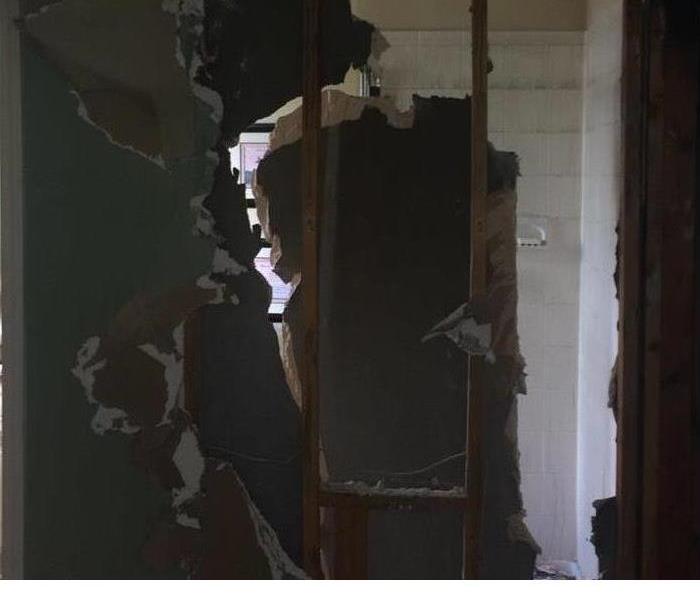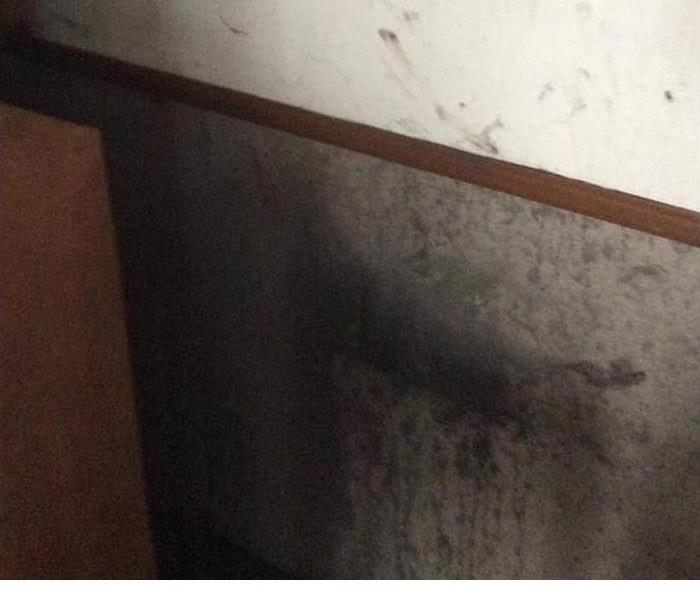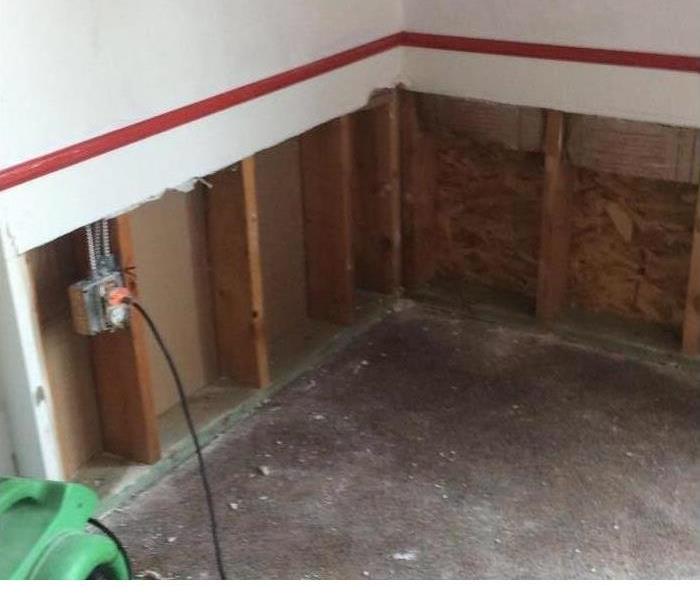Archived Blog Posts
Chemical Versus Non-chemical Drain Cleaners
11/19/2022 (Permalink)
When showering results in an unintended bath or your sink looks like a pond in Prairie Village, KS, it is fairly safe to assume that you have a clogged drain. Should you choose a chemical drain cleaner? What are the other options?
Chemical Drain Cleaners
Advertisements for drain and sewage cleaning lead consumers to believe that using chemicals to dissolve a clogged drain is best. However, this may not always be the case.
• Cleaners use acid, oxidizing, or caustic chemicals to create heat, which in turn breaks down the built-up materials. Once the clog has weakened, the materials such as hair, fats, oils, and grease are flushed down the pipe.
• There are negatives to using these types of cleaners. First, the clog may get stuck further down risking a burst pipe and the need for a professional water restoration company. Second, chemicals are harmful to both the environment and people if touched or inhaled. Third, these cleaners can damage pipes especially if the pipes are old, plastic, or completely blocked.
Non-Chemical Drain Cleaners
When confronted with a slow-moving or blocked drain, there are safer yet efficient alternatives to consider.
• Mechanical options include a plunger or auger, commonly referred to as a snake, to unclog the problematic area. Using a snake is a fast-acting choice that results in the clog being pulled out of the drain completely or effectively pushed through.
• A biological option is an environmentally friendly enzymatic cleaner. This works best for shower clogs mainly consisting of hair, soap, and grease. The bacteria and enzymes typically dissolve the organic clog over the course of about 24 hours.
There is more than one method to deal with a clogged drain at your home in Prairie Village, KS. While a chemical cleaner may clear the clog, there are downfalls to using such a product. Homeowners may wish to consider more environmentally friendly mechanical or biological techniques instead. If none of these work, contact a professional.
Weather and Your Business: Understanding that Flooding May be the Least of Your Concerns
11/11/2022 (Permalink)
Weather and Your Business
Many building owners worry about flood damage, but a flood is not the only problem caused by storms. Storms produce a variety of elements that can be equally unfavorable to a property, and as a property owner or manager, you may want to be aware of each.
1. Water Damage
Floodwaters are only one type of water damage, and it is not the most common. Most damage stems from persistent leaks or holes in your roofline. These issues cause significant loss to occur over time. Leaks can cause the sagging of ceilings, rotting out of joists, and even the spread of molds and mildews. Additionally, while not necessarily storm-related, persistent leaks from pipes can cause the pipe to corrode and fail, resulting in a flood.
2. Hail Damage
While flood damage can be a threat, hail damage may pose a more imminent concern. Hail occurs when temperatures allow for rain to develop into large chunks of ice, sometimes resulting in baseball size masses. These pieces of ice can cause significant property damage, from broken windows to holes in your roofline. Inspecting your property after a hail storm should be a top priority.
3. Wind Damage
The most common cause of storm damage is the wind. Wind damage can peel back siding and roofing shingles, and it can launch random debris, like sticks and lawn ornament, making them volatile projectiles. Property managers should keep employees and clients clear of windows in high-wind situations.
4. Renovating the Damage
It may be wise for property owners to plan ahead. Some restoration companies in Leawood, KS, provide an emergency planning service for businesses. This service may include an initial analysis of your property and a customized plan for restoration and recovery in the event of a disaster.
Flood damage may be a concern for a property owner or manager, but storms can produce hail and high winds that can equally damage property. Water damage is the most common cause of property damage, but even that is not only caused by flooding.
How To Rid Your Home of Smoke Smells
10/28/2022 (Permalink)
How to Get Rid of Smoke Odors in Your Home
After a fire, your home will need some serious smoke cleaning to repair the damage. With a smell that intense, simply opening up the windows isn’t going to suffice. Professional odor remediation specialists in Overland Park, KS, can eliminate smoke odor in your home through the use of special techniques and equipment. Here are three examples of these techniques.
1. Air Filtration Devices
The most basic machine the professionals use is an industrial-strength version of the air purifiers you can buy at the store. An air filtration device with an activated carbon filter works by trapping odor molecules in the filter as the air flows through it. When these gases cannot escape, they deteriorate rapidly. The odor in the room is eventually neutralized.
2. Thermal Foggers
Thermal foggers use heat and deodorizing chemicals for the smoke cleaning process. They simulate the conditions that were present in the fire (i.e., heat and air pressure). Porous surfaces react to these conditions and absorb the deodorizers, just like they absorbed the smoke odor during the fire.
3. Ozone Machines
A third method for eliminating the smell of smoke in your home in Overland Park, KS, after a fire is through the use of ozone machines. Think of how the air smells outside right after it rains. The ozone machine mimics what nature does to purify the outside air. It produces molecules of ozone, also known as activated oxygen. The extra atom of oxygen in the ozone attaches to smoke particulates and breaks them down. After a while, the air smells fresh and clean because everything that was making it stink has been neutralized.
Smoke cleaning after a house fire involves more than just removing soot or smoke damage from the home or creating extra airflow. When you hire experts for odor remediation, they use equipment that actually eliminates the source of the smell so that it does not return.
The Most Effective Sandbag Alternatives
10/26/2022 (Permalink)
Sandbags can be heavy and messy to fill. Commercial property owners seeking more convenient ways to limit flood damage should consider one or more of the following sandbag alternatives.
Absorbent Materials
Some materials are designed to absorb fresh or flood water and act as barriers. Several styles for absorbent flood control are currently available:
- Crystallized polymer
- Powder-filled barriers
- Self-inflating sand-less bags
These porous flood dams are intended for one-time use and should be disposed of after each flood event. All of these options are easier to deploy than sandbags.
Water-Filled Barriers
Filling a water barrier can be easier than filling a sandbag. There are several different styles of water-filled barriers to choose from:
- Baffle systems
- Cofferdams
- Modular blocks
- Tube designs
These designs are available in a wide range of sizes. Unlike some flood control materials with fillers that become contaminated, these barriers can be reused multiple times.
Self-Stabilizing Barriers
Self-stabilizing barriers are easy to use to keep flood waters away from a structure. Some of these options are better suited for blocking entrances or windows, while others can be set up in longer runs to keep flood water out of a larger area. Most of these designs can be reused many times.
Levee Machines
Machines are also available to quickly fill bags with sand. The same materials used to make sandbags are needed, with the exception of a shovel. It will also be necessary to either hire or train a crew to safely use this machinery prior to a flood.
All of these sandbag alternatives are relatively easy to use. A property owner may want to invest in a reusable flood prevention solution to limit the amount of water that enters a commercial structure in Leawood, KS. If water breaches the barriers and causes damage, contact a flood damage mitigation and restoration company.
What To Do After a Fire: 3 Steps
10/13/2022 (Permalink)
What to Do After a Fire: Three Steps
Lining up a plan after your building has experienced fire can seem like an enormous burden. Setting aside time to deal with such a mess probably wasn't on your schedule, and it can be difficult to juggle the cleanup process alongside your own work. No matter how serious the situation is looking, fire restoration doesn't have to take over your life; instead, follow these steps to ensure everything gets back to normal.
1. Make the Calls
After emergency procedures have been set into motion, tasks that follow usually include a call to your insurance agency. Your fire insurance coverage will depend on your policy and the extent of the damage. You may also want to get in touch with a fire damage specialist who can give a thorough inspection of the building.
2. Steer Clear
A fire can affect the materials of your building in a number of ways, so it's important that you refrain from touching any of the damage prior to the smoke cleaning process. Boarding up the property is one way you can protect the interior from looters or extreme weather. Plywood is the most commonly used material to board up windows and doors after a fire.
3. Begin the Restoration
You may have already brought in the help of professionals to board up your building in Leawood, KS, but it's key that you get a proper cleanup as well. The pros will have the appropriate equipment to clean the fire effectively – so you won't have to deal with lingering smoke damage in the future. The same goes for any water damage that might have occurred.
When starting the fire restoration process, you're likely adding one more responsibility to your long line of daily work duties. Check off that box on the to-do list and hand the hard work over to the specialists.
How Accurate are Mold Testing Kits?
10/6/2022 (Permalink)
Mold Testing Kits: How Reliable Are They?
If you are curious whether mold is growing in your home, you may be considering a DIY mold test. It is possible to predict the outcome of one of these consumer mold tests without acquiring the kit or knowing anything about conditions in your residence. Mold spores are present in every home. This is why you should hire a certified environmental hygienist to perform mold testing and identify which type of mold is present in your home, as well as any risks.
• Home testing kits pick up various traces of mold present in your home. These kits are not as accurate as trained mold testers and may not reveal the extent of mold contamination.
• The presence of airborne mold particles is not as serious as actively growing mold colonies. Mold testing kits can return positive results for types of mold that are not at problematic levels or points in the growth cycle.
• The results of a DIY test are not as trustworthy as a professional mold test. Breathe easier knowing that the results of a professional test are more accurate than a home mold kit. Insurance companies also prefer to work with certified professionals.
• An environmental hygienist can give you definitive answers regarding mold in your home. A DIY test may heighten concerns without providing the information you need to resolve the issue. A hygienist can recommend containment and cleanup strategies.
Rather than wasting time and money on DIY testing, contact a certified mold remediation service in Prairie Village, KS. Experts can administer precise mold testing, provide detailed analysis, and identify the causes and effective cleanup methods. A consumer mold kit may seem more affordable in the short run, but you are likely to receive results that don't provide you with a clear plan of action and may end up costing more than an accurate professional diagnosis in the long run.
The Best Tips for Water Mitigation
10/6/2022 (Permalink)
When you have a leaking water heater, it doesn’t take long for your Overland Park, KS, home to go from high and dry to a soggy mess. A failed water heater can come from many sources, but one thing is inevitable; once it goes south, it’s dragging your home down with it into the depths of a flooded house. So how do you handle the issues from a broken water heater?
Focus on Safety First
Unless you’re an expert plumber, installation technician, and electrician, you likely won’t have the skills to repair your hot water heater. Instead, you’ll need help from an outside specialist, but while you wait for help there are a number of things you can do to prevent further damage and ensure safety when dealing with a leaking water heater.
• Shut off the water. Prevent further leakage by shutting off water to the damaged hot water heater.
• Shut off the gas and/or electricity. Whether your hot water heater is gas or electric, damage can lead to a dangerous situation with the power source. Make sure to shut it off.
• Determine any electrical or other safety hazards. Water and home appliances often don’t mix, and it’s likely you have power outlets and/or appliances near your hot water heater. Make sure, before you enter the room, that there are no issues with standing water and exposed electrical outlets or cords. Use rubber gloves and make sure you’re grounded before touching any plugs or cords. Avoid stepping in standing water that may be in contact with electrical sources.
• Dry the area as thoroughly as possible. This should be done as quickly as possible to prevent water damage that can lead to waterlogged structures and black mold.
• Remove any waterlogged items. You may have to dispose of anything that’s been waterlogged enough to go sour or start to grow mildew or mold. One leaking water heater can lead to a host of other secondary damage issues.
3 Tips To Reduce the Risk of a Kitchen Fire
8/29/2022 (Permalink)
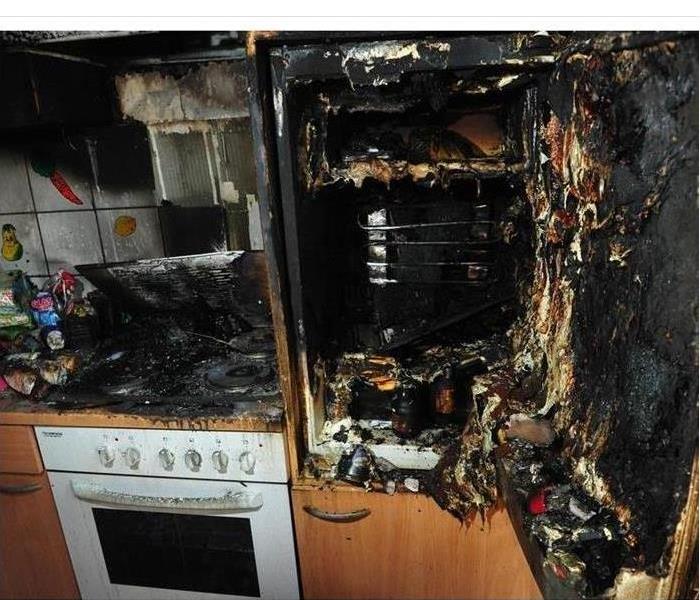 Kitchen fire in Leawood, KS
Kitchen fire in Leawood, KS
Three Tips That Will Help You Avoid A Fire While Cooking
Kitchen fires are the most common cause of house fires. Here are three helpful tips to help homeowners and residents avoid starting a fire while cooking and minimize the risks associated with kitchen appliances such as the cooktop or range in a home kitchen located in Leawood, KS.
1. Always Monitor Cooking Food
It is easy to lose track of time when you step away from the stove or oven. For this reason, it is advisable to make an effort to stay in the kitchen or delegate this responsibility the entire time you are cooking over an open flame. If you must leave the room, always set a timer that you can hear anywhere, and be sure to check back frequently.
2. Be Careful With Hot Oil
One of the most damaging types of kitchen fires is a grease fire. Many types of hot cooking oil can catch fire independently between 750 to 800 degrees Fahrenheit with a flashpoint around 600 degrees. One of the most important tips for putting out grease fires is to try dousing these extra-hot blazes with baking soda or salt or depriving the flames of oxygen with a metal pan or lid rather than using an extinguisher, which may cause the fire to spread.
3. Check Cooktops and Ranges
Homeowners should make sure that no combustibles such as cookbooks, loose-leaf printed recipes, or towels are stored too close to the stove. If flames shoot up or start to spread, the severity of fire damage will rapidly escalate if flammable items are nearby.
These tips address the leading causes of kitchen fires. Always practice fire safety by avoiding overloading circuits and identifying exposed wiring that could start an electrical fire at a home in Leawood, KS. Taking fire safety precautions has the potential to reduce personal safety risks and minimize the severity of fire damage.
Do You Need Business Interruption Insurance?
8/20/2022 (Permalink)
As a business owner, you know that insurance can save you in extreme circumstances. Business interruption insurance is no different. It encompasses the costs associated with keeping your business afloat when trying to rebuild after an unexpected event. Find out if you need this type of insurance in Prairie Village, KS.
What Is Business Interruption Insurance?
Business interruption insurance protects a temporarily closed business. Most commercial property owners know that property insurance is a necessity, but have you considered the potential costs of a temporary shutdown? Also known as business income insurance, this type of coverage doesn't deal with the physical rebuild of your business. For this, you need a trustworthy damage remediation team.
However, it does help with inevitable financial issues to keep you afloat. Being forced to close due to a disaster event can impact the costs associated with running a company. Some of the aspects that business income insurance can help with include:
- Employee pay
- Property taxes
- Loans
- Property rental fees
- Temporary relocation fees
- Training on new equipment
- Lost income
If your business comes to a halt, you won't be able to bring in as much income, if any. Based on your net income in previous months, this coverage can reimburse you, among other things.
What Should You Consider When Purchasing?
As with all insurance, there are aspects to consider before purchasing. Before signing up, you should assess:
- Budget constraints
- Natural disaster probability
- Age and reliability of structures
- Ability to operate without a physical location
Of course, with digital innovations, some businesses can survive a bit better by moving things online. You need to consider how well your business can handle a disaster, and adjust accordingly.
How Much Does It Cost?
The price of business income insurance will vary depending on a variety of factors. Some of these are:
- Size of business
- Industry-related risks
- Coverage limit selected
You can determine how much coverage you would need in the event of needing to close for a while. Have this at the ready when selecting business interruption insurance. However, this insurance can be a saving grace when times get tough.
Mold Inspection Before Buying a Building
8/15/2022 (Permalink)
Before purchasing a building, buyers typically have it inspected. This alerts the buyer of any structural damage or other problems that can impact the decision to buy the property or the price they are willing to pay. During this process, a mold inspection can be conducted to determine if the building has a mold problem.
Where to Look
Mold can be found in many different locations within a building:
- Air ducts or HVAC systems
- Basements or other areas that have that tend to be damp
- Bathrooms
- Kitchens
- Ceiling tiles
- Near leaking pipes
While the buyer may be able to spot visible mold on their own, a professional building inspector will be able to identify more subtle signs and check the area more thoroughly.
High-Risk Buildings
Some buildings have a higher risk of mold presence than others. If the building you are considering purchasing has a high risk of mold, you should definitely have a mold inspection performed before buying it.
Mold grows in warm, moist environments. Buildings that have experienced flooding, leaking pipes or sewage backup should be considered high risk. Humidity should also be considered. Very humid climates allow moisture to accumulate in buildings, leading to mold growth. When deciding if you want the building inspector to check from mold, keep these high-risk factors in mind.
Hazards
A building with a mold problem poses significant risks that must be addressed immediately. Mold can damage building materials, such as wood, and threaten the structural integrity of the building. If this is the case, a mold remediation service in Leawood, KS, should remove the mold and repair any damage immediately. They should also treat the area with a disinfectant to prevent the spread of toxins.
Conducting a mold inspection before purchasing a building can save you a lot of money in repairs later on. Discovering a mold problem early helps ensure the safety of the building and its inhabitants.
How To Prepare for an Insurance Adjuster's Visit
7/29/2022 (Permalink)
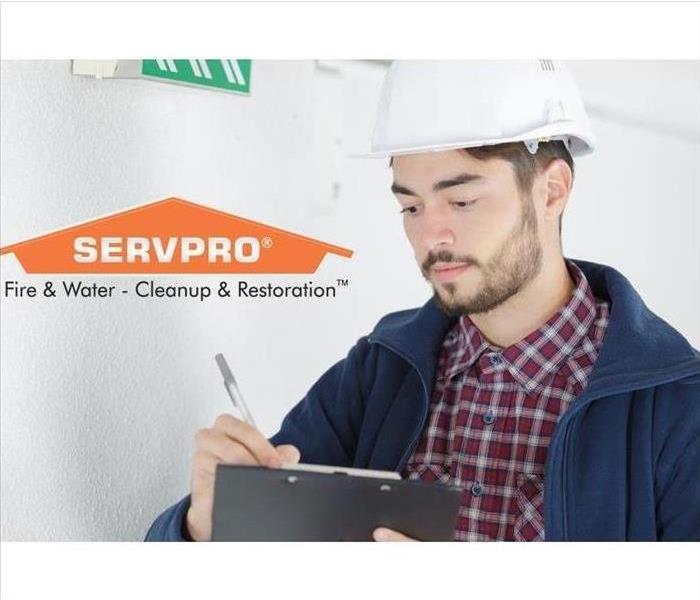 The Insurance Adjuster works closely with our team from start to finish
The Insurance Adjuster works closely with our team from start to finish
When a homeowner suffers from devastating damage to their property, there are many issues to handle. During the process, a home adjuster must assess the damage to determine the value of the destruction. The assessment includes the costs of repair and cleanup, as well as any necessary restoration. To make the process go smoother, there are some valuable preparations to consider.
What Preparations Are Important Before the Adjuster Arrives?
Call your insurance agent as soon as possible after the event to make sure the damage is covered under your homeowner's policy. There may be an insurance claim filing deadline, so ask about that as well. Many other preparations are important to receive a fast response.
Make a list of all damaged and destroyed belongings and furniture. If possible, include the approximate age of each item and the cost to replace it. Take pictures of the damage as well, because it's important for the home adjuster to review the damage at the time of the catastrophe.
If the house is safe to occupy, inspect the structure thoroughly. Look for cracks in the drywall and ceiling, and make a note of each damaged structure.
Before you submit the damage list and any receipts, make a copy for your records.
Request repair bids from licensed contractors in Overland Park, KS. These bids will speed up the claims process.
To protect your home from additional destruction, remove damaged furniture from the house. Keep it in the garage or outside, however, because the adjuster will need to examine it. If the damage is extensive, call an emergency restoration service right away.
It's critical to remember that flood damage is excluded under a general homeowner's policy. The federal government offers a separate policy for flood insurance claims.
The more preparations you take before the home adjuster arrives, the quicker your claim will be processed. This will help you get your house back to its original condition as soon as possible.
5 Reasons You Might Have Mold
7/29/2022 (Permalink)
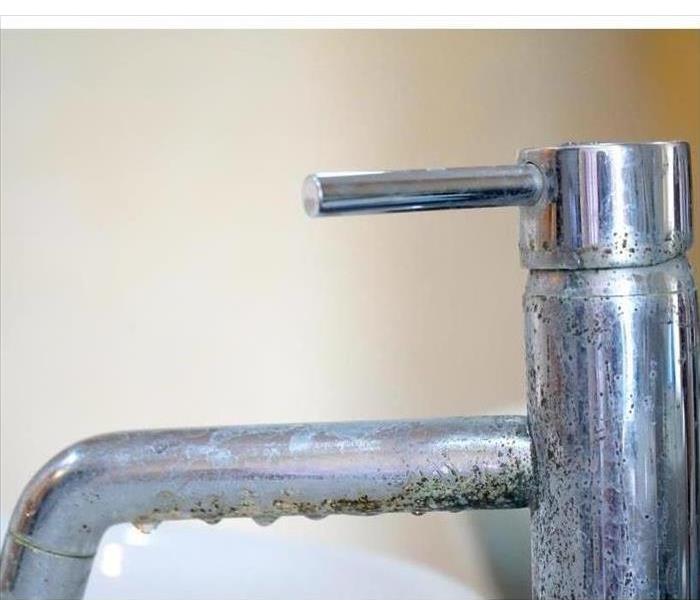 Mold grows in unvented bathrooms, around leaky pipes, and underneath sinks with damaged seals.
Mold grows in unvented bathrooms, around leaky pipes, and underneath sinks with damaged seals.
Don't Let Black Mold Invade Your Home
Mold is a persistent organism that can grow just about anywhere in your Leawood, KS, home. Black mold is much more likely to appear in areas that come into frequent contact with water, or places that have just suffered some form of water damage. If you're unsure what exactly is causing your mold problem, you might want to look into the following possible causes.
1. Your Home's Humidity Is too High.
Higher humidity levels can lead to a buildup of condensation, that eventually causes mold growth. This additional moisture in the air can become trapped in your carpeting, walls, ceilings and other locations. You can prevent this issue by ventilating your home properly or investing in a dehumidifier.
2. You Left Damp Items Inside.
Chances are, you've forgotten to hang up a load of laundry after washing at least once or twice. While this is an easy mistake, it can have potentially disastrous consequences. Black mold only needs about 24 hours to begin growing, meaning that the pile of damp clothes you left out for a day or two could be the root of your issue.
3. Your Roof Is Leaking.
Smaller leaks are easily overlooked, but that doesn't mean that they can't wreck havoc on your home. The water that seeps in through the leak can become trapped in your ceiling or attic, eventually resulting in a moisture problem that causes unwanted mold growth.
4. You Recently Suffered a Home Flood.
Flooding, unfortunately, coincides with plenty of secondary damage. You might think that your problems are over after you clean up the water, but the mold issues have only just begun. It's a good idea to contact mold cleanup professionals, as well as flood remediation experts, whenever your home suffers extreme water damage.
5. You Have a Leaky Pipe.
Along with driving your water bill through the roof, a leaky pipe can cause disastrous amounts of mold damage. It doesn't take a ton of additional moisture to invite mold growth, so that persistent drip might be more dangerous than you think.
Don't let black mold invade your home. Contact mold remediation professionals immediately after you discover the problem.
How To Replace a Toilet
7/19/2022 (Permalink)
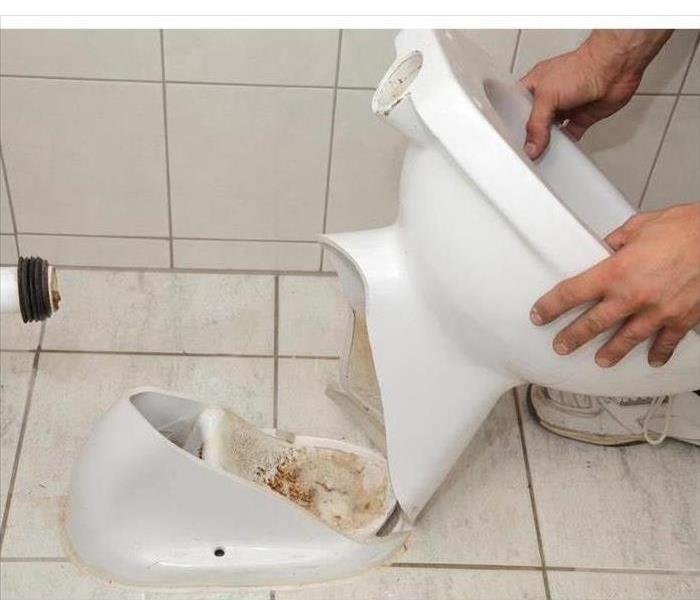 Remove the old toilet.
Remove the old toilet.
How To Replace a Faulty Toilet
If you find you have a leaking toilet, it is best to fix it as soon as possible to avoid further damage. You may wonder how to get your business in Prairie Village, KS, back to normal with minimal impact on your bottom line. Luckily, there are a few steps you can take to easily replace a faulty toilet.
1. Turn Off the Water
Be sure to turn off the water before beginning any work. The shutoff valve is usually located on the floor or wall behind the toilet. Turning this knob in a clockwise direction will stop the flow of water coming into the tank.
2. Soak Up the Water
Before removing the leaking toilet, get rid of the water by flushing and holding down the handle until no more water is passing through the bowl. Use a cup to dip out any water that is pooled in the old toilet and then soak up any remaining water with a sponge.
3. Remove the Old Toilet
Loosen the compression nut attached to the shutoff valve and then disconnect the water supply tube. Remove the caps and nuts from the closet bolts. Once the toilet has been set free, gently rock it back and forth to release any seals and then pull up on the bowl.
4. Install the New Toilet
Insert a new wax gasket over the closet flange. Carefully set the new toilet over the new gaskets while holding onto the seat hinges. Use the closet bolts to help guide the toilet into the right place. Push down on the toilet while tightening the bolts. Your toilet repair will be done once you replace the bolt caps, reattach the supply hose, and turn the water back on.
A leaking toilet can be more than a nuisance. Over time, it can cause water damage that can ruin floors or seep into subfloors, baseboards, or walls. If you have experienced water damage, you can hire a professional water remediation company to disinfect and restore your building to its previous condition.
How To Stay Safe During a Flood
6/22/2022 (Permalink)
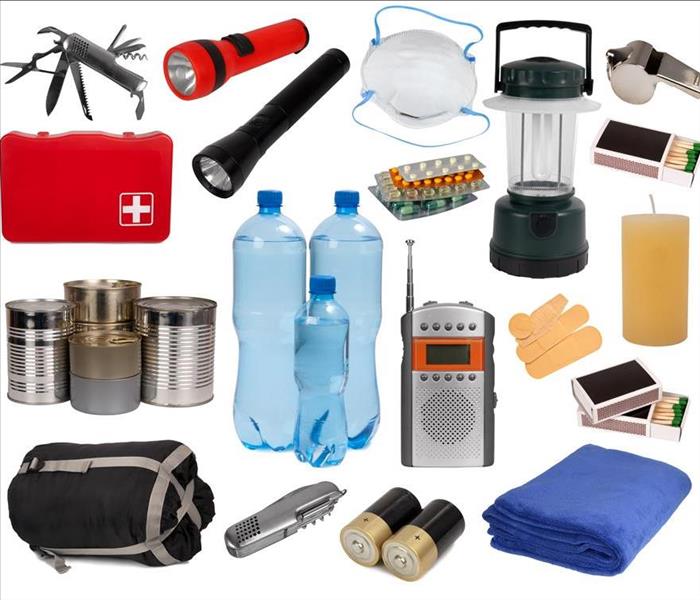 Plan ahead by assembling a portable flood preparedness kit
Plan ahead by assembling a portable flood preparedness kit
Flood Safety Guidelines
Flooding poses risks to residents of Overland Park, KS, as well as first responders. The following flood safety guidelines are helpful when preparing for flood conditions.
Follow Evacuation Orders
Residents should stay apprised of flooding risks and prepare to evacuate as soon as an order is issued. Plan ahead by assembling a portable flood preparedness kit that includes the following items:
- First aid kit
- Non-perishable food
- Water
- Flashlights and batteries
- Sleeping bags
- Jumper cables
- Flares
If a homeowner plans to stay at home, he or she should gather most of these items and store a home preparedness kit above the anticipated flood level. Stock up on enough food and potable water for several days.
Protect Yourself
Flood water may contain chemicals, heavy metals and pathogens. People should avoid drinking or making direct contact with this water. One of the most essential flood safety measures involves exercising caution near moving water. A person can easily lose his or her footing in six inches of moving water and vehicles may float in 12 inches of water.
Tips for First Responders
First responders should take additional precautions. Here are three of the best safety tips:
- Avoid electrical components
- Get immunized
- Wear personal protective equipment
Responders can reduce electrocution risks by avoiding downed power lines and making sure that the electricity has been shut off in any flooded structures they enter. Exposure to disease is another preventable risk. The Center for Disease Control recommends a tetanus booster for all disaster relief workers and the Hepatitis B vaccine for medical care providers. Relief workers should wear insulated and watertight electrical hazard boots, hip waders, waterproof work gloves, and eye protection. Respirators may also be necessary.
These flood safety suggestions can help to keep residents and first responders safe. Homeowners should contact a damage mitigation and restoration company if flood waters breach residences located in Overland Park, KS.
3 Steps To Keep Your Pet Safe In a Fire
6/12/2022 (Permalink)
 Notify rescuers that you have pets inside your home with window clings.
Notify rescuers that you have pets inside your home with window clings.
Three Ways To Keep Your Pets Safe In the Event of a Fire
In emergencies, pets rely on their owners to protect them from harm. Taking preventative measures and coming up with a pet preparation plan will help pet owners in a fire. Be prepared for a fire emergency at your Prairie Village, KS, home and keep your pets safe by following the steps below.
1. Include Pets In Your Evacuation Plan
When making a plan for you to leave your home in the case of a fire, make sure your pets are a part of the evacuation. Decide who in your household is going to retrieve your pet, and practice escaping with your animals. Determine in advance where they will stay while you have professionals restore your home after the fire.
2. Ensure Pets Are Located In a Fire Emergency
Keep pets near an accessible entryway when you are not home. This will help firefighters locate your pet in the event of a rescue. Make sure your pet is wearing a collar with identification tags and that a leash is nearby, further helping officials safely remove your pet from a fire.
Additionally, you can notify rescuers that you have pets inside your home with window clings. The signs let firefighters know how many pets are inside the house, so they can make sure they are keeping all of your animals safe.
3. Protect Important Pet Documents
Store your pet’s vaccination records and any pet ownership documents in a firebox. In the event of a fire, your important paperwork will be kept out of harm’s way and can be retrieved after your home has been deemed safe.
Protecting your pets in a fire emergency is a priority for any pet owner. While you never want to put yourself in danger to rescue your animals, keep pet safety in mind when preparing in advance for a potential home fire.
The 411 on Mold: Important Things To Understand About Spore Growth
6/5/2022 (Permalink)
 Spores are always present.
Spores are always present.
Four Things To Know About Mold Spores
What is black mold, and why should business owners in Leawood, KS, even have it on their radar? These little microscopic spores are fairly common in society, usually lurking about invisible and harmless. Under the right conditions, though, they prove quite troublesome. Not only do they infest structures, but they spread like wildfire, making a small problem something quite large. Proprietors, therefore, should know what it is and how to prevent it. Here are four things to know about the fungus.
1. They Are Not Contained With Chemicals
If you're thinking of spraying some bleach around the building to handle that pesky mold cleanup, think again. The chemical is a surface cleaner, only useful for eliminating spores on non-porous substances. When water damage occurs, spores can penetrate deep into porous objects.
2. They Feed on Moisture
Black mold reacts to fluid. When the property is dry, it is unlikely to cause problems. Wipe up puddles immediately, avoid leaks and keep the humidity low.
3. They are Decomposers
In nature, the microbes act as a natural decomposers, tasked with breaking down old pieces of wood. It's useful in keeping the cycle of life; however, in a damp building, the spores' actions could lead to foundation and structural issues.
4. They Are Always Present
Spores are always present. They come inside in people's shoes and clothing. They even move through the wind, migrating into the business via the windows, doors and vent system. It's troublesome to owners only if there is a moisture problem. Just be aware that the more exposure, the more spores may inhabit the space.
Try to have mats for people to wipe their shoes. Clean and vacuum the floors regularly, and have the vents cleaned out periodically. You could even look into a UV light for the air handler.
Black mold is around you; it's Mother Nature's helper. The spores become bothersome when water lingers, triggering reproduction. To prevent the fungus from harming your property, business owners should prevent and mitigate water damage.
4 Things To Do When Making a Water Damage Insurance Claim
5/23/2022 (Permalink)
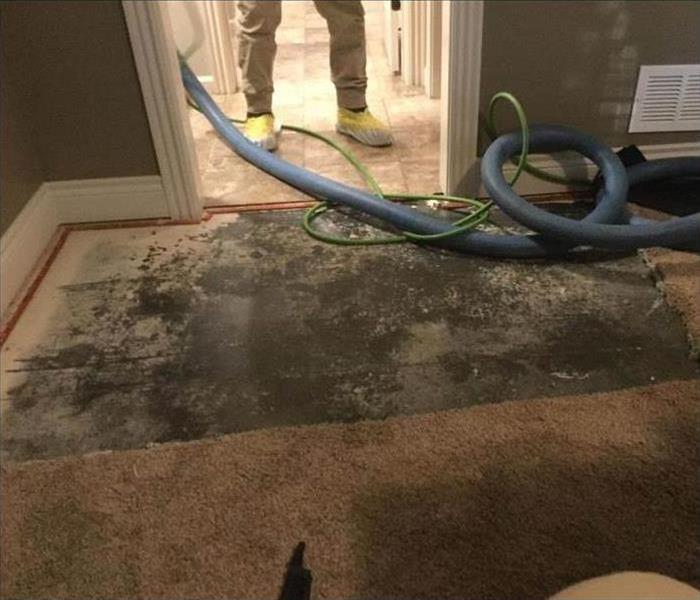 Water damage in a home in Overland Park, KS.
Water damage in a home in Overland Park, KS.
Water Damage Insurance Claim
If your home has been damaged during or after a storm in Overland Park, KS, then you will likely need to make an insurance claim. If this is not something that you have done before, then the process can be overwhelming. Taking the following steps will help you get through it more easily.
1. Call Your Insurance Agent
One of the first things you should do is contact your insurance agent to start your insurance claim. This will get things moving in the right direction. Some companies have a limit for how long you can wait to make a claim, so the sooner you do this, the better.
2. Read Over Your Policy
Most people don’t have their insurance policies committed to memory. If it has been a while since you’ve looked over yours, take time to do this while you wait for an insurance adjuster to inspect your home. Make sure you know what is covered and what is expected of you.
3. Document the Flood Damage
An insurance adjuster will need to inspect your house, but that doesn’t mean that you have to sit around and wait for them. In the meantime, you can take pictures of damaged areas and belongings to give to the adjuster. It can also be helpful to make a list of affected items and their values. Gather relevant receipts if you have them.
4. Start the Mitigation Process
Water damage from severe weather or a pipe burst can quickly get worse if it is not removed right away, leading to a lengtheir restoration process. A professional remediation company can begin mitigation and repairs even if you are still waiting for an adjuster. They can also help you document the damage if necessary.
Dealing with damage to your home can be stressful, but filing an insurance claim doesn’t need to be difficult. Starting the process as soon as possible and familiarizing yourself with your policy can save you time and energy. Address any damage right away, even if you are still waiting for an adjuster, to make repairs easier.
Understanding Smoke Damage and Insurance
5/17/2022 (Permalink)
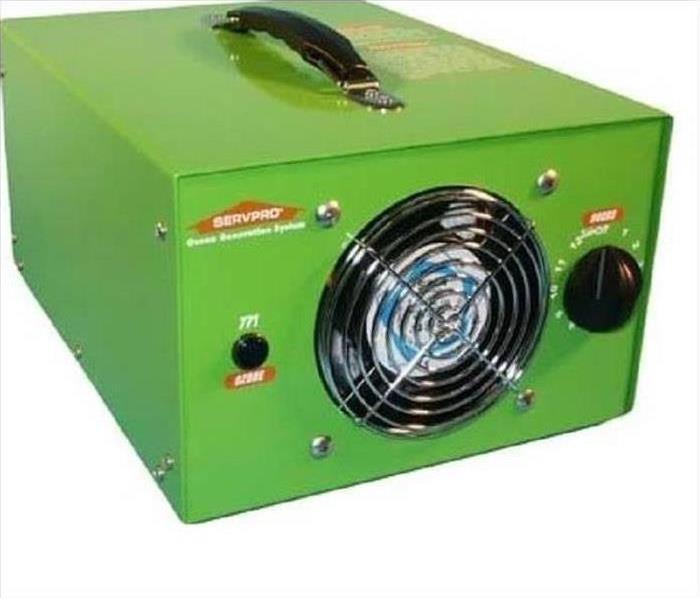 An ozone generator emits ozone gas that physically changes molecules and breaks them down.
An ozone generator emits ozone gas that physically changes molecules and breaks them down.
Smoke Damage and Insurance
While it may not be visible like soot damage, smoke damage is a strong, lingering issue. If your business is dealing with the issue, even if the fire was from a neighboring property, your commercial insurance will likely cover it, but it can be a tricky process.
Steps To Take
Once the damage is detected, there are essential steps that need to be taken to improve your chances of the claim being accepted and processed quickly.
Immediately contact your insurance provider. If you wait to report smoke damage, it may delay the claim and result in more downtime.
Have a clear understanding of your unique policy. Look over coverage, exclusions, deductibles, and filing requirements.
Document the damage by taking pictures and videos.
Maintain records of any expenses incurred due to the damage.
Contact a professional fire damage restoration company to have the damage assessed and a remediation plan set in motion.
Smoke Cleaning Methods
Since smoke odors are tricky, cleaning smoke requires industrial-grade tools and expertise. When choosing a certified restoration company, you get peace of mind that the air quality in your business will be restored. Three methods used to eliminate odors include:
Thermal Fogging: This is a heated deodorizer that neutralizes odors by attaching to smoke particles and absorbing them. It is an efficient way to ensure hard-to-reach areas are cleaned.
Ozone Generator: Used for decades, this generator emits ozone gas that physically changes molecules and breaks them down.
Hydroxyl Generator: Hydroxyl is gaining popularity because it breaks down particles and turns them into carbon dioxide and water, making it a people-friendly method.
If your business has sustained smoke damage, it is a problem that will linger if not properly treated. Immediately addressing the issue and working with your insurance and a restoration specialist makes it easier to get back to business.
Understanding Commercial Insurance
5/11/2022 (Permalink)
 Do you have Commercial Insurance coverage?
Do you have Commercial Insurance coverage?
Commercial Insurance: An Overview
If you own commercial property in Overland Park, KS, the chances are that you have a commercial insurance policy. It protects you in the event of a disaster that causes damage to your building or land. However, if you haven't reviewed your policy in a while, it can be good to brush up on what it covers.
Commercial Insurance Definition
An insurance policy for your property helps pay for perils that affect your business. These can include:
- Theft
- Natural disaster
- Fire
- Vandalism
You may also have other types of coverage, such as commercial liability insurance. They are often bundled together.
Property Insurance Coverage
If your company property experiences a peril, your coverage helps pay for expenses related to the peril. If you have a building that sustains fire damage, for example, you can have several types of damage. The fire itself can cause destruction, but so can heat, smoke, soot and water.
Your insurance policy helps pay for professional restoration services, repair and remodeling of your building, and replacement of assets such as furniture, fixtures, inventory and equipment.
Flood insurance is a separate type of coverage that is not included in commercial insurance policies. It's a good idea to talk to your agent about flood insurance to find out what coverage you require.
Cost of Property Insurance
What you pay for insurance depends on the location of your property, the type of weather your area experiences, and the type of assets and inventory in your building. If your business is in an area known for natural disasters, your premiums are probably higher than those in a location with milder weather.
It's a good idea to shop around for insurance. Different companies offer different policies and discounts. If you haven't reviewed your policy in a while, take the time to call your agent and review your coverage before you need it.
How to Protect Your Personal Belongings From Fire Damage
4/26/2022 (Permalink)
Defend Your Personal Property Against Fire
Protecting your personal belongings from fire damage is crucial to ensure the safety of your home and your loved ones. Here are some tips to help you protect your personal belongings from fire damage:
Install smoke detectors and fire alarms: Smoke detectors and fire alarms are the first line of defense against fires. Make sure you have working smoke detectors and fire alarms in every room of your home, and test them regularly.
Keep flammable items away from heat sources: Keep flammable items like curtains, furniture, and paper products away from heat sources like fireplaces, heaters, and stoves.
Store flammable liquids properly: Flammable liquids like gasoline, lighter fluid, and paint thinner should be stored in a cool, dry place away from heat sources.
Use surge protectors: Use surge protectors to protect your electronics from electrical fires. Make sure you use surge protectors with built-in circuit breakers.
Have a fire extinguisher: Keep a fire extinguisher in your home and make sure you know how to use it. Make sure the fire extinguisher is easily accessible and up to date.
Create a fire evacuation plan: Have a fire evacuation plan in place in case of a fire. Make sure everyone in your household knows the plan and where to meet outside the home.
Invest in fire-resistant storage: Consider purchasing fire-resistant safes or storage containers for important documents and valuables.
Maintain your home: Regularly maintain your home to prevent fires. This includes cleaning out your dryer lint trap, inspecting electrical wiring, and having your chimney cleaned.
By following these tips, you can help protect your personal belongings from fire damage and ensure the safety of your home and family.
Preventing Mold After a Flood
4/16/2022 (Permalink)
After a Flood, How to Keep Mold at Bay
After a flood, it's important to take quick action to prevent mold from growing in your home. Here are some steps you can take:
Remove any standing water: Use pumps, wet vacuums, or buckets to remove any standing water in your home. The longer water sits, the greater the chances of mold growth.
Dry out your home: Open doors and windows to let in fresh air, and use fans and dehumidifiers to help dry out your home. Aim to get the humidity level below 60%.
Remove any wet materials: Remove and dispose of any wet carpets, rugs, furniture, or other materials that can't be thoroughly dried within 48 hours.
Clean and disinfect: Clean all surfaces with a mixture of water and detergent, and then disinfect them with a solution of 1/4 cup bleach per gallon of water. Be sure to wear gloves and protective eyewear when cleaning with bleach.
Prevent future moisture: Seal any leaks in your home's roof, walls, or foundation. Install and use exhaust fans in bathrooms and kitchens. Consider using a dehumidifier to keep humidity levels low.
Monitor for mold growth: Keep an eye out for any signs of mold growth, such as a musty smell, discoloration on walls or ceilings, or visible mold growth. If you see any signs of mold, take immediate action to clean it up and address the underlying moisture problem.
Remember, preventing mold growth after a flood requires prompt action and ongoing vigilance. If you're not comfortable handling the cleanup yourself, consider hiring a professional mold remediation company to help.
Keeping Your Employees Safe During Mold Removal
4/11/2022 (Permalink)
Keeping Your Employees Safe During Mold Removal
Mold removal is a serious process that requires proper planning and precautions to ensure the safety of everyone involved, including employees. Here are some steps that can be taken to keep employees safe during mold removal:
Conduct a thorough risk assessment: Before starting the mold removal process, it's important to conduct a risk assessment to identify potential hazards and risks. This will help you develop a plan that minimizes the risk of exposure to mold and other hazardous materials.
Provide appropriate personal protective equipment (PPE): Employees should be provided with the appropriate PPE, including respirators, gloves, and protective clothing. The PPE should be properly fitted and used according to the manufacturer's instructions.
Ensure proper ventilation: Adequate ventilation is essential during mold removal to prevent the buildup of harmful airborne particles. This can be achieved through the use of fans and air filtration systems.
Train employees on proper procedures: All employees involved in the mold removal process should be trained on proper procedures for handling mold and PPE. They should also be trained on how to identify potential hazards and what to do in case of an emergency.
Monitor air quality: Regular air quality monitoring should be conducted during the mold removal process to ensure that the air is safe to breathe. This can be done using air sampling equipment or by hiring a professional air quality monitoring company.
Follow OSHA guidelines: Employers should follow the guidelines set forth by the Occupational Safety and Health Administration (OSHA) for mold remediation. This includes providing appropriate PPE, ensuring proper ventilation, and conducting regular air quality monitoring.
By following these steps, employers can help keep their employees safe during mold removal and ensure a successful remediation process.
Water Damage and Landscaping
3/30/2022 (Permalink)
Water Damage and Landscaping
Water damage can have a significant impact on landscaping. Depending on the severity of the water damage, it can cause erosion, soil compaction, and even plant death. Here are some ways water damage can affect landscaping:
Erosion: Heavy rainfall or flooding can cause erosion in the landscape, washing away soil and damaging plant roots. This can lead to uneven terrain and the loss of vegetation.
Soil compaction: Waterlogged soil can become compacted, making it difficult for plants to grow and thrive. This can also lead to poor drainage, which can cause further water damage.
Plant death: Excessive water can drown plants, causing them to die. It can also lead to root rot, which can kill plants over time.
To prevent water damage from affecting your landscaping, it's important to have proper drainage systems in place, such as French drains or rain gardens. These systems can help redirect excess water away from the landscape, protecting plants and preventing erosion. It's also important to choose plants that are well-suited to your climate and soil conditions, as this can help prevent plant death and damage.
Fire Restoration Process
3/23/2022 (Permalink)
Fire Restoration Process
Fire restoration is a process that involves several steps to clean up and repair a property damaged by fire. The following is a general overview of the fire restoration process:
Emergency contact: The first step is to contact a professional fire restoration company. They will assess the extent of the damage and recommend the necessary actions.
Inspection and assessment: The fire restoration company will then inspect the property to assess the damage. They will identify the areas that need immediate attention and create a plan to restore the property.
Secure the property: If the property is not safe to enter, the restoration company will secure it to prevent further damage or theft.
Water removal: If water was used to put out the fire, the restoration company will remove the water and dry out the affected areas.
Smoke and soot removal: The restoration company will use specialized equipment to remove smoke and soot from surfaces, furniture, and belongings.
Cleaning and sanitizing: All affected surfaces, furniture, and belongings will be thoroughly cleaned and sanitized.
Repair and reconstruction: The restoration company will repair and reconstruct the damaged areas of the property. This may involve replacing drywall, flooring, and other building materials.
Final inspection: Once the restoration is complete, the restoration company will conduct a final inspection to ensure that the property is safe and fully restored.
Move-in: Once the property is safe and fully restored, you can move back in and resume your normal activities.
It is important to note that the fire restoration process can vary depending on the extent of the damage and the type of property. It is always best to hire a professional fire restoration company to ensure that the restoration is done correctly and safely.
How To Dry Hard Wood Floors After a Pipe Burst in Your Office
3/11/2022 (Permalink)
Drying hardwood floors after a pipe burst in your office is crucial to prevent permanent damage to the wood and avoid the growth of mold and mildew. Here are the steps you can take to dry your hardwood floors effectively:
Turn off the water source: If you haven't already, turn off the water supply to prevent any further damage.
Remove standing water: Use a wet/dry vacuum or a mop to remove any standing water from the hardwood floor. Make sure to use a mop or cloth that is damp, not wet, to avoid saturating the wood.
Open windows and doors: Increase ventilation in the room by opening windows and doors to allow the air to circulate. This will help to speed up the drying process.
Use fans and dehumidifiers: Place fans and dehumidifiers in the room to help dry out the floors. Make sure the fans are pointed towards the wet area and the dehumidifier is set to a low humidity level.
Monitor the moisture level: Check the moisture level of the hardwood floor using a moisture meter. Continue drying until the moisture level is within a safe range.
Sand and refinish the floor: Once the floor is completely dry, sand and refinish it to restore its original look.
It's important to act quickly when dealing with water damage to hardwood floors. The longer the wood stays wet, the greater the risk of permanent damage and mold growth. If you're unsure of how to proceed, it's best to seek the help of a professional water damage restoration company.
How To Minimize Flood Damage to Your Business
2/18/2022 (Permalink)
 If you are having flooding issues and suspect storm or water damage, give SERVPRO a call on our 24-hour service line.
If you are having flooding issues and suspect storm or water damage, give SERVPRO a call on our 24-hour service line.
How To Reduce Flood Damage To Your Company
There is never a good time to deal with flood damage in Leawood, KS. Different types of flooding include burst pipes, flash floods, and sewage backup. They can be hard to prepare for and even harder to predict. Here are a few tips to ensure that you are doing the most you can to protect your property from disaster.
Act Now
Sometimes you won't have time to prepare your business before a storm hits. If your property experiences flooding, remember not to panic. You can avoid most of the damage with these steps:
- Stop the flow of water and turn off circuit breakers to reduce risk of injury.
- Call your storm damage restoration company immediately.
- Remove small furniture items, books, papers, and breakables to a higher floor or a dry room.
- Put cinder wood blocks under the legs of furniture to raise them above water level.
- Lift all cushions, rugs, drapes and other fabric items away from water, and set them outside to dry if needed.
- Place sandbags around doors and windows to divert running water and soak up standing water.
Prepare for the Worst
While the forecast can be erratic, one of the best ways to avoid heavy damage is to be prepared before a storm descends. Perform routine maintenance on the building to prevent water from pooling in areas. Make sure to clean out storm drains and patch holes in parking lots. Regularly inspect doors, windows and drains, and bring them up to code.
Keep an Updated Flood Action Plan
Having a flood action plan can help you get your business running right after a disaster. Keep yourself and your employees updated on weather forecasts and storm warnings. Have the numbers of insurance providers and emergency services in one place. Make an evacuation plan and perform drills regularly. Know how to locate all utility taps and circuit breakers and how to safely shut them off in case of a flood.
When you have a well-constructed plan, you will feel much better about handling a disaster such as flooding. Just because the weather can be unpredictable doesn't mean you shouldn't be prepared.
3 Ways a Restoration Company Can Help Adjusters and Their Clients
2/18/2022 (Permalink)
 SERVPRO can share important information with adjusters and homeowners and can make the claims process quicker and less costly.
SERVPRO can share important information with adjusters and homeowners and can make the claims process quicker and less costly.
Three Ways A Restoration Firm Can Assist Adjusters and Their Clients
An insurance adjuster often serves as a go-between for homeowners and insurance companies, providing both parties with information about the damage that has occurred. A restoration company can often help adjusters and homeowners throughout the process of restoring damaged homes in Prairie Village, KS.
1. Share Important Information
When a disaster occurs, communication between homeowners, adjusters and the restoration professionals is often essential A restoration company can provide adjusters and homeowners alike with relevant information about the approximate costs of restoring the affected areas and can also suggest a variety of solutions. Armed with helpful information about the state of the home and potential fixes, adjusters and homeowners can make informed decisions as they move forward in the claims process.
2. Quicken the Process of Making a Claim
The quality of a restoration company can greatly impact the time it takes to make an insurance claim. If a company takes a long time to begin assessing a home, this can increase the amount of time it will take for a claim to be made. Alternatively, a restoration company that is able to respond to a disaster in a timely manner can present findings to the insurance adjuster and homeowners, therefore allowing a claim to be made quickly and ensuring restoration can begin quickly as well.
3. Lessen the Costs of Claims
Whether a home has been impacted by a fire, mold growth or flooding, leaving a damaged home untouched can be a costly decision. Within hours of a disaster occurring, items within a home can become badly damaged, and the structure of a damaged home can become impacted soon after a disaster as well, ultimately increasing the cost of the claim. An experienced restoration company can often lower the cost of the claim by mitigating damage to personal belongings and to the structure of a home.
An insurance adjuster and homeowners can benefit from choosing a reliable restoration company after a home is affected by a disaster. SERVPRO can share important information with adjusters and homeowners and can make the claims process quicker and less costly.
3 Reasons To Hire Certified Water Damage Experts
2/17/2022 (Permalink)
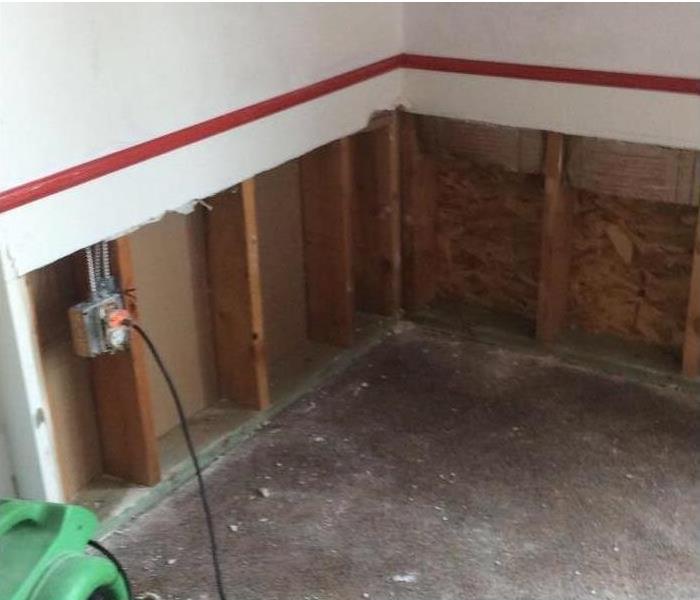 This business suffered from water loss after a leak. The team at SERVPRO responded and began mitigation. Call us when you need it!
This business suffered from water loss after a leak. The team at SERVPRO responded and began mitigation. Call us when you need it!
Three Reasons To Hire Water Damage Experts
Certified companies that specialize in water cleanup are likely to hold an Institute of Inspection Cleaning and Restoration Certification, a Commercial Structure Drying credential, or a Mold Remediation certification.
The standards for these credentials are set by experts in human health and structural restoration. Here are three reasons why you should hire a certified water damage expert if you experience a broken pipe, leaky roof, or sewer flooding.
Insurance companies are more likely to cover the costs of certified commercial restoration. Insurance companies typically trust certified professionals to perform water cleanup and damage repair work more quickly and with greater success than services without up-to-date cleaning and restoration certifications.
Certified companies are also more likely to guarantee their work.
Certified experts can work efficiently after water damage. Every second counts when you are dealing with water damage. Regardless of the source of the leak, it is important to remove standing water and to clean, dry, and dehumidify the parts of a commercial property affected by a leak as quickly as possible. Significant damage can occur and mold may begin to develop in 24 to 48 hours if experts do not complete drying and cleaning procedures.
Less secondary damage occurs when certified experts follow best restoration practices. Just as mold is less likely to develop if the affected area is quickly dried and cleaned, the extent of water damage to building materials or content may be less severe if experts arrive on the scene in a timely manner.
If your commercial property in Overland Park, KS, has experienced water damage, you should call a certified water damage restoration service to schedule water cleanup as soon as possible. Check the website of the service you are thinking about hiring or contact the company by phone to find out which cleaning and restoration certifications it holds.
Protection After a Fire: Safeguarding Your Business Assets
1/28/2022 (Permalink)
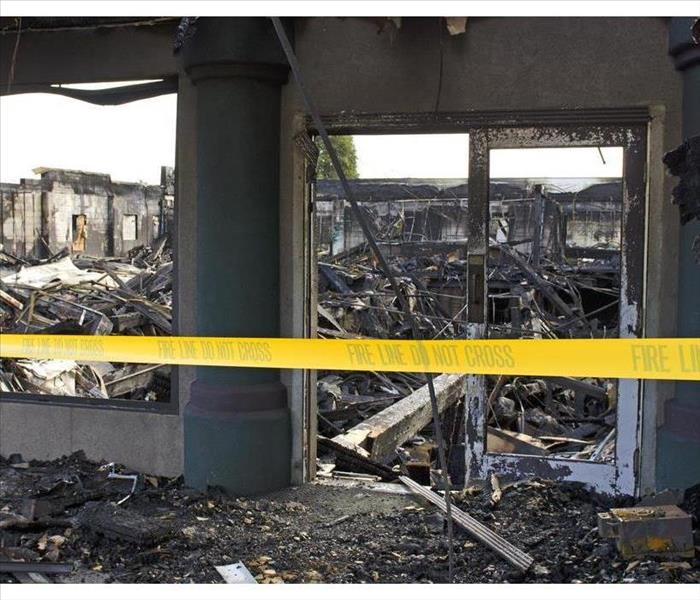 Commercial fire damage in Overland Park, KS.
Commercial fire damage in Overland Park, KS.
Ways To Protect Your Commercial Facility After a Fire
Suffering a fire in your Overland Park, KS, commercial property is one of the worst disasters you can face. The fire damage is bad enough, but unfortunately, the situation can be further darkened by looting. You can prevent both events from completely destroying your company by planning ahead. A fire restoration company skilled in fire cleanup may provide board-up services for buildings ravaged by a blaze. By securing the remaining structure in this and other ways, you help safeguard inventory and equipment from would-be thieves looking to profit from your misfortune. Here are ways to protect your commercial facility after a fire.
• Cover all openings. It is easy to feel overwhelmed in the aftermath of a fire, so turn to professional restorers who offer immediate services for boarding up windows and missing walls and placing tarps on damaged roofs. This can protect assets inside the structure and guard against future damage while providing security to the vulnerable facility. It also can give you a little peace of mind during a trying time.
• Talk to the fire department. Utilities in your building—electricity, water and gas—may be unsafe to use. Make sure to ask the fire department before everyone leaves. If the services are not safe, firefighters may have to turn them off.
• Inform law enforcement. Let the police know your building has burned and is vacant, and request security patrols to discourage looting.
After the fire is extinguished, these steps can help you recover from fire damage.
A Last Word on Post-Blaze Protection
Fire damage to property, equipment and inventory is enough of a nightmare for business owners and managers without looting compounding the situation. Damaged walls, roofs and missing windows also let in the elements, which can cause further destruction. Many responsible companies are in contact with experts in fire cleanup, but they may not know these same professionals may offer immediate board-up and tarp placement services to minimize damage and make a dark situation a little lighter.
The Pros and Cons of HEPA Filters for Air Purification
1/28/2022 (Permalink)
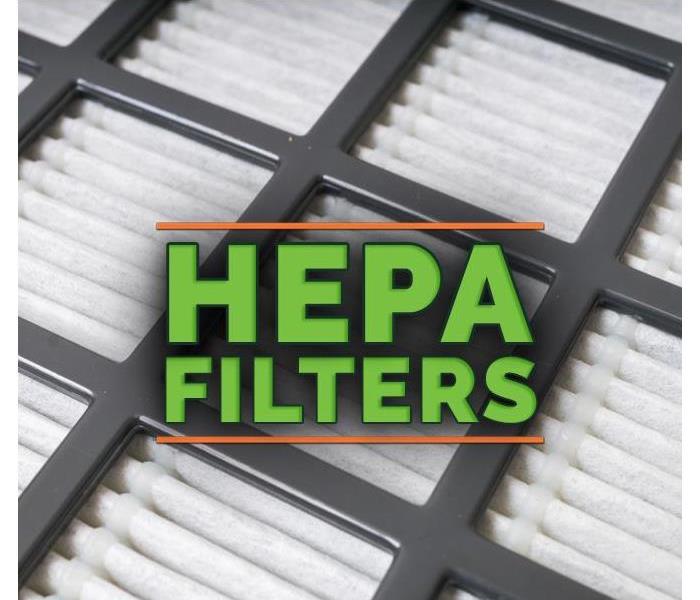 An air purifier with a HEPA filter cleans the air of mold by catching particles that are in your home.
An air purifier with a HEPA filter cleans the air of mold by catching particles that are in your home.
The Advantages and Disadvantages of HEPA Filters in Air Purification
By now, you’ve likely heard of the benefits of using air filtration in your home located in Leawood, KS, to prevent mold growth that has made its way into the air you breathe. Individuals often choose to use air purifiers that are equipped with HEPA (High Efficiency Particulate Air) filters to rid of mold spores floating around. While HEPA filters are often very efficient at completing this purpose, they can become problematic if not cared for properly.
Applications of HEPA Filters
HEPA filters are used in multiple different settings including:
- Home purifiers
- Vacuum cleaners
- Hospitals
- Airplanes
- Tesla Model X
How a HEPA Filter Works
An air purifier with a HEPA filter cleans the air of mold and other small particles in a building. These filters are effective 99.97 percent of the time since they can only catch particles that are 0.3 microbes are larger. However, a large majority of spores are between 1 to 30 microbes in size, so only unusually small particles get through the HEPA filter undetected.
The Cons of a HEPA Filter
While a HEPA filter is considered to be an effective means of air filtration, there are a couple of cons to consider:
• When not cleaned regularly, mold can grow on your HEPA filter and be emitted into the air
• Unlike some other types of filters that are able to kill mold, HEPA filters only trap them.
• A HEPA filter cannot trap very small mold spores.
When a HEPA Filter Isn’t Enough
It is important to note that an air purifier only removes mold spores from the air inside your home. It does not tackle mold growth problems within your home. To address a serious mold issue, you will need to contact a mold restoration specialist.
No one wants to have mold spores floating around in their home, which is why air filtration is beneficial. HEPA filters are especially effective at purifying your air. Just make sure you replace them regularly to avoid unnecessary mold growth, to keep your family safe!
If you notice any mold, give us a call and we will help you to eliminate the growth of mold in your home.
How To Maintain a Sump Pump
1/11/2022 (Permalink)
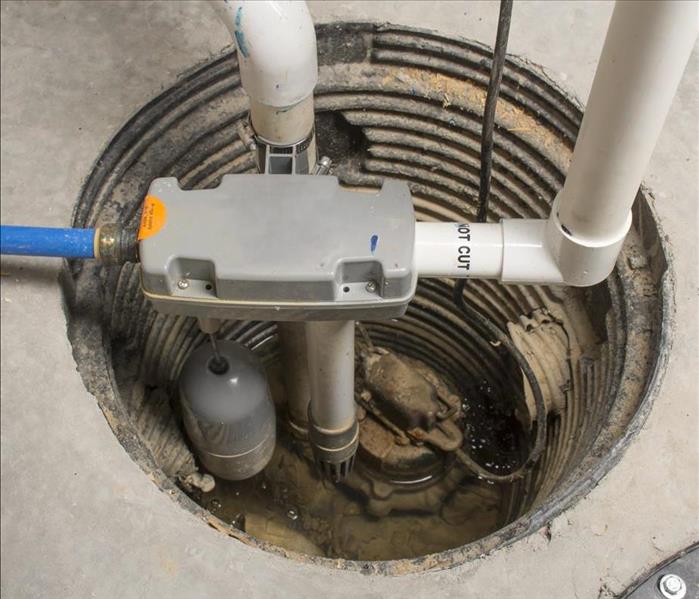 A sump pump can help to remove water from your home.
A sump pump can help to remove water from your home.
Sump Pump Maintenance Measures
Homeowners depend on sump pumps to prevent water from accumulating in basements or crawl spaces. These pumps cannot work without a power source and functional, unobstructed components. Perform the following pump maintenance measures several times a year to ensure that the sump pump in your home will function properly in the event of a flood.
Check Power Sources
Sump pumps should have primary and emergency backup power sources. Test both to ensure that the pump will work regardless of whether the power is on.
- Make sure the pump is plugged into a functional ground fault circuit interrupter, or GFCI, outlet.
- Check the power cord for damage.
- Replace a backup battery at least every two to three years.
These measures can keep the pump in your home running reliably and safely.
Clear Debris
Debris may accumulate in several parts of a sump pump. Clear clogs when you perform pump maintenance.
- Check the intake screen for blockages and remove debris.
- Clear out the pit and make sure the float is functional.
- Eliminate obstructions in the discharge pipe and vent hole.
Dirt, gravel, and other types of debris can force a pump to work overtime to drain the basin. This will put more stress on the pump machinery and increase the risk of an overflow.
Test the Pump
Make sure the pump is working by filling a bucket with water and dumping it into the basin. The float should trigger the pump to activate, and the water should drain. If the pump does not activate, check the float and power source. Schedule a repair if you cannot determine the source of the problem.
A sump pump can help to remove water from the basement or crawl space of your home. Pump failure or malfunction can lead to flooding. Clean up and repair damage by hiring residential mitigation and restoration experts in Prairie Village, KS.
4 Steps To Make a Water Damage Claim
12/27/2021 (Permalink)
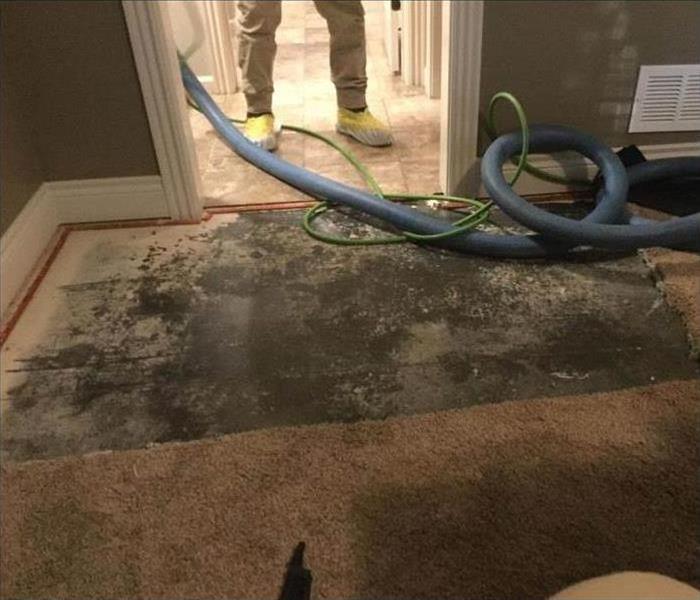 Water damage in Leawood, KS.
Water damage in Leawood, KS.
Filing An Insurance Claim
A water damage claim is more likely to be approved if a policyholder takes measures to document damage and gather important information. These four steps will guide a homeowner through the process of filing an insurance claim.
1. Review the Policy
It is important to know what a homeowner's insurance policy does and does not cover. Keep in mind that standard home insurance policies only cover water damage due to a pipe burst or leak. An endorsement is usually necessary for sewer backup coverage, and an additional flood policy is needed for damage caused by heavy rains or rising bodies of water.
2. Call Your Agent
Call your insurance agent and let them know about the extent of the damage. It is a good idea to determine whether it is likely that you will file a claim before calling. If the damage is minor and you want to avoid a rate increase, you may want to obtain an estimate from a mitigation service first and pay out of pocket. Some insurance companies require agents and adjusters to report potential claims.
3. Document the Damage
If you plan to file an insurance claim, you will need proof of damage. Capture the extent of the damage in photos or on video. This documentation may be even more useful if you also have dated footage of the residence before the damage took place. It is also useful to gather receipts, dates of purchase, and the prices of damaged contents.
4. Get an Estimate
Contact a water damage cleanup company to obtain an estimate of the total cost of mitigation and restoration. Providing this information to an adjuster can expedite the filing process.
These steps will guide you from determining what your policy will cover to filing an insurance claim. Obtain an estimate from a water damage mitigation and restoration company in Leawood, KS.
3 Things To Consider When Buying an Extinguisher
12/21/2021 (Permalink)
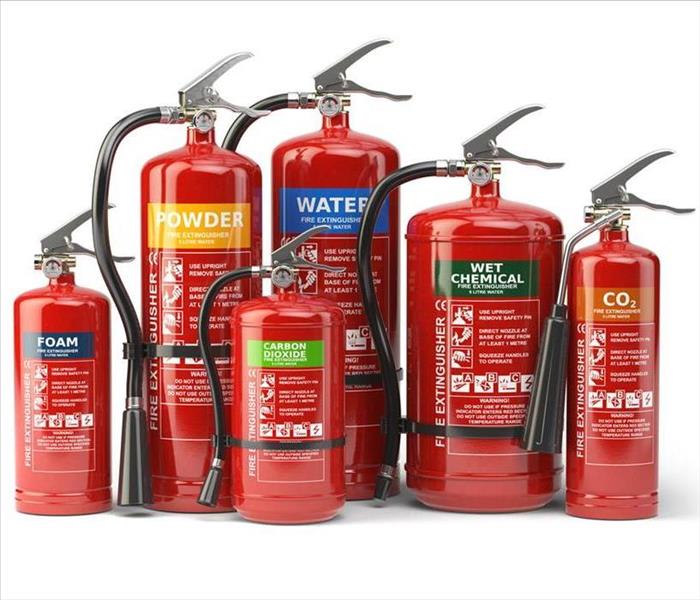 Having at least one fire extinguisher in your home is a great safety practice.
Having at least one fire extinguisher in your home is a great safety practice.
Three Things to Think About When Purchasing an Extinguisher
Having a fire extinguisher in your Prairie Village, KS, home can help you stop a house fire from becoming a disaster. To best protect your home, you need to buy the right extinguisher for the space. You can turn to a residential fire damage professional and this guide to help you choose the best product for your needs.
1. Where Will It Be Used?
Are you going to put the extinguisher in your garage, kitchen or laundry room? Believe it or not, the location of your extinguisher should actually dictate what product you buy. In the garage, for example, you may want a larger model because the home fire may grow before you notice it in this space. On the other hand, you may be able to use a smaller model in the kitchen where you'll typically spot fires before they grow out of hand.
2. What Kind of Flames Will It Fight?
Did you know that a fire extinguisher may be designed to fight a certain kind of flame? This safety equipment often comes labeled as A, B or C. The A category works well against common combustibles, including cloth, wood and paper. B extinguishers are often designed to tackle fires caused by cooking oils, gasoline or other liquids. The C products may help with electricity fires. As you purchase your tool, you need to think about the kind of fires that may take place in the room you want to keep it in.
3. How Easy Is It To Use?
Will anyone be able to use the extinguisher? A big part of fire preparedness is making sure everyone in your home can tackle an emergency situation. Purchasing an extinguisher that has an easy-to-use hose may make it easier for anyone in your family to dampen flames. It may be a good idea for you to include a how-to demonstration during your next family fire drill.
Having at least one fire extinguisher in your home is a great safety practice. Getting the best product for your space can increase the safety tool's usefulness.
Why Water Is Disastrous for Electronics
12/21/2021 (Permalink)
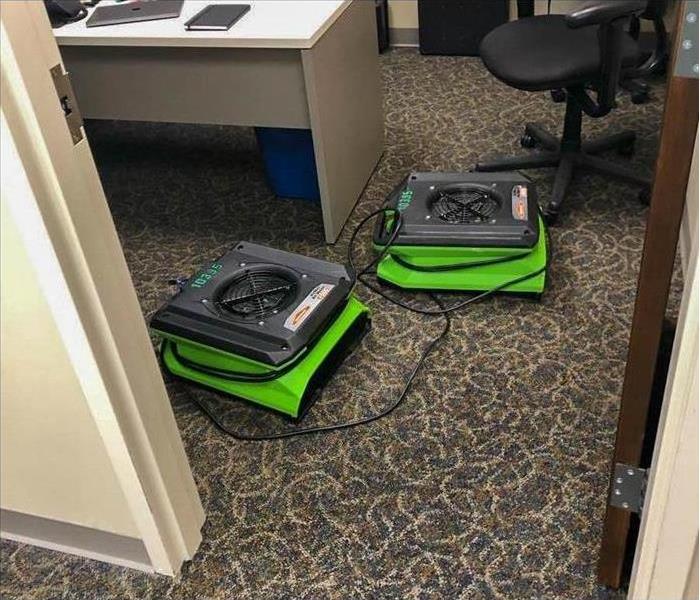 Commercial water restoration in Overland Park, KS.
Commercial water restoration in Overland Park, KS.
Why Water Is Disastrous for Electronics
Thriving businesses in Overland Park, KS, revolve around the use of electronics. You can imagine the panic that ensues when such valuable equipment is confronted with water. Most know that flooded electronics are difficult to revive, though you may wonder why.
What’s Inside Matters
There are many intricate pieces that make up the technology in a workplace; flooded electronics are not usually destroyed as a whole unit, but segment by segment. A variety of components can suffer irreparable damage when they become wet:
- Transformers
- Outlet and junction boxes or fittings
- Cables specified for dry locations
- Power equipment such as meters or override relays
- Devices in place to protect against surges
- Parts used for electrical distribution, such as switches, fuses, breakers or mylar wrapping
- Equipment used for motor control, such as transistors and semiconductors
- Any parts meant to work without interruption
These interior components are designed to make things go. When water permeates through protective barriers, it causes instant degradation to the working parts of a device, particularly pieces made of metallic conductor materials. Such elements need more than a chance to dry off; they need to be returned to their original condition, which is often impossible after electronic damage occurs.
Water Opens the Door to More Trouble
As if water doesn’t cause enough trouble on its own, it often ushers in debris, mold and rust to wreak additional havoc. While some electronics stand a chance after exposure to clean water, nearly all devices are vulnerable to contaminated water carrying dirt, oil or mixed particles. Once microscopic intruders break through the protective shells of office equipment, they settle and become impossible to remove, rendering devices unusable. In addition, the slightest amount of moisture can lead to the spread of fungus or oxidation leading to rust.
Rescuing flooded electronics from water is a sensitive endeavor, and far more complicated than drying dishes in the kitchen sink. Many devices—from cell phones, computers and printers to standard heating and cooling appliances—are essential to getting work done in a commercial environment. For that reason, it's always wise to contact a water damage repair company for assistance.
Chemical Versus Non-Chemical Drain Cleaners
11/19/2021 (Permalink)
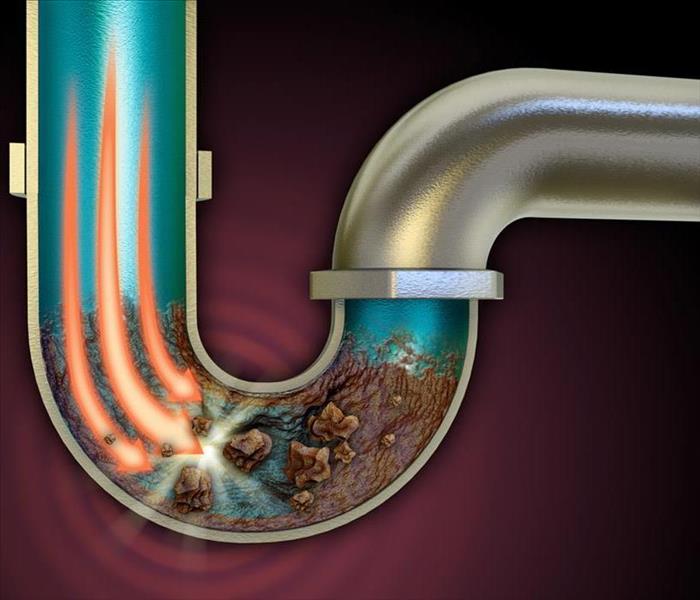 Should you choose a chemical drain cleaner?
Should you choose a chemical drain cleaner?
When showering results in an unintended bath or your sink looks like a pond in Prairie Village, KS, it is fairly safe to assume that you have a clogged drain. Should you choose a chemical drain cleaner? What are the other options?
Chemical Drain Cleaners
Advertisements for drain and sewage cleaning lead consumers to believe that using chemicals to dissolve a clogged drain are best. However, this may not always be the case.
• Cleaners use acid, oxidizing or caustic chemicals to create heat, which in turn breaks down the built up materials. Once the clog has weakened, the materials such as hair, fats, oils and grease are flushed down the pipe.
• There are negatives to using these types of cleaners. First, the clog may get stuck further down risking a burst pipe and the need for a professional water restoration company. Second, chemicals are harmful to both the environment and people if touched or inhaled. Third, these cleaners can damage pipes especially if the pipes are old, plastic or completely blocked.
Non-Chemical Drain Cleaners
When confronted with a slow moving or blocked drain, there are safer yet efficient alternatives to consider.
• Mechanical options include a plunger or auger, commonly referred to as a snake, to unclog the problematic area. Using a snake is a fast-acting choice that results in the clog being pulled out of the drain completely or effectively pushed through.
• A biological option is an environmentally friendly enzymatic cleaner. This works best for shower clogs mainly consisting of hair, soap and grease. The bacteria and enzymes typically dissolve the organic clog over the course of about 24 hours.
There is more than one method to deal with a clogged drain at your home in Prairie Village, KS. While a chemical cleaner may clear the clog, there are downfalls to using such a product. Homeowners may wish to consider more environmentally friendly mechanical or biological techniques instead. If none of these work, contact a professional.
3 Times Fires Aren’t Covered by Insurance
11/19/2021 (Permalink)
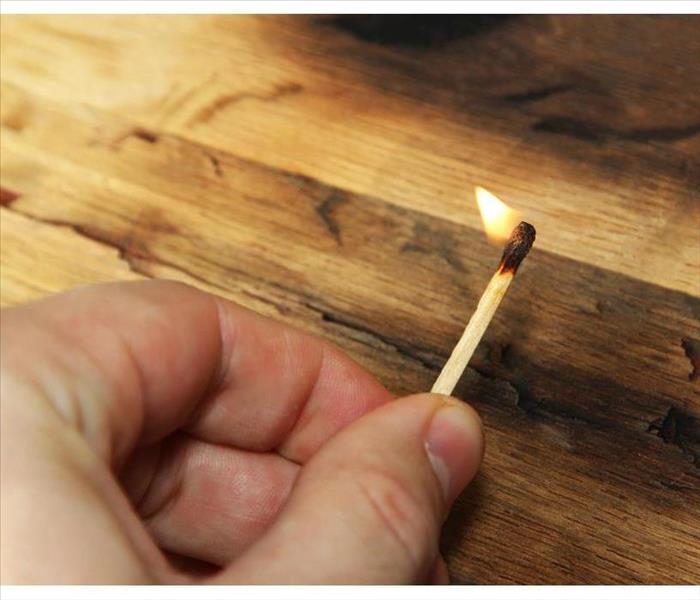 Arson fire
Arson fire
Insurance Doesn't Always Cover Fires
If you have experienced a home fire in your Overland Park, KS, home or want to be prepared if one should ever occur, you may be wondering if there are fires that are never covered by insurance. As a matter of fact, there are three types of fires that are not going to be covered by an insurance company to compensate for damage. Read on to learn what these types are.
1. Insurance Fraud
If you attempt to make a claim on a fire that was set deliberately to get insurance money for the incident, your insurance company will not cover it. An adjuster will thoroughly inspect your property for any suspicious evidence.
2. Arson
Insurance fraud as mentioned above is one kind of arson. A home fire that is purposely set either for a specific reason or due to a homeowner’s fascination with flames would fit this description. An insurance company will immediately deny coverage if anything the adjuster finds indicates foul play. Always take the high road and do not set a fire for unethical reasons.
3. Vacant Home
A vacant home fire will not be covered by your homeowners insurance. Generally speaking, if an insurance provider can prove that your home was vacant at the time of the fire and for 30 days prior to the occurrence, your claim will be denied.
A home fire cannot always be avoided; accidents happen. If your fire was completely unintentional and your home was occupied when it occurred, your claim should meet your policy’s coverage terms. It is still a good idea to check your policy documents and call your home insurance agent to make sure that you understand what types of coverage you have and what types you do not. He or she will also be able to explain the claims process and set you up for better success when seeking financial help for your loss.
Weather and Your Business: Understanding that Flooding May Be the Least of Your Concerns
11/11/2021 (Permalink)
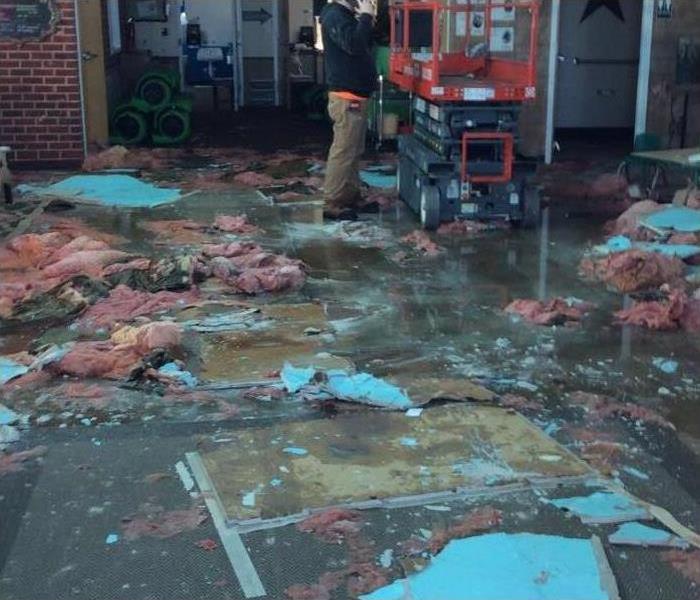 Commercial storm damage in Leawood, KS.
Commercial storm damage in Leawood, KS.
Weather and Your Business
Many building owners worry about flood damage, but a flood is not the only problem caused by storms. Storms produce a variety of elements that can be equally unfavorable to a property, and as a property owner or manager, you may want to be aware of each.
1. Water Damage
Floodwaters are only one type of water damage, and it is not the most common. Most damage stems from persistent leaks or holes in your roofline. These issues cause significant loss to occur over time. Leaks can cause sagging of ceilings, rotting out of joists, and even the spread of molds and mildews. Additionally, while not necessarily storm-related, persistent leaks from pipes can cause the pipe to corrode and fail, resulting in a flood.
2. Hail Damage
While flood damage can be a threat, hail damage may pose a more imminent concern. Hail occurs when temperatures allow for rain to develop into large chunks of ice, sometimes resulting in baseball size masses. These pieces of ice can cause significant property damage, from broken windows to holes in your roofline. Inspecting your property after a hail storm should be a top priority.
3. Wind Damage
The most common cause of storm damage is the wind. Wind damage can peel back siding and roofing shingles, and it can launch random debris, like sticks and lawn ornament, making them volatile projectiles. In high wind situations, property managers should keep employees and clients clear of windows.
4. Renovating the Damage
It may be wise for property owners to plan ahead. Some restoration companies in Leawood, KS, provide an emergency planning service for businesses. This service may include an initial analysis of your property and a customized plan for restoration and recovery in the event of a disaster.
Flood damage may be a concern for a property owner or manager, but storms can produce hail and high winds that can be equally damaging to property. Granted, water damage is the most common cause of property damage, but even that is not only caused by flooding.
15 - How To Rid Your Home of Smoke Smells
10/28/2021 (Permalink)
 Eliminate smoke odor from your home with an ozone machine.
Eliminate smoke odor from your home with an ozone machine.
How to Get Rid of Smoke Odors in Your Home
After a fire, your home will need some serious smoke cleaning to repair the damage. With a smell that intense, simply opening up the windows isn’t going to suffice. Professional odor remediation specialists in Overland Park, KS, can eliminate smoke odor in your home through the use of special techniques and equipment. Here are three examples of these techniques.
1. Air Filtration Devices
The most basic machine the professionals use is an industrial-strength version of the air purifiers you can buy at the store. An air filtration device with an activated carbon filter works by trapping odor molecules in the filter as the air flows through it. When these gases cannot escape, they deteriorate rapidly. The odor in the room is eventually neutralized.
2. Thermal Foggers
Thermal foggers use heat and deodorizing chemicals for the smoke cleaning process. They simulate the conditions that were present in the fire (i.e., heat and air pressure). Porous surfaces react to these conditions and absorb the deodorizers, just like they absorbed the smoke odor during the fire.
3. Ozone Machines
A third method for eliminating the smell of smoke in your home in Overland Park, KS, after a fire is through the use of ozone machines. Think of how the air smells outside right after it rains. The ozone machine mimics what nature does to purify the outside air. It produces molecules of ozone, also known as activated oxygen. The extra atom of oxygen in ozone attaches to smoke particulates and breaks them down. After a while, the air smells fresh and clean because everything that was making it stink has been neutralized.
Smoke cleaning after a house fire involves more than just removing soot or smoke damage from the home or creating extra air flow. When you hire experts for odor remediation, they use equipment that actually eliminates the source of the smell so that it does not return.
The Most Effective Sandbag Alternatives
10/26/2021 (Permalink)
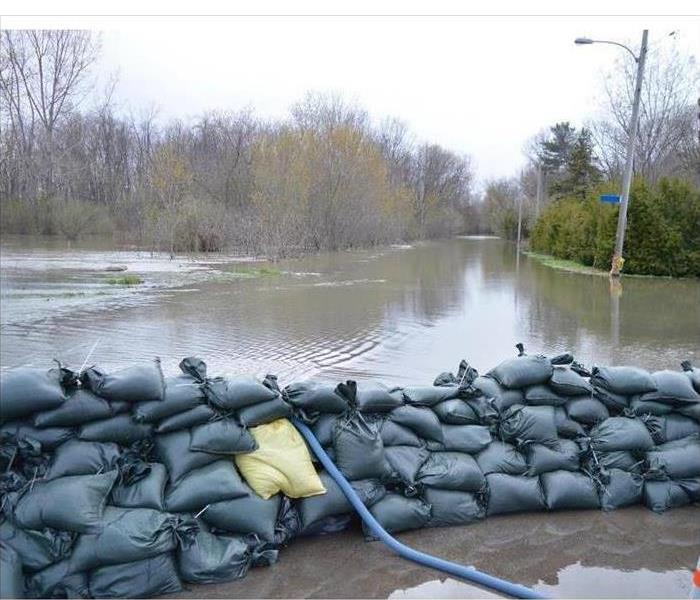 Sandbags for flood defense.
Sandbags for flood defense.
Sandbags can be heavy and messy to fill. Commercial property owners seeking more convenient ways to limit flood damage should consider one or more of the following sandbag alternatives.
Absorbent Materials
Some materials are designed to absorb fresh or flood water and act as barriers. Several styles for absorbent flood control are currently available:
- Crystallized polymer
- Powder-filled barriers
- Self-inflating sand-less bags
These porous flood dams are intended for one-time use and should be disposed of after each flood event. All of these options are easier to deploy than sandbags.
Water-Filled Barriers
Filling a water barrier can be easier than filling a sandbag. There are several different styles of water-filled barriers to choose from:
- Baffle systems
- Cofferdams
- Modular blocks
- Tube designs
These designs are available in a wide range of sizes. Unlike some flood control materials with fillers that become contaminated, these barriers can be reused multiple times.
Self-Stabilizing Barriers
Self-stabilizing barriers are easy to use to keep flood waters away from a structure. Some of these options are better suited for blocking entrances or windows, while others can be set up in longer runs to keep flood water out of a larger area. Most of these designs can be reused many times.
Levee Machines
Machines are also available to quickly fill bags with sand. The same materials used to make sandbags are needed, with the exception of a shovel. It will also be necessary to either hire or train a crew to safely use this machinery prior to a flood.
All of these sandbag alternatives are relatively easy to use. A property owner may want to invest in a reusable flood prevention solution to limit the amount of water that enters a commercial structure in Leawood, KS. If water breaches the barriers and causes damage, contact a flood damage mitigation and restoration company.
What To Do After the Fire: 3 Steps
10/13/2021 (Permalink)
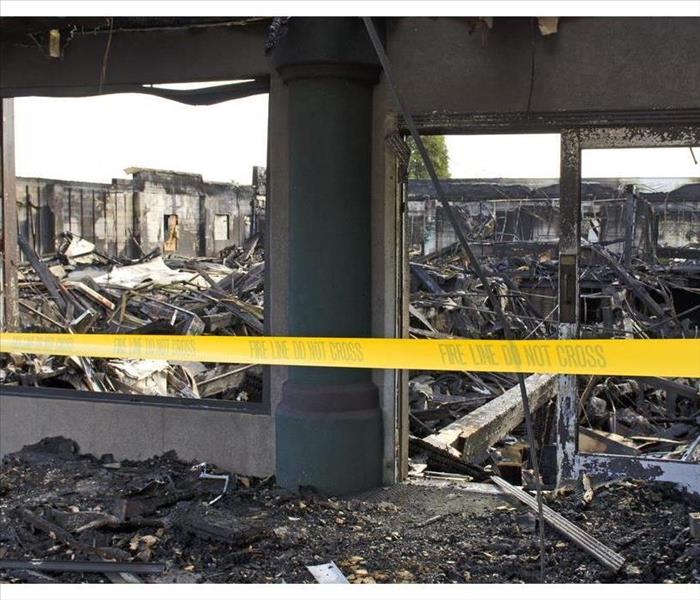 Commercial fire in Leawood, KS.
Commercial fire in Leawood, KS.
What to Do After a Fire: Three Steps
Lining up a plan after your building has experienced a fire can seem like an enormous burden. Setting aside time to deal with such a mess probably wasn't on your schedule, and it can be difficult to juggle the cleanup process alongside your own work. No matter how serious the situation is looking, fire restoration doesn't have to take over your life; instead, follow these steps to ensure everything gets back to normal.
1. Make the Calls
After emergency procedures have been set into motion, tasks that follow usually include a call to your insurance agency. Your fire insurance coverage will depend on your policy and the extent of the damage. You may also want to get in touch with a fire damage specialist who can give a thorough inspection of the building.
2. Steer Clear
A fire can affect the materials of your building in a number of ways, so it's important that you refrain from touching any of the damage prior to the smoke cleaning process. Boarding up the property is one way you can protect the interior from looters or extreme weather. Plywood is the most commonly used material to board up windows and doors after a fire.
3. Begin the Restoration
You may have already brought in the help of professionals to board up your building in Leawood, KS, but it's key that you get a proper cleanup as well. The pros will have the appropriate equipment to clean the fire effectively – so you won't have to deal with lingering smoke damage in the future. The same goes for any water damage that might have occurred.
When starting the fire restoration process, you're likely adding one more responsibility to your long line of daily work duties. Check off that box on the to-do list and hand the hard work over to the specialists.
Best Tips For A Leaky Water Heater
10/6/2021 (Permalink)
 Dry the area as thoroughly as possible.
Dry the area as thoroughly as possible.
Best Tips For a Leaky Water Heater
When you have a leaking water heater, it doesn’t take long for your Overland Park, KS, home to go from dry to flooded property. A failed water heater can come from many sources, but one thing is inevitable; once it starts to leak, if it goes unnoticed it has the potential of serious water damage. So how do you handle the issues of a leaky water heater?
Focus on Safety First
Unless you’re an expert plumber, installation technician, and electrician, you likely won’t have the skills needed to repair your hot water heater yourself. Instead, you’ll need help from an outside specialist, but while you wait for help there are a number of things you can do to prevent further damage and ensure safety when dealing with a leaking water heater.
• Shut off the water. Prevent further leakage by shutting off the water supply to the damaged hot water heater.
• Shut off the gas and/or electricity. Whether your hot water heater is gas or electric, damage can lead to a dangerous situation with the source of power. Make sure to shut it off to prevent further home damage.
• Determine any electrical or other safety hazards. Water and home appliances don’t mix, and it’s likely you have power outlets and/or appliances near your hot water heater. Make sure, before you enter the room, that there are no issues with standing water and exposed electrical outlets or cords. Use rubber gloves and make sure you’re grounded before touching any plugs or cords. Avoid stepping in standing water that may be in contact with electrical sources.
• Dry the area as thoroughly as possible. This should be done as quickly as possible to prevent water damage that can lead to waterlogged structures and black mold.
• Remove any waterlogged items. Best practice is to dispose of anything that’s been waterlogged that could start to grow mildew or mold. One leaking water heater can lead to a host of other secondary damage issues.
If your water heater leaks, call the professional to handle your water mitigation, remediation, and reconstruction. We will ensure to make it "Like it Never Even Happened".
How Accurate Are Mold Testing Kits?
10/6/2021 (Permalink)
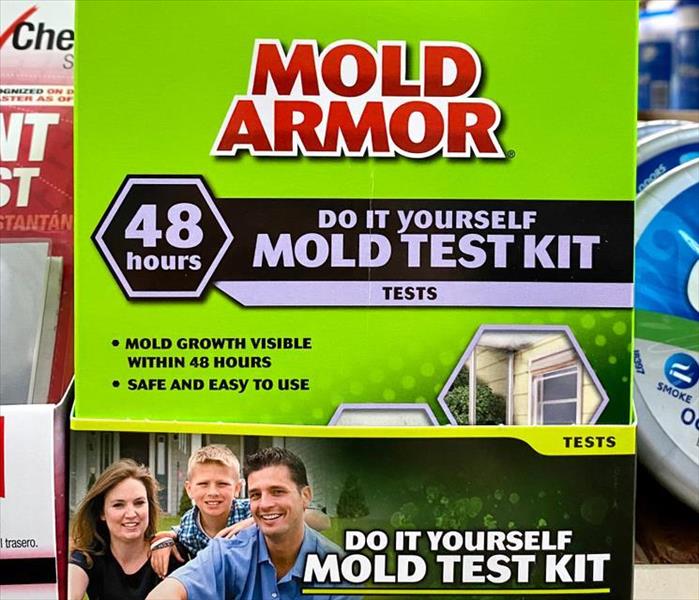 The results of a professional test are more accurate than a home mold kit.
The results of a professional test are more accurate than a home mold kit.
Mold Testing Kits: How Reliable Are They?
If you are curious whether mold is growing in your home, you may be considering a DIY mold test. It is possible to predict the outcome of one of these consumer mold tests without acquiring the kit or knowing anything about conditions in your residence. Mold spores are present in every home. This is why you should hire a certified environmental hygienist to perform mold testing and identify which type of mold is present in your home, as well as any risks.
• Home testing kits pick up various traces of mold present in your home. These kits are not as accurate as trained mold testers and may not reveal the extent of mold contamination.
• The presence of airborne mold particles is not as serious as actively growing mold colonies. Mold testing kits can return positive results for types of mold that are not at problematic levels or points in the growth cycle.
• The results of a DIY test are not as trustworthy as a professional mold test. Breathe easier knowing that the results of a professional test are more accurate than a home mold kit. Insurance companies also prefer to work with certified professionals.
• An environmental hygienist can give you definitive answers regarding mold in your home. A DIY test may heighten concerns without providing the information you need to resolve the issue. A hygienist can recommend containment and cleanup strategies.
Rather than wasting time and money on DIY testing, contact a certified mold remediation service in Prairie Village, KS. Experts can administer precise mold testing, provide detailed analysis, and identify the causes and effective cleanup methods. A consumer mold kit may seem more affordable in the short run, but you are likely to receive results that don't provide you with a clear plan of action and may end up costing more than an accurate professional diagnosis in the long run.
Picking up the Pieces: Steps To Take Right After the Storm
9/27/2021 (Permalink)
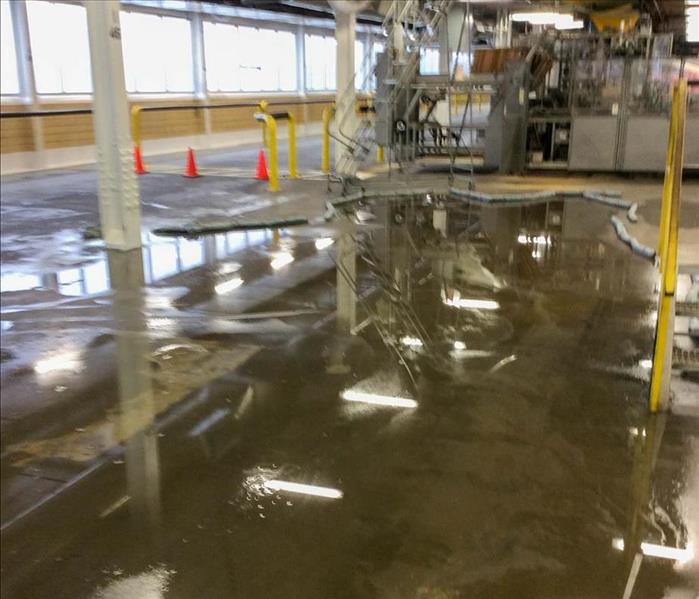 While these storm tips are broad and do not cover the extent of the restoration process, they are meant as a starting off point.
While these storm tips are broad and do not cover the extent of the restoration process, they are meant as a starting off point.
Storms are unpredictable, and they can leave you vulnerable in the one place that you’re meant to feel the safest, your home. Between heavy rains, high winds, and lightning, your home is susceptible to various levels of structural damage, and when the weather breaks the aftermath can be just as disheartening. Follow the three simple storm tips below to help ensure your safety and to get your restoration started on the right foot.
1. Ensure Your Safety
After a storm, it is most important to make sure that you and your family are safe. Storms can leave behind downed power lines, broken glass, and worse. The first thing you should do when a storm ends is to evaluate your surroundings and to get yourself to a safe location.
2. Call for Help
Depending on the damage to your home, you may want to seek assistance from restoration specialists in the Leawood, MO, area. Also, reaching out to your insurance company and asking about any storm tips or required steps they have for you is a good idea. Beyond the basics, if your area has been significantly damaged, you should find out if the government has declared it a disaster area. Designated disaster areas are eligible for disaster relief, meaning that you may be able to get assistance to restore your property.
3. Get Out Your Camera
Regardless of the level of storm damage, most insurance companies require proof of loss. While most insurers will send out a qualified adjuster to document your home, it may take weeks before an adjuster can get to you, especially after a significant storm. Taking pictures ensures that you have evidence of the immediate damage as well as allows you the opportunity to begin cleanup.
While these storm tips are broad and do not cover the extent of the restoration process, they are meant as a starting off point. These three tips, while simple, are easy to remember even after the disarray and shock of severe weather.
What You Need to Know About Home Sewage Backups
8/5/2021 (Permalink)
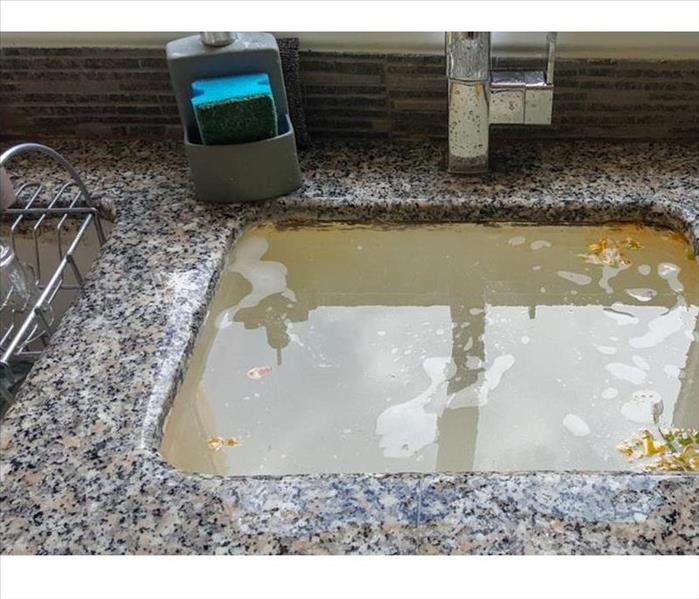 If your sink is overflowing that means you have sewage backup in your home.
If your sink is overflowing that means you have sewage backup in your home.
What You Should Know About Sewage Backups at Home
Sometimes a sewer system in Leawood, KS becomes overwhelmed, as in the case of a storm, and there isn't much you can do to stop it. There are often there are some subtle hints of the problem before it happens. Here are some things you should know about a storm-related sewer backup.
Increase Your Awareness
Sometimes rain is just too much and too fast, dumping large volumes of water on a sewer system. This is one reason that a sewer backup can happen in a home. The problem is compounded when the sewage system isn't operating at its best, but how do you know something is afoot? Well, be sure you don't dismiss some foretelling signals such as:
- Sewer gas odors
- Gurgling or bubbling in drains, sinks and toilets
Call a professional as soon as you notice these clues, so the next bout of rainwater doesn't cause a major backup. If you are on a septic tank, you most certainly are responsible for any maintenance, but call your local municipality first for a sewer line problem. It may be your responsibility depending on where the problem lies.
Clean the Mess
When you do have a sewage backup that contaminates your home, you need to make sure the cleanup is done carefully. The first step is always to solve the problem that led to the backup to prevent additional contamination in your home. "Black water" is the worst category of flood water because the flood has harmful bacteria and other pathogens. This kind of flood requires special cleaning.
A professional water remediation specialist can clean a sewer backup safely and effectively. They know porous materials are best removed and disposed, but they are also able to effectively clean other parts of your home with antimicrobials to keep your family safe from the contaminated water. Experts have access to specialized equipment and training to make sure your water damage is completely clean to prevent mold growth.
4 Steps To Take When You Find Mold in Your Rented Space
7/22/2021 (Permalink)
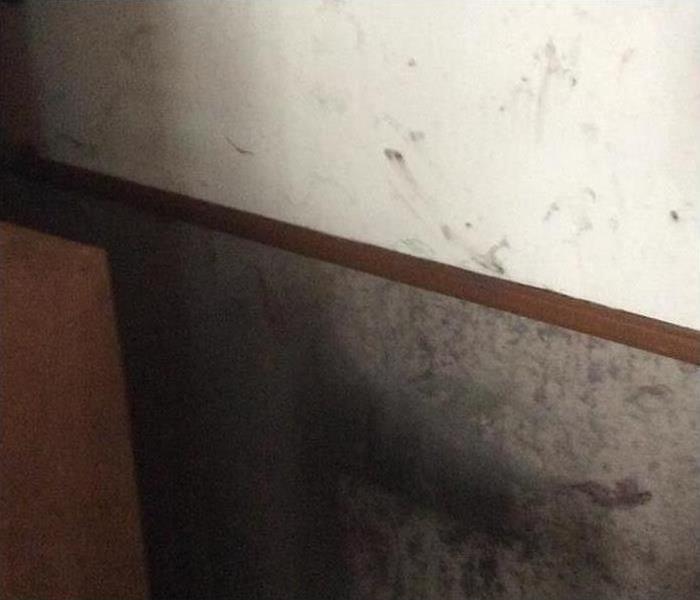 Mold damage in an Overland Park, KS building.
Mold damage in an Overland Park, KS building.
When You Find Mold in Your Rented Space, Follow These 4 Steps
There are few things that can throw panic into your day like finding mold in your Overland Park, KS, building. Evidence of mold colonies encroaching into your space is frustrating to you and the property owner. The key to resolving this problem efficiently and effectively is taking quick action.
1. Notify Your Landlord Immediately
Does your landlord respond best to a phone call or a text? Do you need to contact the property owner through the mail? Choose the method of contact that is sure to get the quickest response. After making contact, be sure to keep a paper record of your interactions. The landlord may be responsible for mold cleanup but could claim not to have known about the problem. Your paper trail protects you from becoming responsible.
2. Take Pictures of the Mold
A photographic record is beneficial for several reasons, such as giving your landlord important information to share with the insurance company and providing valuable information for remediation experts. The photos could also be included in your record of the situation. However, be careful not to disturb the area to avoid releasing any mold spores.
3. Prevent Further Growth or Spreading
One of the best ways to prevent mold colonies from developing is to quickly clean up water damage as soon as it occurs. Whether you found a leak around a toilet or a window swamp cooler has been dripping, you need to alert the property owner and take all necessary steps to correct the water damage. Your quick response will limit the amount of mold cleanup you have to do.
4. Stay Out of the Area During Testing
Once the landlord is alerted to the mold contamination problem, mold cleanup professionals will arrive to complete testing and provide remediation. The testing provides direction for remediation efforts. Once Overland Park, KS, professionals have completed their work, you can confidently return to your day-to-day activities.
5 Candle Safety Tips
7/21/2021 (Permalink)
 Situate candles with open flames at a safe distance from flammable materials.
Situate candles with open flames at a safe distance from flammable materials.
5 Safety Tips for Candles
Candles with open flames are a common cause of fires. Candle fires are most common during the holidays when more people use candles for decorative purposes. There are five safety tips that you can follow to reduce the risk of a candle fire in your home.
1. Limit candle use to the dining room table. Restricting the use of open-flame candles to the dinner table can help to ensure that more than one person watches lit candles. Be sure to blow out the candles when you clear the table.
2. Use candle alternatives in the bedroom. Bedrooms are the most common location for candle fires. People light candles and then fall asleep and leave them unattended. Try flameless alternatives for nighttime mood lighting.
3. Never leave children or pets unattended with a candle. Children or pets can easily play with candles and get hurt or knock over a lit candle and cause a candle fire.
4. Keep candles at least a foot away from combustibles. In addition to considering where a candle will look best, you should situate candles with open flames at a safe distance from flammable materials.
5. Try other mood lighting and fragrance solutions. From candle warmers that bring out the scent of your favorite candles without a fire risk to LED candles, there are more candle alternatives available today than ever before.
According to the National Fire Prevention Association, candles caused up to two percent of home fires and four percent of direct property damage between 2011 and 2015. Up to a third of these fires originated in bedrooms when the person who lit the candle fell asleep. A candle fire can put the lives of residents and the safety of your home at risk. If you do experience a fire, contact a residential damage restoration company in Prairie Village, KS that provides fire and smoke cleanup.
How To Keep Water Out of Your Crawl Space
7/15/2021 (Permalink)
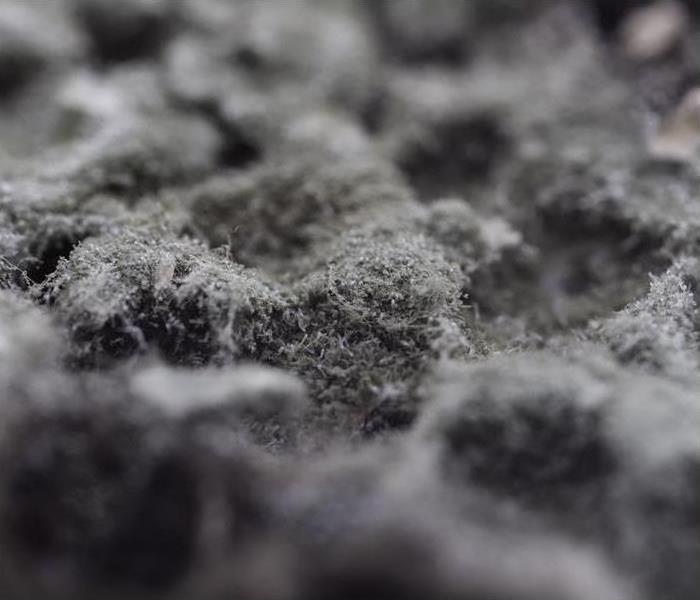 You may not always know you have a wet crawl space unless it turns into a mold problem, but you can take measures to prevent it.
You may not always know you have a wet crawl space unless it turns into a mold problem, but you can take measures to prevent it.
How To Keep Water Out of Your Crawl Space
A wet crawl space is not something you want to ignore. While it may not seem to affect your home, unattended leaks can cause mold growth that only restoration experts can combat. There are several ways that water can get into the crawl space, but fortunately, there are also ways to prevent it.
Proper Gutter Care
Common culprits in crawl space flooding are your gutters. There are several ways your gutters could cause moisture problems:
- Gutters clogged with dirt or debris
- Downspouts pointed toward house
- Missing or damaged downspout
- Cracked gutters
The solution to this problem is simple. Take good care of your gutters, and they will do the job they are designed to do, which is directing water away from your home instead of toward it.
Smart Landscaping
Another thing you can do to direct water away from your house and avoid a wet crawl space is to make sure you have a slope away from the foundation. It should slope 6-8 inches, and you need to check it periodically to make sure that it hasn't been washed out by rainfall or lawn care. You can also protect your crawl space by not overwatering the flower beds that are close to your house. Don't leave the water running unattended. Give the plants just what they need to thrive and turn the water off.
Home Inspection
Water leaks in your home can trickle to your crawl space. It's best to catch the leak before it gets there, not just so you can fix the source of the problem but also so that you can do so while the problem is still confined to an area that is easy to access. If you notice signs of a flood in your home in Leawood, KS, call repair technicians as soon as possible to avoid leaks into lower areas of your home.
You may not always know you have a wet crawl space unless it turns into a mold problem, but you can take measures to prevent it. Protecting the area at the foundation of your home is essential to keeping your home free from water damage.
How To Select the Best Fire Extinguisher for Your Home
7/15/2021 (Permalink)
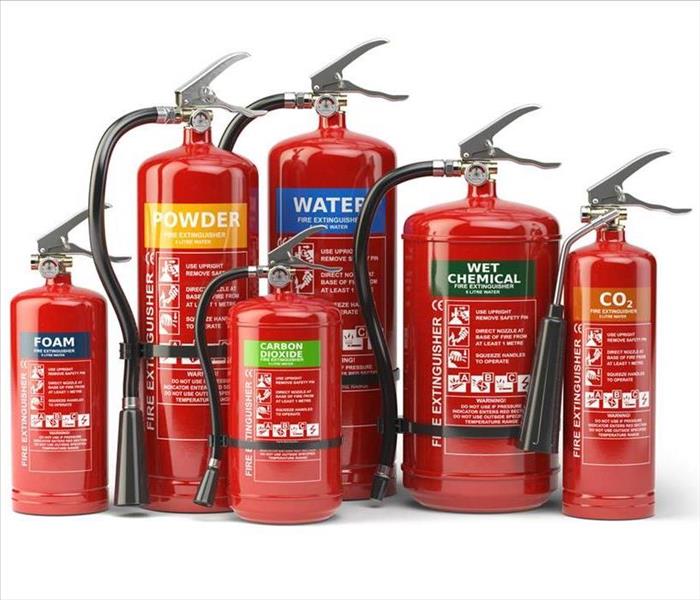 Not all fire extinguishers are created equal.
Not all fire extinguishers are created equal.
What Is The Best Type Of Fire Extinguisher For Home Use?
Not all fire extinguishers are created equal. When shopping for one for your home, it’s important that you understand the differences between each type of fire extinguisher, what they’re used for and how to select the right one for your home. There are a few factors to consider before making your purchase:
Size
There are four different sizes for extinguishers used to fight home fires: 10-pound, five-pound, two-pound, and stove-top. The 10-pound extinguisher is best for garages, sheds, and outbuildings in which a fire might have the potential to grow without being noticed.
A five-pound extinguisher is best for in the home and for combatting kitchen fires and electrical fires. If you want to be able to combat a home fire, the five-pound fire extinguisher is ideal.
A two-pound extinguisher is best for on-the-go, such as in a vehicle. These models are typically disposable and come with mounts to keep them from rolling around in the trunk.
Stove-top extinguishers are exactly what they sound like—extinguishers used to fight stove fires. They’re lightweight and can be mounted directly on the range hood for easy access.
Classification
Home extinguishers are labeled as either A, B or C. Models with an “A” are effective on ordinary combustibles such as paper, wood and cloth. Those with a “B” are ideal for flammable liquids such as oil or grease. Extinguishers with a “C” can be safely used on live electricity.
Use
Finally, you want to consider ease of use. An extinguisher won’t do you any good if you do not know how to use it or if you do not have the capacity to operate it. When shopping around, ask a technician for a demonstration or, at the very least, step-by-step instructions.
A fire extinguisher needs to be a part of your fire preparedness plan.
Bad Weather: Preparation Tips for Employers
7/15/2021 (Permalink)
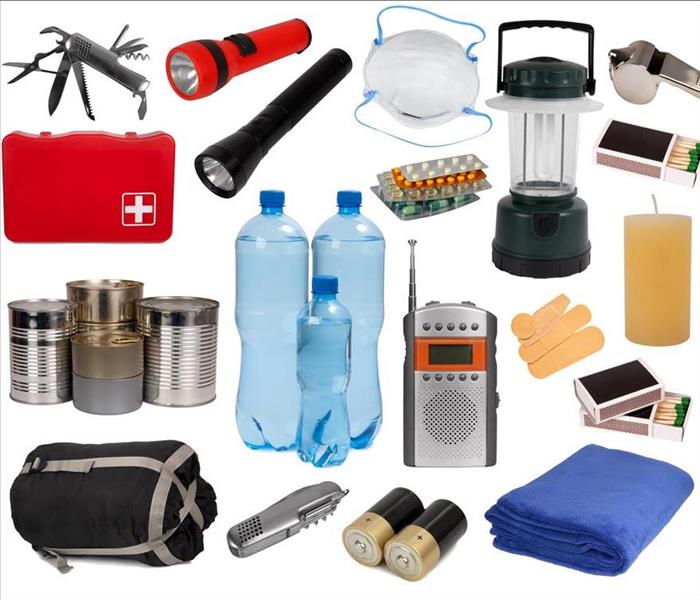 Have an emergency supply kit.
Have an emergency supply kit.
How Do You Prepare For Severe Weather
No one likes to think about the havoc winter storms could wreak on their commercial properties in Prairie Village, KS, but giving it some forethought may be just the thing that minimizes damage during a snow storm. As an employer, you are responsible for the well-being of your building as well as your employees. Here are some tips on keeping them as safe as possible.
1. Have an emergency supply kit. If the storm hits while employees are present, it’s possible that they will be stranded in the building for an extended period of time. A stash of flashlights, shelf-stable food, blankets and bottled water can go a long way toward keeping them comfortable while they wait for the danger outside to pass.
2. Have a first aid kit. A collection of bandages, first aid ointment, sanitizer and other essential supplies is a good idea anytime. It can be especially helpful during the months when conditions are more hazardous outside, as people are more likely to be injured during a snow storm.
3. Increase insulation in walls, particularly along the outer perimeter. If your plumbing freezes, your building could experience a pipe burst, which can cause significant water damage that can only be remedied by water restoration specialists. Wrapping pipes or adding an extra layer of protection from the cold can help them stay intact.
4. If possible, let employees stay home. If the local weather station warns that the roads could be treacherous, consider allowing employees to work from home. While your business is important to you, the people who take care of it should be more important. Keep them safe by offering them telecommuting options.
A snow storm may slow business down, but if you prepare adequately, there are ways to work around it. Planning ahead protects the structural integrity of your building, keeps your employees safe and communicates that you care about the well-being of both.
Why Rain Causes Mold
6/15/2021 (Permalink)
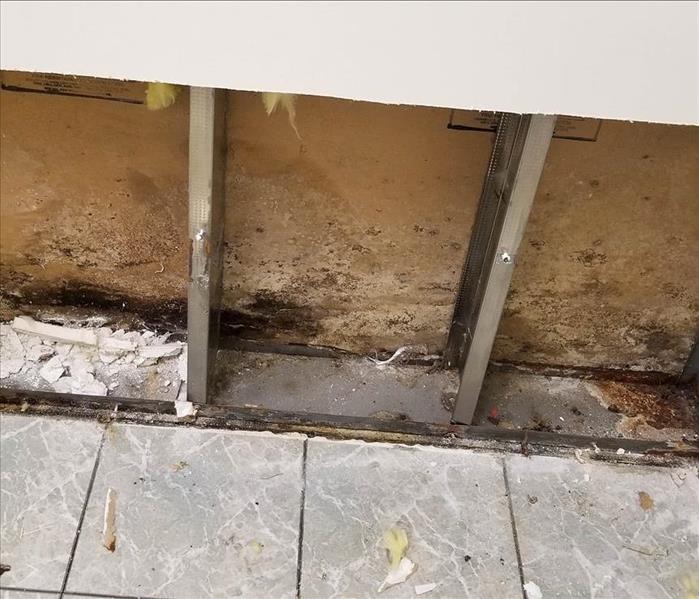 Black mold found after a storm in an Overland Park, KS home
Black mold found after a storm in an Overland Park, KS home
Why Rain Causes Mold
When a heavy storm hits Overland Park, KS, you probably check your property afterward for damage. What you may not be expecting is to find a musty odor and a mysterious growth. It's not that uncommon for black mold to appear within days after a rainstorm, though. Anywhere there is water damage, fungus growth is a distinct possibility.
Roof Damage
Thunderstorms often wreak havoc on homes. The roof is particularly vulnerable. There are many factors that can lead to roof damage during a storm:
- Hail impact
- High winds that detach shingles
- Broken tree branches
- Clogged gutters
Any point at which your roof is compromised can lead to a moisture problem in your attic. If you don't find and remedy the issue quickly enough, the water damage can easily turn into black mold growth. In fact, fungus can start to multiply in as little as 24-48 hours after the initial water issue begins, so quick remediation is the key to preventing it. Both the roof and the subsequent damage must be fixed to avoid secondary problems.
Basement Flood
If you have cracks in your foundation or storm flooding overtaxes the sewer system, you may have to contend with a basement flood. While a sump pump can remove a lot of the standing water, the residual moisture can still cause mold to grow on any damp surfaces. You must call certified mold cleanup specialists as soon as you know you have a problem. They can not only take care of your mold issue but also mitigate the water damage so that the fungus doesn't return a few days after they leave.
If you find black mold in your home after a storm, it is probably due to unmitigated water damage nearby. Fast and thorough remediation is vital for taking care of both the mold growth and the underlying issue that led to it.
Home Fire Prevention: Are You Prepared?
5/24/2021 (Permalink)
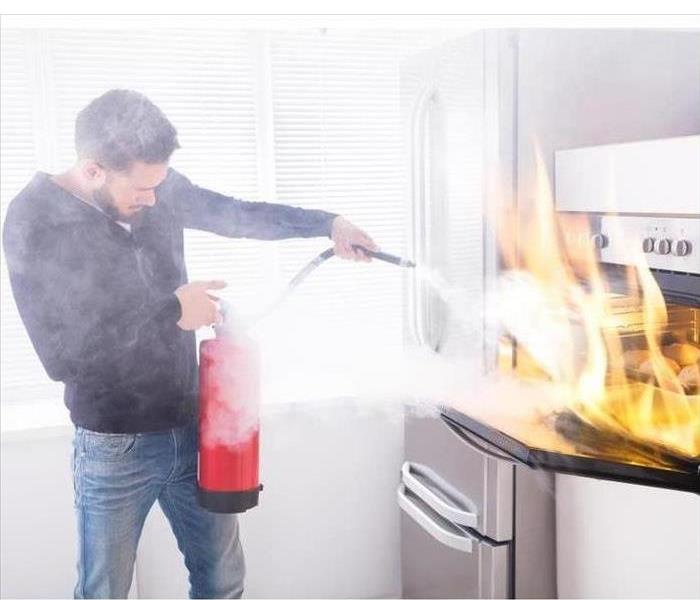 Kitchen fire in Leawood, KS.
Kitchen fire in Leawood, KS.
No one wants to think about a fire in their home, but fire preparedness is an essential element home safety. Fire services respond to nearly 400 thousand home fires each year. This discussion about common fire causes may help you augment your household’s fire-readiness plan.Kitchen Hazards
Building codes require a smoke alarm near the kitchen because nearly half of fires at home are cooking-related. Some common sources of kitchen fires include:
- Gas stove flames can ignite built-up oils or grease on pots and pans.
- An unlit gas burner accidentally left on can cause dangerous gas build-up in your kitchen.
- Greasy or dry food that is near a hot broiler coil can spark an oven fire.
- Small kitchen appliances, such as toasters, can ignite dry crumbs that contact the heating element.
Kitchen fires can cause significant damage and may require professional fire restoration. It is recommended to keep a fire extinguisher near the kitchen.
Human Carelessness
Fires caused by recreational activities, such as barbecuing or smoking, cause thousands of home fires yearly. It’s important to barbecue outside at a safe distance from structures. Following manufacturer’s instructions on cleaning and lighting your grill is essential. Smoking in the bedroom is a common cause of home fires. It is recommended that you not smoke while reclining or while using alcohol. Human error is another reason to keep a fire extinguisher in risk-prone areas.
Heating Appliances
Winter temperatures can make it tempting to heat your bedroom with a space heater before going to bed. An unattended small heater can spark a home fire; it may become overheated or tip over and ignite nearby drapes, carpet or clothing. If you turn a small heater on, it’s recommended you stay in the room throughout its operation.
Fires start because a flame or heating element comes in contact with some kind of fuel. This may be gas, textiles, grease, or oil. It’s important to carefully monitor anything with a heating element in your home. A wisely-located fire extinguisher can save your Leawood, KS, home from extensive damage. Common-sense fire preparedness can mean the difference between a relaxing evening and a devastating fire.
Commercial Storm Restoration: 5 Things Owners Should Expect To See
5/15/2021 (Permalink)
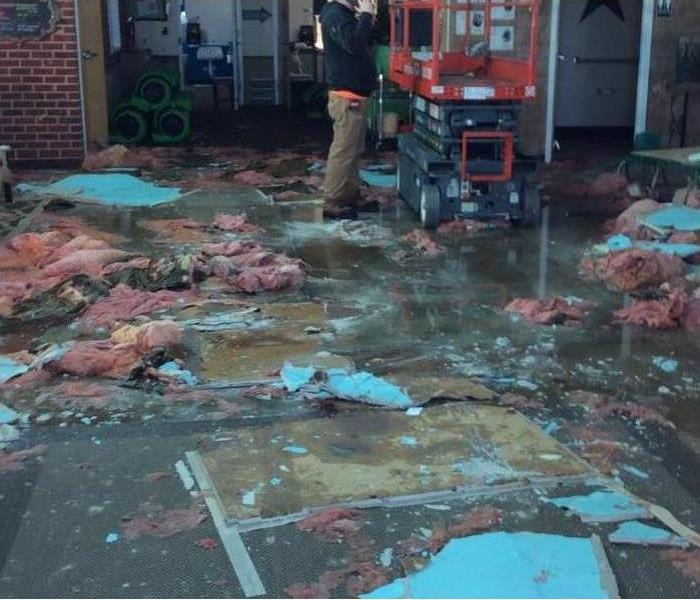 Storm damage in a daycare.
Storm damage in a daycare.
Commercial Storm Restoration
When a powerful weather system impacts an area, commercial owners are likely to require water and storm cleanup procedures. Whether from an internal flood or roof leak exposure, properties may incur immense damage. A water restoration company should attend to the premises, providing several means of assistance, including drying and tear out procedures. As a proprietor, expect to witness the following five things.
1. Methodical Testing
Not all water damage is the same. Anytime moisture saturation occurs, it's essential to understand the source and how it impacted the facility. A remediation team of certified professionals takes samples of the air and structure. These collections provide valuable information about what may be growing within the rooms and how to treat the location correctly.
2. Minimize Movement
If something is harboring inside the walls, it may migrate through the air or by a person. Barriers should be established to prevent people from entering and leaving often. Negative air chambers may be used to prevent air contamination. Signs and visible blockades are put up to keep others from walking into the zone.
3. Various Drying Efforts
Dampness sets into porous materials, especially the floor and wall. The team must air out the space to prevent rot and bacterial and mold growth. The crew brings in industrial dehumidifiers, which extract humidity. They then perform flood cuts in which they tear out at least 12 inches of drywall above the flood line. This step reduces fluid amounts and improves air circulation within the wall.
4. Content Evaluations
Some items may be salvageable. Employees look through the fixtures, electronics and paperwork. Using effective and highly sophisticated technology, they may be able to clean and repair some possessions.
5. Rebuilding and Replacing
Once the impacted section has been sanitized, storm restoration starts. The workers fix the walls, install the new carpeting. They also patch and paint the walls.
Commercial owners should understand the need for stages. Both drying and tear-out processes prevent future complications. Take care of things now to avoid trouble later.
Reasons for Shuttering Your Office After a Fire
4/30/2021 (Permalink)
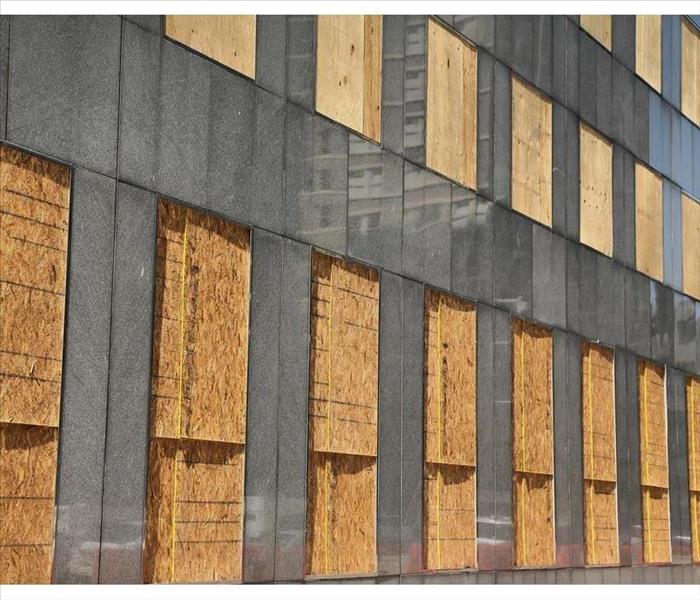 Boarding up fire damage is vital to preserving the contents of your wallet, as well as your sanity.
Boarding up fire damage is vital to preserving the contents of your wallet, as well as your sanity.
Reasons Why You Need To Secure Your Workspace After A Fire
Fire damage places your business in a precarious position. Additional destruction can befall your office when you have smashed windows, gaps in walls, and broken doors. Boarding up can prevent these subsequent complications from developing. This is vital when you're already anticipating the upheaval and expense that come with commercial building fire restoration services.
Reasons for Securing Workplace Vulnerabilities
When a fire causes significant structural damage to your office in Prairie Village, KS, various problems can arise. If your office's interior becomes exposed, you are at risk from:
Weather conditions, such as rain, snow and sleet
Wild animals, on the hunt for food and shelter
Criminals, adept at looting and vandalism
Blocking off your building's freshly exposed areas can mitigate these dangers.
Consequences of Not Securing Workplace Vulnerabilities
Fire damage to your office is distressing enough. The last thing you need is for the problem to be compounded. Here are a few costly outcomes that can develop if you fail to cover over any holes.
When moisture from the elements gets inside buildings, it's only a matter of time before mold develops. Mold removal can cost anywhere between $500 and $30,000, depending on the severity. This is particularly disheartening when you are already anticipating the financial burden that comes with fire cleanup.
Thieves are always looking for opportunities to steal. The presence of electronics makes your building a target. Missing computers may also mean the loss of operational data and compromised customer information, which might lead to a subsequent drop in business.
Insurance companies are always trying to find reasons for denying claims. By not boarding up, you offer them one more excuse for not providing monetary relief. Deny them this opportunity.
Boarding up fire damage is vital to preserving the contents of your wallet, as well as your sanity. Be certain you block off any vulnerabilities after a fire to prevent further trauma.
3 Categories of Black Water Spills
4/16/2021 (Permalink)
 Severe storm damage in Overland Park, KS.
Severe storm damage in Overland Park, KS.
Flood damage is a messy situation that threatens the employee’s health and the company’s finances. Its severity is measured by the level of contamination, with a black water flood being the worst-case scenario.
Here Are The 3 Categories of Black Water:
Level 1 – a tiny spillover
Level 2 – a considerable toilet overflow
Level 3 – flood water mixed with sewage
Level 1
Level 1 contamination happens when a toilet overflows, and the wastewater doesn’t leave the bathroom. That means there is zero contact with porous things such as cabinets, wooden floors and drywall. Usually, this kind of overflow is easy to fix, which means the wastewater gets a limited time of exposure. A good cleanup company should be able to troubleshoot and solve the issue in no time.
Level 2
Sometimes, you might not be so lucky. The toilet overflow may break out of the bathroom and contaminate your carpets, upholstery and other porous items. That creates a problematic situation as you have to remove everything for individual attention. Any permeable items that get into contact with this wastewater should be disposed of immediately.
Level 3
Level 3 represents black water damage that comes from the outside and flows into the building. It could be a leaking sewer that mixes with floodwater from an overflowing river that finds its way into the business premises. This wastewater gets into everything, including walls, furniture, and electronics, rendering them useless. On top of that, there could also be storm damage on the exterior walls.
Generally speaking, you should consider all flood water to be level 3 as it usually drags all sorts of harmful chemicals, dirt, and debris from the outside. It is also worth noting that DIYing this type of situation is the worst mistake you can make as a business owner. You might want to find a reliable cleanup company in Overland Park, KS to handle it.
3 Steps to Prepare for the Perfect Dinner Party
3/25/2021 (Permalink)
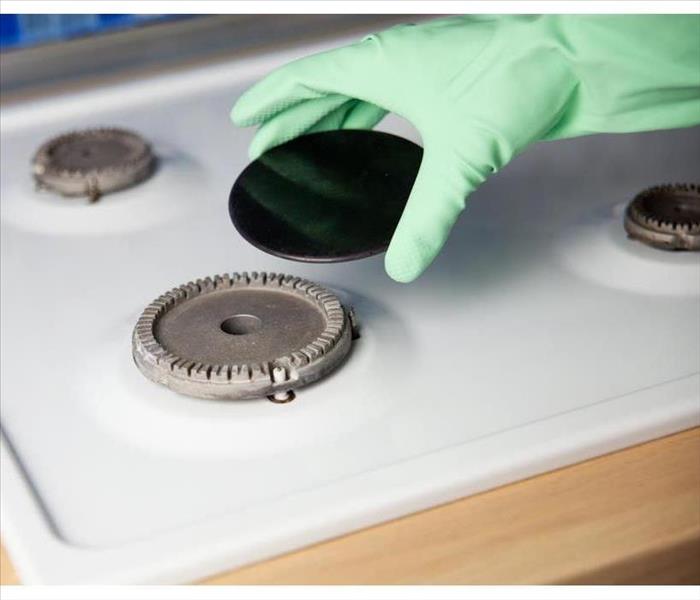 Keep your kitchen clean!
Keep your kitchen clean!
3 Steps to Prepare for the Perfect Dinner Party
If you are a seasoned dinner party host, you know the tricky balance of maintaining a clean kitchen while whipping up a delectable feast for a slew of family and friends. It's easy to get behind on one of these endeavors, resulting in a mediocre meal or an embarrassingly messy gas range. Make the focus your delicious food by following these easy steps to a clean, tidy kitchen.
1. Prep
Experienced chefs in Overland Park, KS, know the importance of cleaning the kitchen as they cook. This process eliminates the need for too much elbow grease post-meal, allowing more time for conversation. First, be sure to stock up on cleaning essentials before your next gathering:
- Vinegar
- Soap
- Rags
- A toothbrush
When utilizing your gas range to cook a meal, prepare the food ahead of time, cleaning all utensils and countertops that dirty along the way. Once cooked, place the hot food in heat-resistant containers, and keep them warm in the oven. This practice will allow for time to clean up before your guests' arrival.
2. Scrub
Once your dinner is complete and warming in the oven, begin your range cleaning process. Remove the grates from the stove, and spray the surface with a water and vinegar solution. If residue persists after wiping it clean, dip a toothbrush in some dish soap, and scrub the particles free. Finally, polish the grates and burner heads in warm soapy water until they are free from leftover particles. This action is critical, as remaining food fragments can burn on an ignited range, resulting in an unpleasant smoke smell.
3. Reassemble
Once all sections are clean and dry, reassemble your range. It is now tidy and presentable for company, and you have one less duty to perform after dinner. Use your clean stove to display hot food containers straight out of the oven. The grates can withstand heat, eliminating the need for any fire damage assessment at your dinner party!
Maintaining a clean kitchen as you cook makes any host's job simple and fun. Spead more time with your guests by cleaning your gas range before they arrive.
4 Tools That Can Help You Clear Your Clogged Drains
3/11/2021 (Permalink)
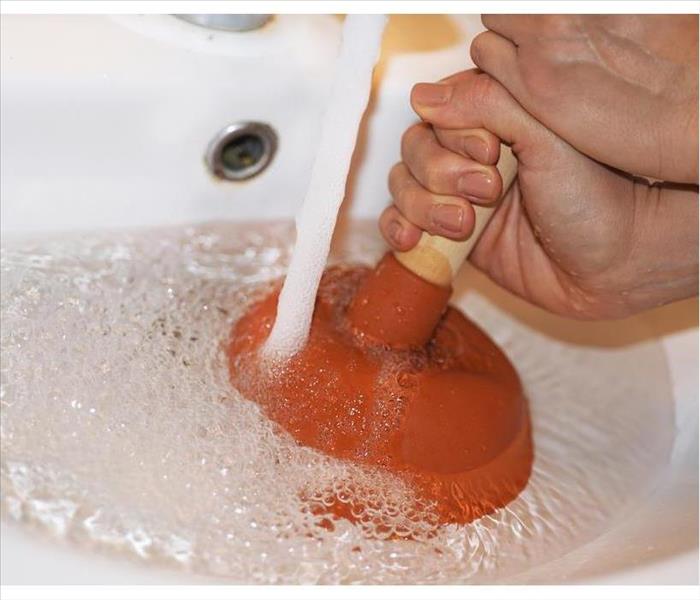 The first tool most DIYers reach for to remedy clogged pipes is a plunger.
The first tool most DIYers reach for to remedy clogged pipes is a plunger.
Get The Right Tool For The Job
Any pipe can become clogged. When this happens, you need to act fast to avoid a pipe break that will require you to hire a water restoration company. Your first option is going to be to hire a plumber. However, this can be costly and inconvenient. Fortunately, there are a few DIY options when it comes to dislodging clogs. You will need to get the right tool for the job.
1. Plunger
The first tool most DIYers reach for to remedy clogged pipes is a plunger. These will remove clogs found in sinks, tubs, toilets, and more. You probably already have one of these in your home for emergencies.
2. Cable Auger
If you can't clear your clogged pipe with a plunger, the debris is probably a good distance into the pipe, and you will need to invest in a cable auger, also known as a drain snake. Any hardware store in Prairie Village, KS, should have a range of snake options from 25 feet to 100 feet long.
3. Closet Auger
A closet auger is a snake that is specifically made for toilets. It will still come with a crank to help you work the tip down the toilet, but the cable will be housed in a shaft rather than a coiled spool. Also, the manufacturer will shape the tip so you can easily work it through the kinks in your toilet.
4. Electric Auger
Cloggs that are really far in your pipe or ultra-stubborn, you may want an electric auger. This machine will cut through any clog, even tough tree roots. Before using this, make sure you understand how to extend the cable and reel it back in safely.
Whether you can clear your stopped drain with a plunger or need the power of an electric auger, this DIY task is a great one to know. It can save you the time and money it would take to hire a plumber and help you keep your pipes clear.
Be Prepared for Commercial Disasters
2/23/2021 (Permalink)
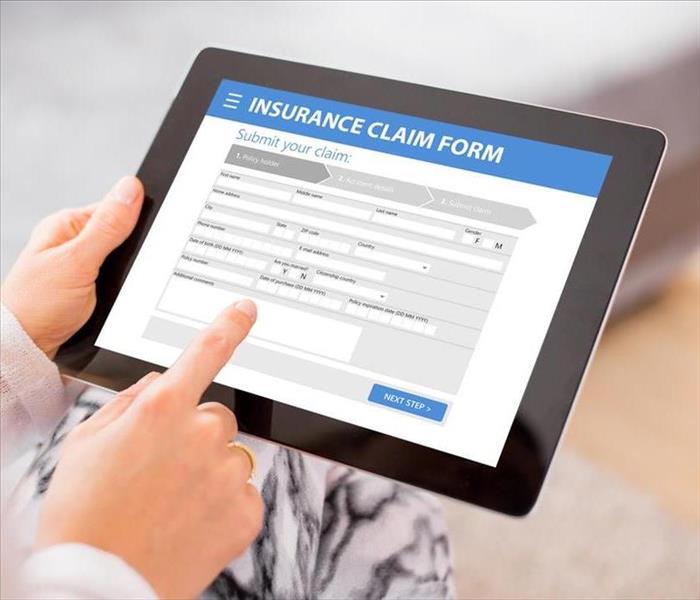 Electronic insurance claim.
Electronic insurance claim.
No business owner wants to think about a disaster striking their property. You hope it will never happen to you, but it is crucial to be prepared. To ease the pain in filing a claim with your insurance agent, make sure you choose a restoration company that has well-designed claim services and cost-reduction policies.
What Services Are Helpful When You File a Claim?
SERVPRO franchises are available all around the United States, so there is one nearby when you need help. Each franchise provides services to make the claims process go smoothly.
Quick Response - Since a fast emergency response is vital to reduce the damages to your property, a quick response means your insurance adjuster can keep the costs down.
Pretesting Services - Insurance agents know that restoring property is less costly than replacing items. Professional restoration services understand this as well. The highly-trained experts you choose are able to ensure that all pretesting is performed on damaged items to determine which can be restored.
Electronic Filing of Claims - Claim services that allow for on-line filing and access to information make the process go quicker and smoother.
Claims Inventory - It is helpful when you have the ability to receive an itemized list of every item that needs to be replaced. The professionals offer an Excel spreadsheet of the damaged items, along with pictures of the key items lost.
What Information Is Helpful to Your Insurance Adjuster?
When insurance adjusters have access to reports on-line, it can improve results and speed up claims filings. It also helps to have access to job cost performance data.
When claims are filed electronically, it also gives adjusters access to claims information from similar jobs to help them make sound decisions on current and future claims estimates.
If you are dealing with property damage at your facility in Leawood, KS, calling a professional with on-line claim services will help to ease the stress.
How To Care for Water-Damaged Wood Flooring
2/16/2021 (Permalink)
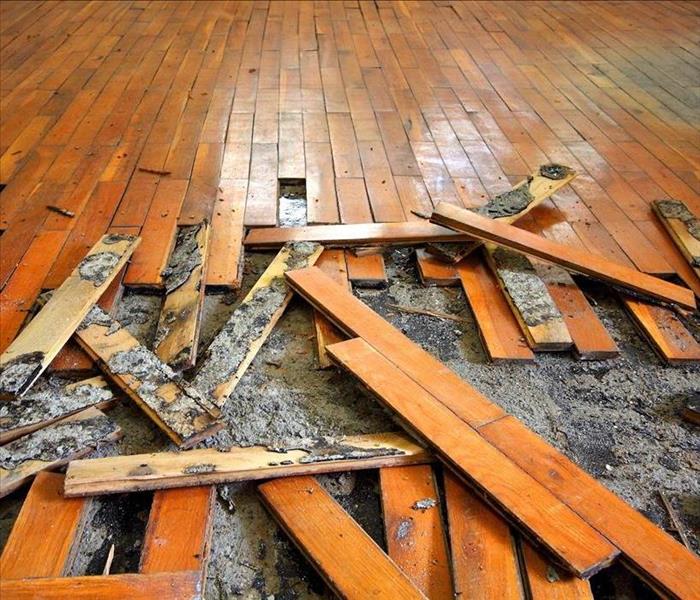 Wood floor can sustain significant damage after large amounts of water.
Wood floor can sustain significant damage after large amounts of water.
Wood Floor Replacement
Wood floors in a commercial building can sustain significant damage after a pipe burst or other exposure to large amounts of water. It is necessary to respond to water damage quickly to salvage flooring in a structure located in Overland Park, KS.
Extract Standing Water
Wood is a porous material. While commercial wood floors may be varnished to reduce permeability, it is still necessary to remove water quickly. Any of the following methods may be effective, depending on the quantity of water:
- Mop and bucket
- Pump
- Wet-dry vacuum
Removing water from a wood floor as soon as possible can limit the degree of damage. Wood may start to become discolored or warped within a matter of hours and may not be salvageable after days of saturation.
Dry the Floor
After removing water, direct drying methods such as applying towels to the surface and indirect methods such as air movers, fans, or dehumidifiers can promote drying. If a pipe burst causes damage and water is removed within hours, no disinfection is necessary. Exposure to contaminated water calls for cleaning and disinfection and may necessitate tearing out and replacing wood flooring.
Restore Damaged Wood
There are several ways to recover wood that has sustained damage from water. Resurfacing wood by sanding can eliminate cupping, which involves floorboards that have become concave or convex due to exposure to moisture. It may be necessary to sand off paint or finish if mold forms underneath this layer of a wet floor prior to treating, drying, and refinishing.
Removing standing water from wood floors as soon as possible is essential for limiting damage. Over time, wood may become discolored or warped. In cases where water remains present for an extended period of time, such as a pipe burst that is not immediately detected at a building in Overland Park, KS, it may be necessary to replace wood floors.
What You Need To Clean After a Flood
1/14/2021 (Permalink)
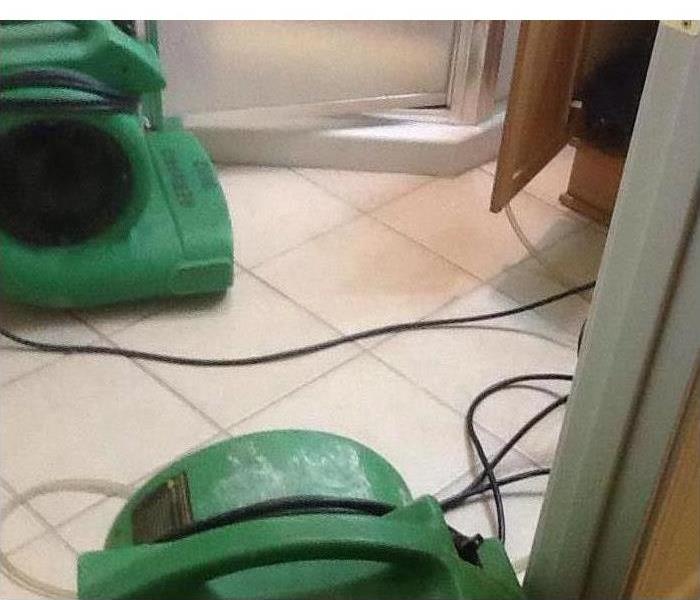 Storm damage restoration in Leawood, KS
Storm damage restoration in Leawood, KS
What You Need To Clean After a Flood
It's no secret that flooding can cause mold, mildew, and other damage to your home and belongings, but some of the things that need to be cleaned may surprise you. Adhering to these cleaning requirements can help keep you safe and prevent damage.
For a thorough flood clean, you should treat all surfaces:
- Wood
- Carpet
- Vinyl
- Fabric/upholstery
- Kitchenware
- Walls
- Cabinets and counters
Before disposing of cherished or expensive belongings, you can check with a water damage restoration service in Leawood, KS, to determine if they are salvageable.
Walls and Flooring
Wallboard and plaster may have to be removed and replaced if the water was contaminated. If the water was clean, you may be able to cut a small hole at the top and bottom of the wall to allow water to drain and air to circulate.
Different types of flooring have different cleaning requirements. If possible, the carpet should be removed and taken outside immediately. You can then rinse it off, clean it with a flood disinfectant and allow it to fully dry. Tile and vinyl floors may trap moisture in the sub-floor, so they should be removed to allow air to circulate. Hardwood floors can buckle or crack due to water exposure and drying. You can mitigate buckling by removing some boards while the floor dries. Once wood, tile or vinyl floors have dried completely, they should be disinfected.
Fabric and Upholstery
Anything absorbent, such as upholstered furniture, should be considered contaminated. Such items should be taken outside to dry immediately. If you wish to keep them, you should have them cleaned by a professional restoration service.
Miscellaneous
Other surfaces, such as countertops, should be dried and then cleaned with flood disinfectant. Some items, such as dishes and glassware, can be submerged in cleaning solutions.
Following cleaning requirements for walls, flooring, fabric, upholstered furniture, and other surfaces can mitigate the risk of mold growth if you act quickly.
How To Flush a Water Heater
1/3/2021 (Permalink)
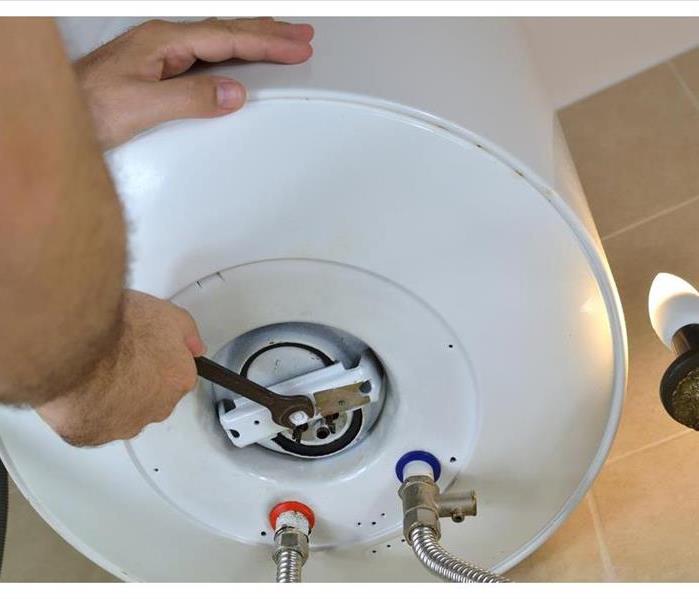 Keep your water heater in Prairie Village, KS, running smoothly
Keep your water heater in Prairie Village, KS, running smoothly
When you conduct regular maintenance on your water heater, it will stay in good condition longer and reduce the risk of costly repairs. Your maintenance plan should include periodically flushing your heater.
Let's Look At The Steps Involved
1. Turn the Heater Off
If you own an electric heater, turn off the supply line at the circuit breaker. For gas heaters, make sure the pilot is extinguished.
2. Attach the Hose
Using a standard garden hose, connect it to the drain valve. Make sure the loose end isn't placed near an area that would be negatively affected by the sediment or water. Don't forget to wear gloves to protect against hot water. If you encounter water damage during the process, call a water damage repair service as soon as possible.
3. Drain the Water
Drain the water heater tank by opening the drain valve. Turn on a hot water faucet in the kitchen to help the water drain more quickly. When the water flow begins to slow down, turn off the supply valve. When the water stops, turn the water supply valve on to quickly flush the system and then close it again.
4. Shut Off the Valves
Once the water heater flush is completed, close all the valves. Then, turn on the water supply and keep an eye on the kitchen faucet. When the water comes out smooth and without bursts of air, this means the tank is full again.
5. Turn the Power Back On
After the tank is full, turn on the power to the unit. Make sure the heating element is functional as well. Never turn the power on until you are sure the tank is full since this can damage the unit. Don't forget to turn off the kitchen faucet.
Keep your water heater in Prairie Village, KS, running smoothly for years with a little routine maintenance.
What To Do When Furnace Soot Contaminates Your Office
1/3/2021 (Permalink)
 Furnace soot damage
Furnace soot damage
When Your Furnace Malfunctions, Follow These Steps
If your company’s furnace experiences a buildup of oil vapors inside its ignition chamber, an internal explosion may be imminent. When this happens, soot can blow through your exhaust unit and into your heating system. The unwanted effects of this phenomenon are known as puffback damage.
Soot emitted from furnaces is dark and sticky, making it extremely difficult to remove. Because it floats through the air, soot typically travels a significant amount of space and particles are able to get inside everything. Besides coating ductwork, office equipment such as file cabinets, computers and phones remain highly susceptible. You may be forced to mandate that staff work from home until the cleaning process has concluded. When your furnace malfunctions, follow these steps.
1. Perform an Examination
Peek inside your heating device in Overland Park, KS, and check for anything that raises concern. The smoke that blows into ventilation systems spreads everywhere. Use your nose in every part of your building to detect nasty smoky smells and determine what areas are suffering from puffback damage. A commercial odor removal service will be required for complete elimination.
2. Contact Your Insurance
As soon as possible, file a claim. Report every element of loss that you observe and include pictures to support your assertions.
3. Hire an HVAC Technician
Only allow someone bearing relevant certification to alter your heating system. The consequences of letting uninformed individuals make alterations to your device could result in further trouble or void your warranty.
4. Employ a Soot Removal Expert
Special tools and cleaning agents are necessary to properly eliminate the stink generated by furnace puffback. A professional cleaning organization will also be able to decontaminate and deodorize every single area needing attention.
Unless you are a trained professional, never attempt to repair your oil furnace or clean up puffback damage. If your heating system malfunctions and triggers a stinky scenario, allow experts to set things right.
Understanding Commercial Mold Coverage
12/23/2020 (Permalink)
 Having commercial insurance is crucial for protecting your business
Having commercial insurance is crucial for protecting your business
Understanding Commercial Mold Coverage
Having commercial insurance is crucial for protecting your business in Prairie Village, KS, but when it comes to mold and fungus, the policy coverage can be perplexing. Contacting your insurance carrier for clarification is always recommended, but even then, the policy can still be confusing.
Most policies contain a broad fungus exclusion that limits the conditions under which mold is covered through the following exceptions:
- There is a specified cause of loss that resulted from fungus or mold
- The mold was caused by lightning or fire
- Mold or fungus that was caused by something other than fire or lightning and is clearly specified in the Limited Fungus
- Clause of your policy
How does the Limited Fungus Clause of your policy work?
The circumstances under the Limited Fungus Clause can vary with different commercial insurance providers and the details will be specified within your own policy. In general, the three following items are covered:
1. Removing and Replacing Property for Fungus Removal
The cost of removing and replacing any part of your property to access the fungus for removal. If a leaking pipe is causing mold damage in your building and parts of the wall need to be torn out to access the leaking pipe even though no mold is visible on the wall, mold insurance will cover the cost of tearing out and replacing the wall
2. Damage or Direct Loss to Covered Property
If there is damage or physical loss, the cost of removing and replacing the property is covered, along with the costs for removing the mold. For example, the costs for using a commercial mold removal and remediation service are covered.
3. Mold Testing
After repairing and restoring your building and the fungus has been removed, insurance covers testing to ensure the mold has been eliminated.
Commercial insurance can be unclear, and it is always a good idea to contact your insurance provider to get clarification on specific coverage under your policy. Understanding what is included, particularly under the Limited Fungus Clause, will help you take the appropriate actions to protect your business.
Fix That Water Leak in Your Building Before it Causes Extensive Damage
12/23/2020 (Permalink)
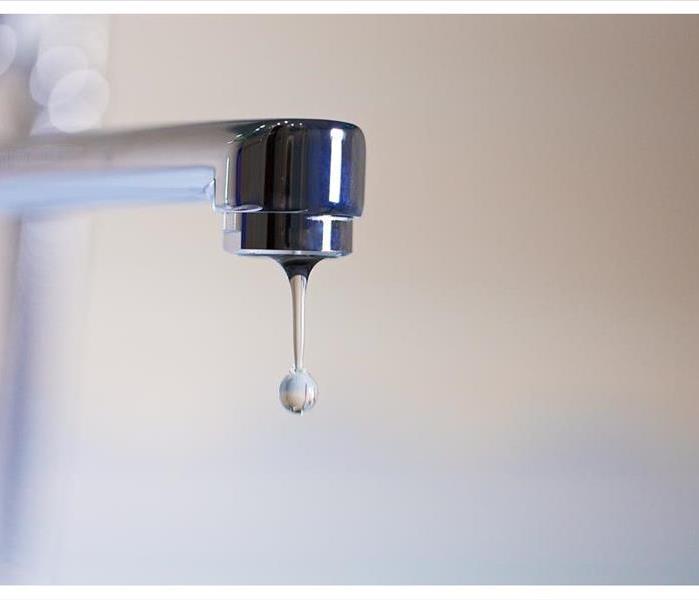 Repair your faucet before it causes serious water damage
Repair your faucet before it causes serious water damage
Damage caused by a water event in your commercial building in Overland Park, KS, can create a serious situation. If you don't identify the problem quickly, it could cost you thousands of dollars in repairs. There are many places for a water leak to occur inside your building. Let's look at the most common culprits.
Leaks Inside Commercial Buildings
To avoid expensive water bills and serious water damage, be aware of the most common places for leaks to happen.
Toilet leaks - The toilets in public bathrooms get a lot of use. Because of this, parts tend to wear out quickly, allowing water to leak. Inspect the toilets frequently for any sign of leakage.
Leaky faucets - Rubber washers wear out over time, due to continued use. Once the washer refuses to create a watertight seal, the faucet will leak. If the leak isn't addressed, you may eventually need to replace the entire faucet.
Plumbing leaks - A pipe break or broken water supply line can cause an extensive water leak. Some piping systems are installed inside the walls, which makes it difficult to find the leak. Musty smells and mold patches are indications that you have a hidden problem.
If you are dealing with a serious water event in your building, it is critical to call a water damage repair service right away to assess the situation and restore the damage.
Leaks That Start Outside the Building
Roof leaks are common in flat commercial buildings, because it is harder for the water to drain well. Strong winds and hail make the situation even worse. Have your maintenance staff check the roofing materials and flashing on a routine basis to look for any signs of wear. Drains and pipes must be properly secured and cleaned. Remove leaves and dirt from gutters to allow water to drain off the roof properly.
Always take a water leak seriously at your property to avoid costly repairs and high water bills.
Dealing With Damage to Carpets and Other Items After Flooding
11/20/2020 (Permalink)
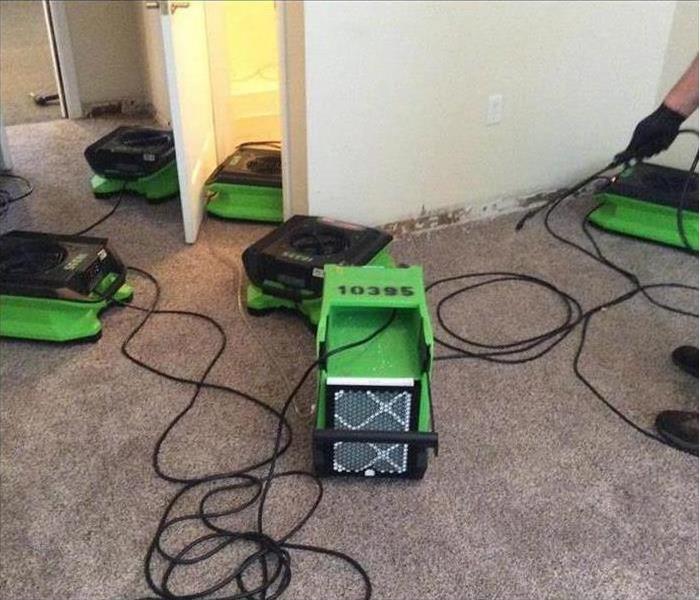 Wet carpets are salvageable
Wet carpets are salvageable
Dealing With Damage to Carpets and Other Items After Flooding
If you have had a pipe break or other flooding event in Overland Park, KS, many of your items have likely been inundated with water. You are probably wondering whether removed items can be returned to their previous places. You may also be concerned about the possibility of a mold infestation. The future of your items depends on the length of their exposure to moisture and the source of the floodwater in your home.
Water Sources
Most flooding in residential homes comes from clean sources of water such as:
- A pipe break
- Broken supply lines
- Leaky faucets
- Other major leaks
When flooding is caused by clean sources, you can return your items as long as they can be properly dried. Because mold can grow very quickly after flooding, it is essential that you dry your possessions as soon as possible. If any large item was soaked for more than 24 hours, you should replace it.
Dirty water caused by septic overflows or large-scale flooding may contain contaminants that are difficult to get out of carpets and other items. If you have a carpet that spans the entire area of the flooded space in your home, it is generally more cost-effective to replace it than to try to clean and restore it after exposure to contaminated water.
Evaluating Your Items
The first step in the restoration process is to remove furniture and other objects to a higher, drier location. Dry immovable carpeting by opening windows and turn on as many fans as possible. You should inspect every surface of each item of concern. Sometimes, the tops of rugs or other flat items are dry while there is still moisture underneath. Similarly, material inside furniture can be wet even if the outside is dry.
After a pipe break or other flood in your home, you may be unsure what to do. Once you have stopped the flow of water, you may need to have dry wall torn out and your home may require other intensive remediation. A restoration professional can help guide you through the process.
How You and Your Town Can Prevent Flood Damage at Your Business
11/13/2020 (Permalink)
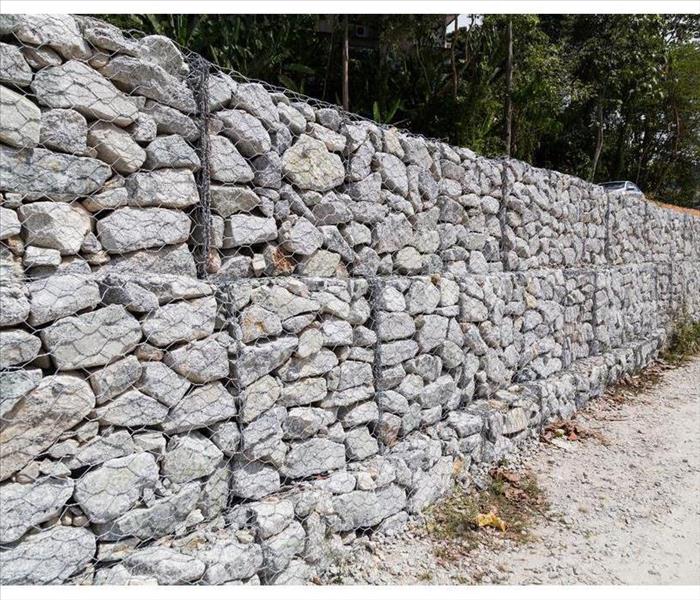 Sea walls can prevent flood damage
Sea walls can prevent flood damage
Ways That You And Your Municipality Can Protect Your Business From Floodwater
When you own a business in Overland Park, KS, you need to take various proactive flood prevention measures. Fortunately, you can share this responsibility with the city in which you operate. Here are some crucial ways that you and your municipality can protect your business from floodwater and minimize damage and disruption.
Install Structural Barriers
Most city or town municipalities situated near water have infrastructures in place to prevent flood damage, such as:
- Dams
- Levees
- Sea Walls
- Water Barriers
Of course, when storm conditions are severe, these measures may not be enough to prevent large quantities of water from flooding your business. You can supplement these measures with moveable water barriers, absorbant sandbags, moveable dams, water shields and water gates.
Plant Vegetation
Trees and other forms of vegetation are an excellent natural flood prevention method with proven results. As roots grow into the ground, they create open spaces within the soil that become a natural water drainage system. Trees also capture rainwater on their leaves and branches where it evaporates before it enters the ground. Many municipalities plant trees to support their flood control efforts. You can also increase the number of plantings on your building's surrounding landscape to reduce the risk of flooding.
Address Sanitation
Flood water carries unsafe bacteria, microorganisms, industrial waste and other contaminants. When water enters your building, it can quickly overtake everything in its path. Further damage may be due to mold formation from stagnant water. A flood restoration company can perform flood cleaning to extract contaminated water and restore your business's sanitary conditions. If mold has formed, powerful air filtration methods can remove spores from the air to restore a safe environment. Municipalities that provide separate rainwater and sewer pipes can reduce the incidence of sewage-filled floodwater in your building.
A flood can significantly impact your business in Overland Park, KS, but taking proactive flood prevention steps can support your local municipality's efforts to decrease the flood risk.
4 Steps for Using a Fire Extinguisher
10/31/2020 (Permalink)
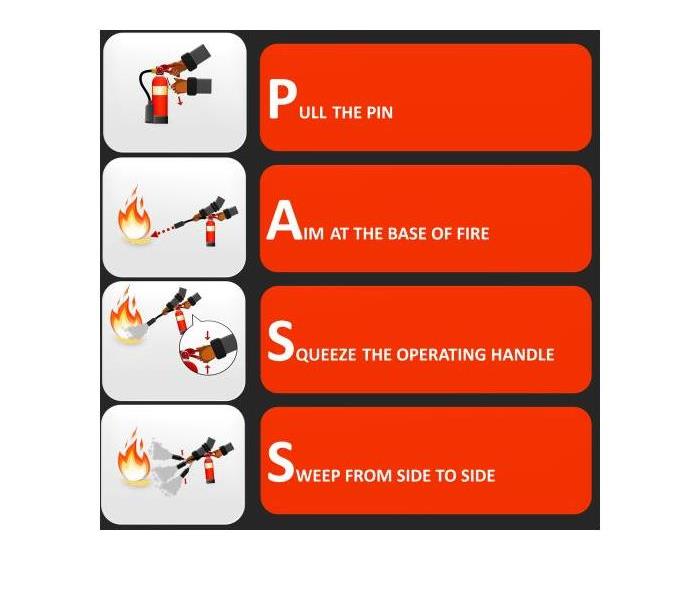 Use the P.A.S.S technique
Use the P.A.S.S technique
Follow These Steps To Extinguish A Small Fire
In the event of a fire in Leawood, KS, it is important that all staff and workers have been briefed on how to operate a fire extinguisher. There are several different types of extinguishers, but the basics are quite consistent across brands and models. Most can be readied in four simple steps.
1. Pull
For safety, all fire extinguishers have a pin built in to prevent accidental activation. There is a ring on the end of the pin that can be grabbed and pulled. Additionally, in commercial buildings, there may be a zip tie attached to the pin. This is in place to let the fire department know that the device has been used and needs to be replaced. In the event of a fire, it should be no issue; it is made to be easily broken. After this, the extinguisher will fire, so be careful not to accidentally use it prematurely.
2. Aim
Arguably the most important step is to aim in the direction of the fire. Hold the lower lever with your right hand, and hold the hose close to the end with your other hand. When holding the end, don't put your hand on the cone-shaped nozzle. It will get extremely cold due to the release of pressure. Be sure to aim at the fuel source of the fire, not the flames themselves. The fire extinguisher will be largely ineffective if aimed only at the flames.
3. Squeeze
Next, using the hand that is holding the lever, firmly grasp the upper lever with the palm of your hand while keeping your fingers on the lower lever. Squeeze and close your hand while continuing to aim at the fuel source of the fire.
4. Sweep
Move the hose back and forth across the source of the fire while continuing to squeeze. With caution, move closer as the flames die down. Be sure to extinguish any glowing embers that can be leftover from the flames because they may reignite. Greases or oils, especially those involved in a kitchen fire, are prone to reignition.
Following these steps should allow you to safely extinguish a small fire. However, if the flames do not go out, or, if they flare, be sure to exit the building immediately. After emergency crews extinguish these flames, it is best to contact a professional cleanup service to deal with any fire damage.
How To Identify the Categories of Water Damage
10/31/2020 (Permalink)
 Water damage in a day care facility
Water damage in a day care facility
It Is Important To Understand The Water Damage Categories
If your business in Prairie Village, KS, has a plumbing issue such as a pipe burst or supply line leakage, the first step in the restoration process is to understand if water damage has been done, and what the severity of it is. A water damage restoration company will come and assess the damage, usually classifying it as category 1, 2 or 3.
These categories are based on the level of contamination of the water. It is important to understand and be able to identify the water damage categories so that you can understand how to proceed with the restoration process.
Category 1
Category 1 water damage is the least severe of the three types. It refers to clean water, which is water that does not contain any contaminants. You may have category 1 water damage if your business has:
- Malfunctioning appliances
- Broken toilets
- Melting ice or snow
- Overflowing sinks
If you have category 1 water damage, the clean-up process is still important. Be sure to do it promptly to prevent any lasting water damage.
Category 2
Category 2 is gray water, which means it is mixed with chemicals or may have other contaminants. You may have category 2 water damage if you have a broken dishwasher or washing machine, fire protection sprinkler malfunction or an overflowing toilet with urine.
Gray water can also be a result of clean water, such as from a broken pipe, that has been left out too long or come into contact with building materials. It is imperative to start the mitigation process promptly to avoid lasting damage.
Category 3
Category 3, or black water, is the most severe category of water damage because it can contain bacteria and viruses. If you have water damage related to water mixed with sewage, rising seawater or rising flood waters, you may have category 3 water damage. It requires immediate action from a water restoration company.
It's important to be able to identify the three categories of water damage in order to understand the next step in your water restoration process for your business. Whether you're dealing with clean water or black water, acting quickly can prevent lasting damage.
What are the Steps of Filing a Flood Insurance Claim?
10/27/2020 (Permalink)
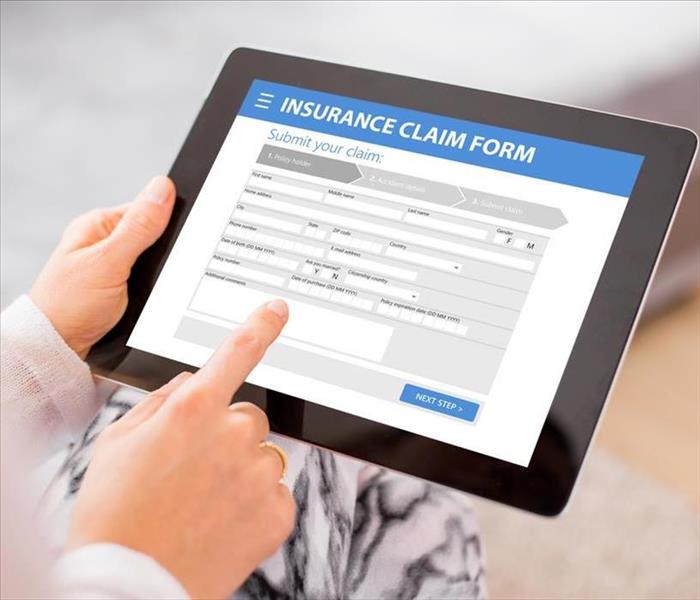 Insurance claim form
Insurance claim form
What To Do When Your Home Sustains Flood Damage
After sustaining flood damage to your home in Overland Park, KS, you might be wondering what you should do first. Here are the steps of filing a flood claim with your insurance company.
Begin Cleanup
Call your insurance company to initiate the claim process. Take detailed, dated photos and video of damage for documentation. Then, start cleanup right away before water and mold damage has time to set in. Within hours, water will seep into places such as:
- Building structures
- Insulation
- Flooring
- Carpets
- Furniture
A storm remediation company can help you begin the process of extracting water from your home. Technicians are able to respond immediately, using advanced equipment to dry furniture, belongings and building structures. They can also inventory and store any furniture or belongings that must be removed from the home.
Keep Damaged Materials
You can begin the cleanup process without waiting for the insurance adjuster. As you clean and make temporary repairs, keep damaged items and replaced parts until the adjuster has a chance to view and document them for your insurance claim. Also, be sure to keep copies of all receipts and work estimates so you can provide them to the insurance company. These documents will be vital as the company processes your claim.
Sign a Proof of Loss Statement
After the adjuster goes through each room of your home and documents damage, you will need to sign a proof of loss statement. This is an official form that lists evidence and estimates of the present value of loss to the policyholder. The insurance company uses this form, along with supporting documentation such as receipts, to determine liability. After the form is completed, the company will review your flood claim and respond accordingly.
It’s helpful to know ahead of time what to do when your home in Overland Park, KS, sustains flood damage. Keep a copy of your policy, along with important phone numbers, so you will be ready if you need to file a flood claim.
Mold Cleanup Tips
10/9/2020 (Permalink)
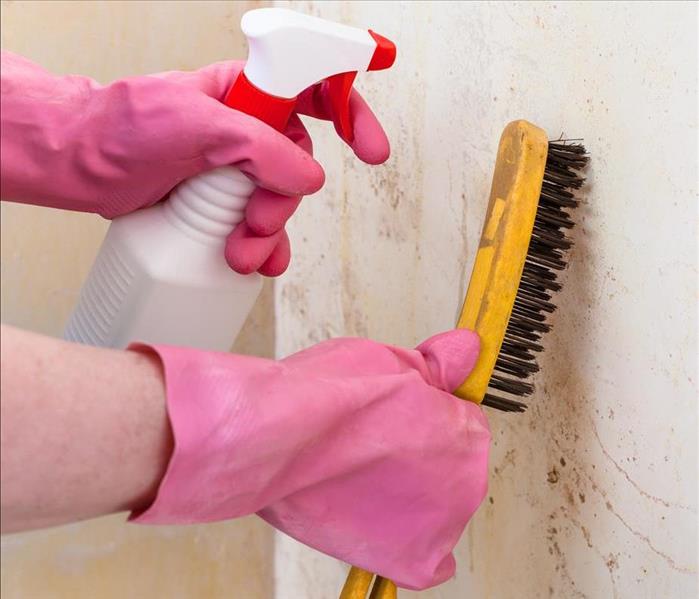 Mold cleaning in a Leawood, KS home
Mold cleaning in a Leawood, KS home
House mold is a relatively common issue that the majority of homeowners do have to handle at some point. While enlisting professional remediation services is always the recommended course of action, you may be able to resolve smaller mold cases on your own. Read on to learn how to expel mold from your home in Leawood, KS.
Cleaning Surface Mold
Mold growth is a common issue, so there are several tried and true methods for expunging it. Here's how to perform one of the most common techniques:
- Create a mold cleaning solution using 1 quart of water and a 1/2 cup of bleach. For a non-toxic solution, replace the bleach with 1 quart of white vinegar or baking soda.
- Use a scrub brush or kitchen sponge soaked in the cleaning solution to attack the surface mold. Keep working until the house mold begins to disappear.
- Allow the cleaning solution to sit on the affected surface for a few minutes. This allows the solution to permeate the surface and perform a deeper clean.
- Use a clean, dry cloth or rag to gently wipe away the cleaning solution. Do not rinse the surface.
It's important to remember that the above technique is only effective in cleaning surface mold.
Preventing Subsequent Mold Growth
Mold is extremely tenacious and has a tendency to return just when you begin to think you're done with it. Implementing the proper preventative measures can help keep this tricky fungus at bay. Keep your house as clean and dry as possible by mopping up spills, monitoring indoor humidity levels and regularly checking for leaky water pipes. Repair any leaks you come across as soon as possible and properly clean and dry the area. Performing regular mold inspections can help you stay on top of the issue as well.
While you may be able to expunge smaller house mold cases on your own, it's still recommended that you enlist professional assistance. There's no real way to know exactly how large or small an indoor mold problem is, so it's better to be safe than sorry. Contact mold remediation experts next time you find black mold in your home.
Commercial Storm Insurance Coverage
9/23/2020 (Permalink)
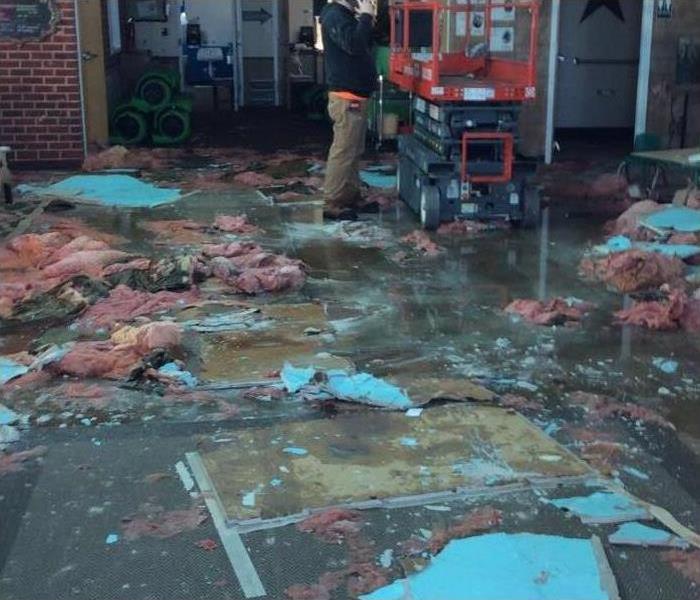 Storm damage in Overland Park, KS
Storm damage in Overland Park, KS
Commercial property insurance is a vital resource for protecting your Overland Park, KS, business from serious financial losses. A comprehensive plan is generally best, but does it provide all the coverage you need? If you live in an area where storms are an issue, you may want to consider the value of commercial storm insurance.
What Does Storm Coverage Pay For?
Some commercial insurance coverage provides financial compensation for damages caused by storms. There are some exceptions to this type of protection, however. Some of the most common areas in question include:
- Normal wear and tear. Storm coverage isn't likely to cover damages caused by aging or heavy use. You'll need to show that damage was the direct result of the storm. This goes for your roof and other systems throughout the building.
- Contents of the building. Your business equipment, computers, inventory, and even furnishings are usually covered. Before a storm hits, be sure the coverage is high enough in case of a total loss. Most insurance policies place a specific dollar amount for the contents coverage.
- Cleanup and restoration. Some insurance companies offer a dollar amount for the value of your business, but some pay a percentage only after you have paid a certain out-of-pocket amount. Discuss this with your storm insurance provider. Whether you're facing repairs or complete rebuilding, you may find that restoration professionals are a valuable resource.
- Trees and wind-carried debris. Heavy winds can cause a lot of damage, whether it's from a tree dropped onto your roof or a swimming pool from a neighborhood near your building. The insurance coverage may pay for the cost of removal and any damage, but only if there's a direct relationship between the storm and the damage.
What Does Your Plan Cover?
Do you know what is covered by your storm insurance? If not, you should talk with your insurance provider before hurricane and storm season settles in. As the storm passes and summer works its way closer, many neighborhoods in Overland Park, KS, will feel the effects of heavy weather. Make sure your business is protected with the right coverage.
Tips for Cleaning and Deodorizing Your Microwave
9/23/2020 (Permalink)
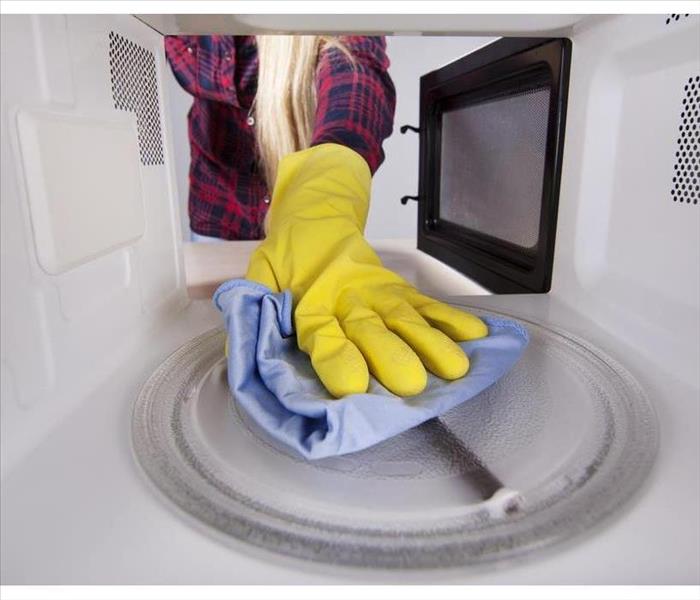 Clean regularly your microwave
Clean regularly your microwave
A dirty microwave is not only gross. It could also spark a fire in your Overland Park, KS, home. If you notice a smoke smell coming from the appliance, it may be time for a cleaning. Other parts of the appliance may need to be replaced entirely.
What To Clean
Cleaning the inside of the appliance is fairly straightforward. All you need is:
- A bowl
- A cloth
- Water
- Vinegar or lemon juice
Start by combing water and vinegar in a bowl. Put the bowl into the appliance and turn on the heat. This should loosen the food from the walls and base. You can then just wipe away the food with a non-abrasive cloth. You may want to use lemon juice instead of vinegar, as the former is particularly effective at removing smoke smell.
The grease filter can get particularly dirty and should be cleaned more frequently. Once a month, let the filter soak in a mixture of detergent and hot water. Then scrub away any remaining debris.
What To Replace
Unlike the rest of the appliance, the charcoal filters cannot be cleaned. If the appliance's hood re-circulates air, you need to change the filters every six months. Replacing the filters is less important if the air ventilates outside the home.
The charcoal filters are often found behind the vent grill. You can buy new filters from the appliance's manufacturer.
The light bulbs inside the appliance should also be replaced whenever they stop working. Your usual manual should provide step-by-step instructions to help you complete this task.
Even if you remove the smoke smell from your microwave, a fire may still occur. Putting the wrong container into the appliance may spark a blaze. That is why you should know the contact information for your local fire damage cleanup company. Restoration experts can get your home back to normal no matter the cause of the flames.
Reducing the Spread of Mold Through Your Commercial Facility
9/1/2020 (Permalink)
 Shut off the water supply
Shut off the water supply
Four Ways To Combat The Spread Of Mold In Your Building
Before you panic about the significance of finding black mold in your facility, know that not all species of mold are toxic, even if the color looks it. While the mold is most likely not a poisonous variety, it stills presents a significant risk to your facility. There are at least four ways you can combat the spread of mold in your building.
- Shut off the water supply
- Turn off HVAC systems
- Close off the space
- Contact a Mold Remediation Company
Shut Off the Water Supply
Most mold infestations stem from a moisture problem, often created by a plumbing issue. Therefore, to prevent further contamination of the affected space, shut off the water supply lines that may be running through the area. If you are unsure of which supply lines cut through the room, consider shutting off the water main until the problem is resolved.
Turn Off HVAC Systems
Mold spores are microscopic organisms, and they exist everywhere, traveling on air currents. If your building has existing mold growth, you should control the spread from the infestation to other areas in your building. You can best accomplish the reduction in the spread of black mold spores by turning off the HVAC systems until the mold is removed.
Close Off the Space
To further limit the spread of the infestation, consider closing off the affected area. Shut all doors and close all windows. Do not permit entry into the area until after it is cleaned and sanitized.
Contact a Mold Remediation Company
Contact a mold remediation company in Overland Park, KS, to resolve the problem. The company will send out a crew to test the facility and assess the damage before beginning the mold cleanup.
While not every black mold species is toxic, a level of trepidation is responsible. Mold removal is not a DIY job. If you find mold in your building, contact a remediation company for immediate assistance.
2 Plumbing Fixes Landlords Should Know
9/1/2020 (Permalink)
 If you notice your faucet has been leaking you should repair it as soon as possible
If you notice your faucet has been leaking you should repair it as soon as possible
Quick Repairs a Landlord Will Probably Have To Do
Plumbing issues can occur in rental properties, especially if you have older pipes, like polybutylene pipes. Although some issues will require a plumber, you should be able to handle some things on your own. This can save you from having to hire remediation professionals to repair extensive damage. Here are a couple of quick repairs you will probably have to do while you are a landlord.
1. Leaky Faucets
When a faucet leaks, it is generally due to one of two reasons. It could be that the nuts at the base of the faucet are loose and need to be tightened. If that doesn't fix it, the faucet is probably leaking because the washer inside the handle is worn and needs to be replaced. To make this repair, you should start by turning off the water supply to the sink. Use caution if you have older plumbing, such as polybutylene pipes. Once the water is off, remove the faucet handle by undoing the screws. Sometimes these screws may be hidden or under a plastic cap. Once you get the handle off, you will find the old washer. Simply replace the washer with a new one and replace the handle. This simple trick could prevent water damage to your property.
2. Clogged Toilets
Luckily, tenets should be able to take care of clogged toilets on their own, especially if you left them a plunger. If you have a tenet call you for a stubborn clog, ask him to wait ten minutes. Then, have him try again, making sure that he covers the hole completely with the plunger to get a good seal. If this doesn't work, you may want to try with a snake. Simply put the wire snake down the hole until you feel the clog. Turn the snake clockwise to grab the clog and pull it out.
If you have older plumbing, like polybutylene pipes, you are going to encounter some issues. However, if you know how to do some basic fixes, you can save yourself time and money as a landlord in Leawood, KS.
How To Protect Your Business Against Rising Flood Waters
9/1/2020 (Permalink)
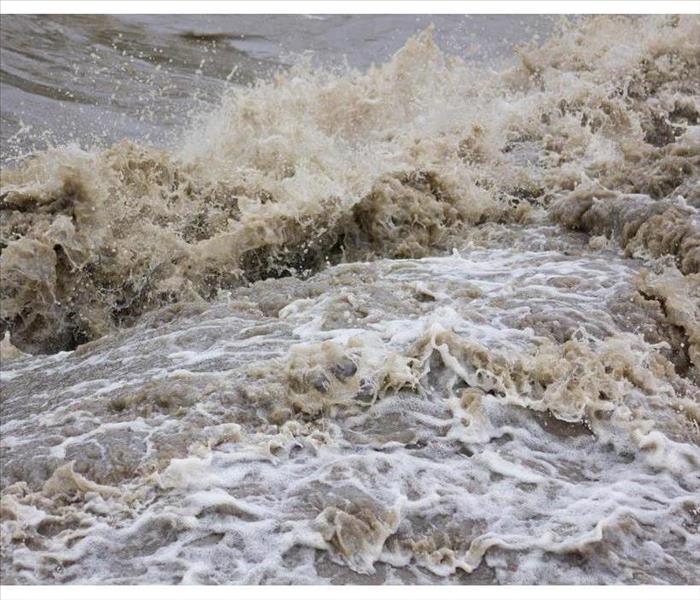 Floodwaters in Prairie Village, KS
Floodwaters in Prairie Village, KS
Does Your Company Operate Out Of A Flood Zone?
If so, flood damage is likely a significant concern. Many businesses lose thousands in equipment damage and recovery costs every year because they were not prepared for flooding. If rising waters concern you, then reach out to a local storm remediation specialist in Prairie Village, KS, to discuss preventive options.most of these companies will suggest four potential methods for securing your business.
1. Move
Moving your company because of potential storm damage may sound ludicrous, but it makes sense, especially for areas more susceptible to frequent flooding. By moving your facility to a less volatile flood zone, you reduce your risk of recovery expenses and property loss. If you do not want to move out of the area, consider finding a building on higher ground.
2. Build Barriers
Flood damage is a result of rising water levels. Thankfully, it is possible to limit the water's ability to reach your facility by building Barriers around the property. While you can install permanent Barriers, the more popular method is piling sandbags around the facility or vulnerable entry points. The bags act as a deterrent or diverter for the floodwater, protecting your building.
3. Work Above Water Levels
If your facility has a second floor, then consider moving all sensitive equipment to that level and working from there, especially if you know a flood is coming. While it is not necessary to keep equipment on a higher floor permanently, you should move it when a flood is imminent, limiting the expense and difficulty of data replacement and recovery.
4. Install Necessary Equipment
You can install plumbing devices to limit the potential damage of a flood. Backwater valves and sump pumps are two pieces of equipment that help to reduce flood risk.
If you are concerned about potential flood damage, then take appropriate preventative action. Contact a storm mitigation company to discuss specific measures with your facility.
4 Ways To Prevent Residential Flooding
8/12/2020 (Permalink)
 Make sure downspouts are extended to at least three feet away from your house to avoid flooding in your home
Make sure downspouts are extended to at least three feet away from your house to avoid flooding in your home
Four Ways To Protect Your Property By Making Changes To Your Landscape
Outside flooding is common after a heavy storm. When water does not have vegetation to slow it down or porous surfaces to sink into, floods can move quickly across your yard. Unfortunately, fast-moving water can destroy your landscape. Perhaps even worse, water can pool near the foundation of your home and cause damage to the inside. Here are four ways you can protect your property by making changes to your landscape.
1. Rain Gardens
Rain gardens can be an aesthetically pleasing way to give water a place to pool during a rain storm. Use native plants to make an effective and low maintenance rain garden. Since water will dry up around the edges first, place the plants that are the most water tolerant toward the middle of the garden.
2. Mulch
Light mulch, such as pine, can be swept away and scattered across your property during outside flooding. Heavier mulch is much less likely to be disturbed during a storm. Mulch made from man-made materials or hardwood is both good options for areas with heavy rain.
3. Rain Spouts
When solutions for rain drainage are not properly planned, moisture can pool around the foundation of your home. Water against the side of your house can lead to unwanted moisture in your basement or crawlspace. By using rain spouts that extend several feet from your home, you can minimize the chance that water will gather near your foundation.
4. Green Roofs
If you have a flat or gently sloped roof, you can install special modular units that are covered with vegetation. These living roofs absorb much of the rain water and contain a waterproofing membrane that protects your home. Green roofs are also reported to lower electricity costs and regulate the temperature inside your home.
Luckily, there are measures you can take to reduce the likelihood of outside flooding. However, problems can still occur. If you have experienced flood damage in Prairie Village, KS, a professional flood remediation company can help to quickly restore your home to its pre-flood condition.
Is Mold Certification Essential To Become a “Preferred Vendor?”
7/28/2020 (Permalink)
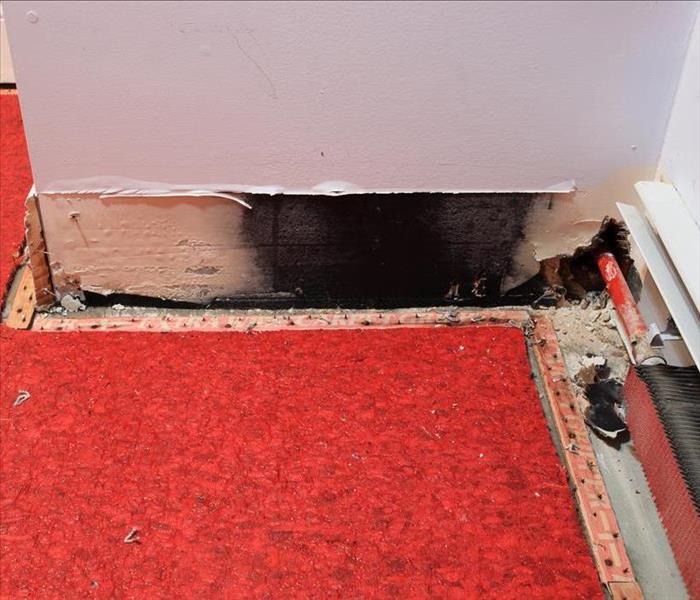 Mold damage behind baseboard in Leawood, KS
Mold damage behind baseboard in Leawood, KS
If you suspect you have mold in your home, it’s important to choose a company with certified mold experts that insurance companies recognize as reliable. The easiest way to do that is to select a “Preferred Vendor.”
What Causes Mold?
After a flood or a water leak in Leawood, KS, certified mold inspectors report finding hidden mold in many homes. It can grow on many porous surfaces:
- Drywall
- Wood
- Paper
- Paneling
- Carpet
How Does Mold Get In?
It is found everywhere. Mold spores are in all the air we breathe, which sounds a little terrifying. However, almost all of it is harmless.
Black mold is a special type of fungus that mostly grows indoors and can be harmful. It can get out of control, eating away gypsum walls and even degrading the wood studs that help support the building's structure.
What Can You Do?
A certified mold expert will use special equipment, including a hygrometer, to search out hidden growth. If you’ve had water damage or can smell a musty odor in an area, you probably need to have an inspection.
Who Should Do an Inspection?
You need a company that’s qualified by the Institute of Inspection Cleaning and Restoration Certification. Technicians have to complete IICRC mold certification and have the right experience to determine if a mold problem exists in your home.
What Happens if Mold Is Found?
Another reason to choose a preferred vendor is that they must provide certified mold remediation as well as inspections. Insurance companies have strict requirements for restoration, including IICRC compliance, that earns the "Preferred Vendor" label.
Only the top water damage remediation companies in Leawood, KS, can earn the right to be listed as preferred. They have a detailed workbook to perform certified mold remediation. Specialized air movers and drying equipment will suck out the moisture and prevent further growth.
Once the cause of the water damage is addressed, a team of restoration professionals will repair what can be saved and replace what can’t. The best vendors will have hospital-grade disinfectant agents that kill mold and germs. Once the mold has been removed, it won’t grow again without access to moisture.
Use This Basic First Aid Advice for Burns at the Workplace
7/6/2020 (Permalink)
 React fast when you get burned by fire damage
React fast when you get burned by fire damage
Potential consequences from fire damage at an Overland Park, KS, commercial location include burn injuries. Your employees or customers can be harmed by fire at any point, so it is important to act appropriately and fast before the burn escalates and severely affects the victim. Use this first aid advice to identify the type of burn and treat it correctly.
Signs of Minor and Major Burns
Minor and major burns are different injury types that require specific treatments. You may be dealing with a minor burn if the following signs are present:
- Pain
- Blisters
- Superficial damage
- Sunburn-like redness
- No bigger than three inches
While immediate treatment is necessary, it does not require emergency services. However, if the burn is deep and larger than three inches, causes the skin to be dry and leathery and contains brown, black or white patches, it is a major burn. You will need to call 911 right away.
Minor Burn Treatment
Sometimes, the only results from a minor incident are some fire damage and minor burns. While an immediate response is needed for someone who suffers these injuries, it does not require calling emergency services. Reduce the pain by applying a wet, cool compress or running it over water. After that, gently remove any present jewelry and apply an aloe vera lotion to stop drying. Avoid breaking the blisters and apply antibiotics if you do. Finally, cover the affected area with a sterile bandage to protect it.
Major Burn Treatment
Keep 911 information at hand, alongside other important contact information like insurance and emergency remediation services. After calling, mitigate the injury with burn first aid while you wait. As before, remove the jewelry and other areas by the affected area carefully and cover it with a cool cloth or bandage. Avoid submerging it with water, as it can cause hypothermia. Elevate the injury and watch for signs of shock and breathing shortage.
It is important to react fast after anyone gets burned following fire damage. Follow first aid procedures to ensure the injury heals properly.
Black Mold: Understanding Secondary Damage
5/26/2020 (Permalink)
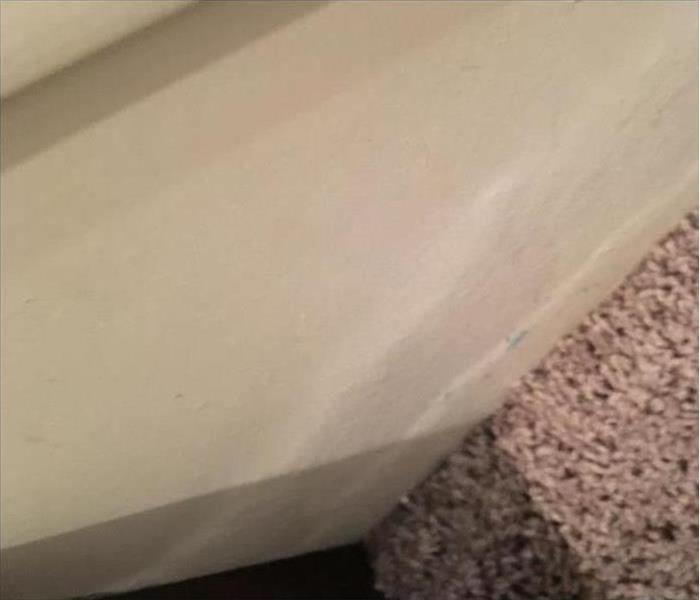 Water damage can cause mold
Water damage can cause mold
In cases where your house in Overland Park, KS has been damaged by a flooded area causing high humidity within your home, there are secondary damage factors that are important to understand and remove. One of the most prominent of these factors is black mold. You don’t want to get caught out months down the line having to repair mold damage that could have been taken care of in the initial repair stages.
What Incidents To Be Aware of
These are a few of the most common types of water-related occurrences that are likely to lead to spore-related damage:
- Roof or wall leak
- Pipe leak either in the walls or in a sink cabinet
- Partial or full flooding of a room
- Poorly ventilated bathrooms
- Humidity due to aquariums or weather conditions
Keep in mind that these are the types of incidents that could lead to black mold living in your home. If you want to be certain of any mold presence from high humidity in your home, you can seek the advice of a professional water clean up and restoration service.
What Is Secondary Damage Doing To My Home?
Unfortunately, after a primary damage factor such as flooding, the aftereffects could be just as bad or worse than the initial problem. The spores that attach inside the walls or across the ceiling in your home could be creating soft spots that need to be repaired or completely replaced in the future. More than just creating a home for mold, water damage can lead to such issues as walls buckling, drywall cracking and splitting apart or vinyl flooring pulling away from the ground. All of these issues can be frustrating but are more easily avoided if the primary damage is taken care of quickly and efficiently.
While there are many types of secondary damage caused by water-related incidents, one that is particularly difficult to deal with is black mold. Assessing the likelihood of spore presence in your home directly after an incident can help you take care of a problem before it takes hold of your home.
Johnson County Residents need Soot and Smoke Cleanup!
5/25/2020 (Permalink)
Smoke and soot is very invasive and can penetrate various cavities within your home or business, causing hidden damage and odor. Our smoke damage expertise and experience allows us to inspect and accurately assess the extent of the damage to develop a comprehensive plan of action.
Smoke and soot facts:
- Hot smoke migrates to cooler areas and upper levels of a structure.
- Smoke flows around plumbing systems, seeping through the holes used by pipes to go from floor to floor.
- The type of smoke may greatly affect the restoration process.
Different Types of Smoke
There are two different types of smoke–wet and dry. As a result, there are different types of soot residue after a fire. Before restoration begins, SERVPRO of Leawood/Overland Park will test the soot to determine which type of smoke damage occurred. The cleaning procedures will then be based on the information identified during pretesting.
Here is some additional information:
Wet Smoke – Plastic and Rubber
- Low heat, smoldering, pungent odor, sticky, smeary. Smoke webs are more difficult to clean.
Dry Smoke – Paper and Wood
- Fast burning, high temperatures, heat rises therefore smoke rises.
Protein Fire Residue – Produced by evaporation of material rather than from a fire
- Virtually invisible, discolors paints and varnishes, extreme pungent odor.
Our Fire Damage Restoration Services
Since each smoke and fire damage situation is a little different, each one requires a unique solution tailored for the specific conditions. We have the equipment, expertise, and experience to restore your fire and smoke damage. We will also treat your family with empathy and respect and your property with care.
SERVPRO of Leawood/Overland Park has been helping families and businesses throughout the Northland with their cleanup and restoration needs for over 15 years.
Have Questions about Fire, Smoke, or Soot Damage?
Call Us Today – (913) 381-6550
Cleaning Up Commercial Sewage Spills
5/11/2020 (Permalink)
 A sewer cleanup is a problem that requires high tech equipment and specialized knowledge
A sewer cleanup is a problem that requires high tech equipment and specialized knowledge
Here Are Three Things To Know About The Process
Yes, it's gross. No one wants to deal with a sewer cleanup. The filth is everywhere, seeping into the carpets, drywall, and fixtures. Without a doubt, the water is contaminated with high levels of microorganisms, making the establishment a major hazard for employees and clients. This isn't the job for a few cans of bleach. Rather, business owners in Overland Park, KS, should turn to a reputable water restoration company. The team can work to sanitize the building and belongings. Here are three things to know about the process.
1. Establish Boundaries
When a sewer backup happens, the moisture gets much further than you'd suspect. Within a very short amount of time, the liquid penetrates into the foundation and walls, making its way to other rooms or crevices. When the crew arrives, they can inspect the area, evaluating the depth of the problem. Then, they can section off rooms that have issues. No one without authorization goes in or out. Because of the bacteria and fungal growths, these spaces are now cut off.
2. Dry It Up, and Tear It Out
Part of sewer cleanup is removing heavily saturated porous items. The experts, most likely, will take out the drenched carpeting and baseboards. This not only removes much of the pollution, but it helps to speed up the drying process. Other materials can be relocated for content cleaning purposes. Finally, the rooms must be aired out, usually with professional dehumidifiers.
3. Replace and Restore
Even a flooded toilet can make quite the mess. With the room now bone dry, the staff members get to work spraying the area with antimicrobial chemicals, refusing to let anything remain. Then, anything salvaged is brought back in only after a meticulous scrubbing. New items are bought and installed.
A sewer cleanup is a problem that requires high tech equipment and specialized knowledge. You'll need to limit movement and gut the spaces. With that complete, the business can be put back together again.
What Happens During Mold Remediation?
5/11/2020 (Permalink)
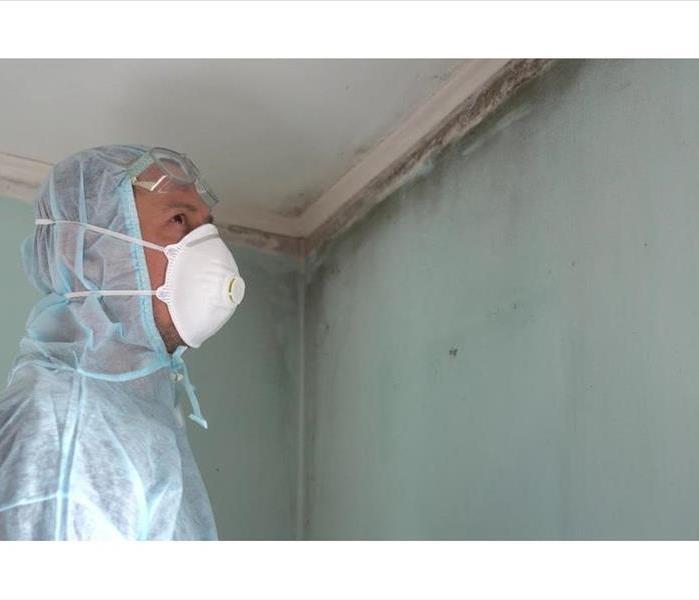 Mold remediation is a process that starts with inspection and assessment
Mold remediation is a process that starts with inspection and assessment
Mold remediation is a process that starts with inspection and assessment and continues through containment, cleaning, and restoration. While some services refer to remediation as mold removal, this terminology is not accurate. Mold spores are everywhere. Stopping active growth and preventing old growth from causing a problem if moisture levels rise are the goals of cleanup.
Damage Assessment
An assessment will identify whether mold is present in a building. Several methods may be used to locate and determine the extent of an infestation:
- Visual inspection
- Inspection tools
- Sample analysis
Visual inspection locates mold that can be found without specialized equipment. A boroscope or infrared imaging technology can reveal mold behind walls. An assessment will also determine the square footage affected by an infestation.
Mold Containment
Containing the contaminated portion of a structure stops spores from spreading. After shutting down the HVAC system, remediation specialists may create negative pressurization and use plastic sheeting to isolate the affected area. Toxigenic infestations, such as some varieties of black mold, require a decontamination chamber.
Structural Cleaning
After a mold problem has been contained, trained professionals can start cleaning. Drywall, cellulose insulation, and other porous building materials may need to be torn out and replaced. The use of EPA-approved fungicides may be necessary for mold removal.
Content Cleaning
Mold also contaminates contents. Durable, non-porous items are easy to disinfect. Porous materials may require more gentle methods. It may be more cost-effective to replace some contaminated items.
Restoration
Replacing building materials that have been torn out is the final stage of mold cleanup. Property owners should consider mold-resistant alternatives to reduce the risk of future infestations.
If water damage has led to mold growth at a commercial property in Leawood, KS, the building owner should arrange for an inspection. Keep in mind that remediation, rather than mold removal, is the only process for managing a mold problem.
Landscaping Tips to Prevent Flooding
4/29/2020 (Permalink)
 Rain garden
Rain garden
Tips to Prevent Flooding
Heavy rains can mean big troubles for homeowners in Prairie Village, KS. While there are many ways to reinforce basements, foundations, and other structural components, which often can be expensive, landscaping is another way to keep outside flooding from coming in. Along with minimizing damage from a rain storm, add some natural elements can also enhance a home’s curb appeal.
Changing the Landscape
Rain drainage is the main culprit behind water entering the home. Along with ensuring gutters are regularly clean and free from blockage, nature itself can be used to assist stormwater runoff.
Swales: These are depressions in the ground that contour around a slope to direct water to another place. They can be natural or manmade and rely on gravity to move water. Since they are not designed to absorb water, rocks and plants can be used to smooth the flow as the water heads to an ideal location.
Rain Gardens: Often the end source of a swale, these provide a place for water to pool and slowly enter the soil. They can range in size, depending on a home’s needs, and can be maximized by using native plants that require minimal maintenance.
Greenery: The addition of perennials and shrubs not only add curb appeal, but they also work to absorb stormwater runoff. Work with a local garden center to find ideal moisture-tolerant plants.
Additional Materials
When outside flooding is an issue, materials are available to enhance landscaping and keep the water going where it should. It can be as simple as added heavy mulch around the foundation in areas where the soil is visible or investing in pervious paving solutions that can help create a patio oasis and reduce standing water.
In extreme cases of outside flooding, keeping the water out may be impossible and require the assistance of a flood and stormwater specialist. Making a few landscaping changes may be a solution to minimize the damage.
Insurance Companies Use 5 Basic Factors to Estimate Fire Damage
4/20/2020 (Permalink)
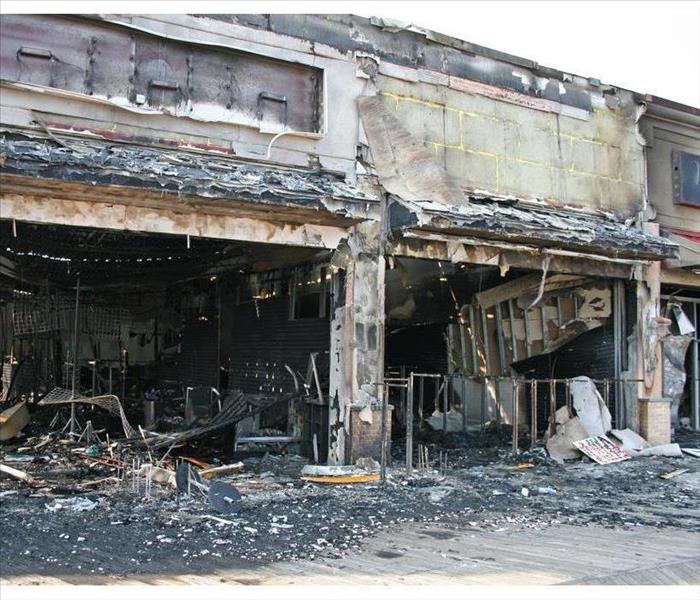 Commercial fire in Leawood, KS
Commercial fire in Leawood, KS
Insurance Companies Use 5 Basic Factors to Estimate Fire Damage
After a commercial fire in Leawood, KS, your first thoughts should be about preventing more damage. Typically, this includes tarping and boarding areas exposed to the weather, plus keeping employees and customers away from smoke and fire damage.
After things have been stabilized, you’ll need to get an estimate on the cost of restoration. Broadly speaking, this cost will be based on five factors:
- Cost of lost structure
- Cost of lost personal items
- Amount of fire damage
- Amount of smoke damage
- Amount of water damage
1. The Value of the Commercial Structure Is Most Relevant
Obviously, an older building with 1,000 square feet won’t cost as much to replace as a larger, newer one. Some policies will cover a full replacement of the building, while others will only pay for market value of the lost areas. Make sure the estimate you’re given matches what the policy covers.
2. Your Policy May Cover Personal Items
Some insurance companies cover personal property as a matter of course, while others may require a rider. Review your coverage with your agent for clarification.
3. Fire Damage Is the Most Obvious
While there can be hidden heat damage, most of the time the areas burned are fairly obvious. This is always covered by a commercial policy, except in cases of arson.
4. Smoke Gets Everywhere in a Fire
Smoke damage can be hidden and is commonly found far beyond the limit of the flames. This is also always covered.
5. Water Damage Can Be the Most Extensive
In a major fire, huge amounts of water are used to smother the flames. All the impacted drywall and wood will absorb standing water, usually requiring replacement. Mold damage is also normal after a fire. Water damage directly from firefighting efforts is always covered, but mold may or may not be.
Also, beware of low-ball estimates. Less reputable companies like to tempt business owners with unrealistic prices, then add on all sorts of extras. Always use an experienced, professional local company with realistic costs to restore your business to its former condition.
How Do You Care for Wet Items After Water Damage?
4/16/2020 (Permalink)
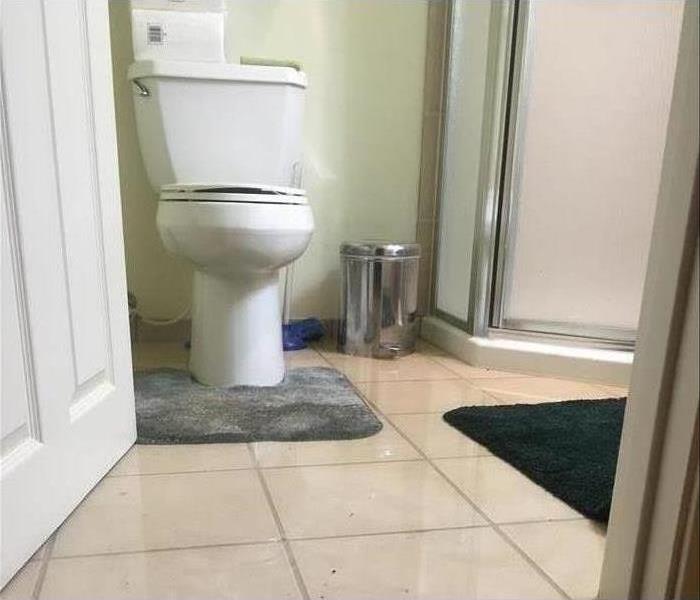 Bathroom flooding in an Overland Park, KS home
Bathroom flooding in an Overland Park, KS home
Steps to Keep Your Items Safe After Water Damage
When you have water in your home in Overland Park, KS, it is likely that some of your belongings will be affected by the water. There are certain steps you can take in order to keep your items safe.
1. Eliminate the Source of Water
Before you can begin to assess what damage has occurred and start taking care of your items, you should make sure that water does not continue to flood your home if possible. If the water is coming from a broken pipe, for example, turning off the water entirely is likely the quickest way to stop the flow of water. By stopping the source of water, you can prevent additional items from becoming damaged.
2. Allow Items to Dry
Once the water in your home has been removed, you may be tempted to start moving items and cleaning what has been damaged immediately. However, some of your belongings may need to dry before they can be restored. For example, documents and photographs should be handled when dry in order to prevent further damage, cushions and cloth items can be more manageable to move when dry.
3. Appropriately Sanitize Items
When the area affected by water is dry in your home, you can begin make a better assessment of what can be cleaned and what should be replaced. Items that are not badly damaged and that are not affected by mold may only require dry cleaning, which is a relatively quick process. However, you may need to use strong cleaning products on items if they have been left in standing water. When choosing how to sanitize your belongings, it’s often helpful to make sure you are using the appropriate product on each item.
Knowing the appropriate steps to take if water in your home has damaged items can help you feel more prepared. As you begin to clean your personal belongings, it may be helpful to contact water damage professionals who can help to restore your home and your belongings.
Create a Continuity Plan for Your Business
4/9/2020 (Permalink)
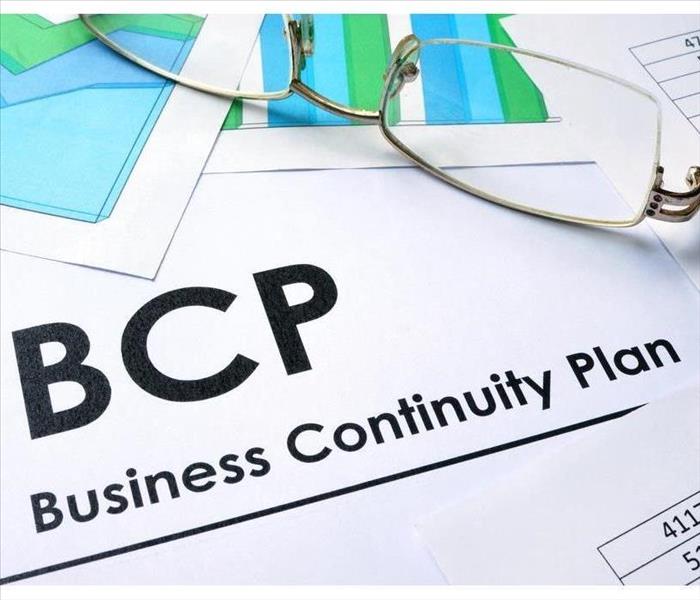 Creating a business continuity plan will help mitigate the costs in case of an emergency
Creating a business continuity plan will help mitigate the costs in case of an emergency
When business operations are interrupted by weather events or other emergencies, your company in Prairie Village, KS can incur unforeseen expenses and reduced revenues. It’s important to be as prepared as possible so that your company and employees are protected. Creating a business continuity plan will help mitigate the costs in case of an emergency.
Create a Business Impact Study
The first step in developing a business continuity plan is to conduct a risk assessment. Include managers or other members from each department to complete the assessment. Risks to be considered include:
- Fires
- Storm damage events, such as flooding, tornadoes, and hurricanes
- Utility outages or cyber attack
- Hazardous material spills
- Supply chain interruptions
The risk assessment should also include the operational impact and financial consequence of each risk. Using a numerical formula to rate the impacts will identify those areas of highest concern.
Develop Strategies for Recovery
The next step is to identify the resources that will be needed to mitigate the recovery. Resources include:
- Employees who will help with the recovery, including what their role will be
- Technology, such as computers and software
- Office furniture and other equipment
- Inventory and production facilities
- Supply chain services
- Utilities
The recovery strategy must also include a gap analysis. This analysis will identify the gaps between the requirements needed for recovery and the adequacy of the current system.
Design a Plan
Once you have identified the risks and corresponding impacts, along with the resources needed for recovery, it’s time to develop the plan. Steps include:
- Assigning recovery teams
- Designing the framework for the plan, including relocation arrangements
- Writing procedures for continuity and disaster recovery
- Completing and approving the written plan
Test the Plan
In order for the plan to be successful in an actual emergency, it must be tested. Develop procedures for testing the system and conduct training with all employees.
Every business owner needs to be prepared in case of an emergency and a continuity plan will help to ease concerns.
Why Is There Mold in My Home After a Rainstorm?
3/26/2020 (Permalink)
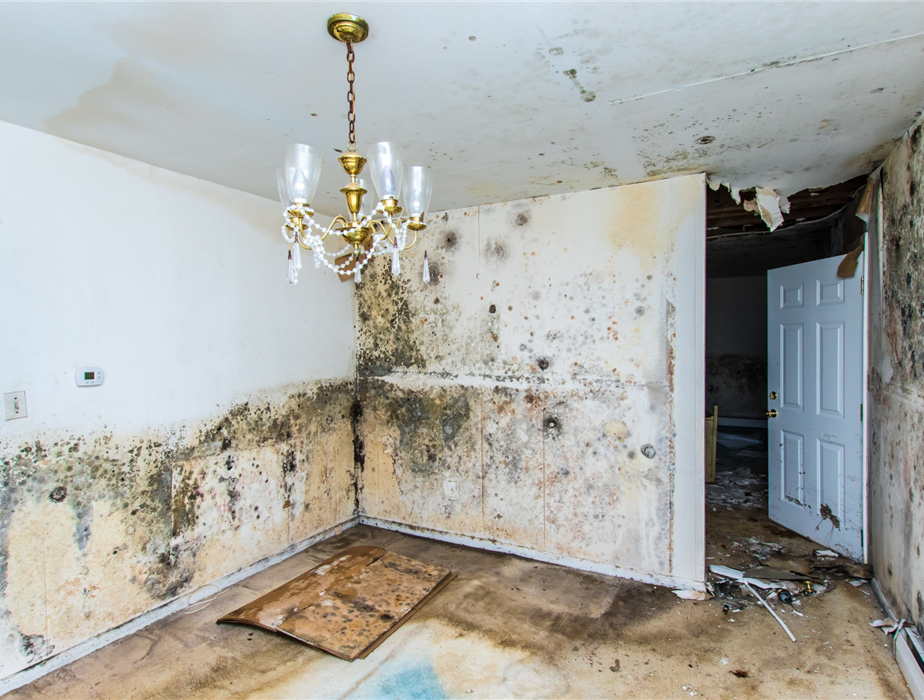 Mold infestation in a home
Mold infestation in a home
Why Is There Mold in My Home After a Rainstorm?
Have you ever noticed black mold in your Leawood, KS, house after a rainstorm? This is probably evidence of a moisture problem in your home. The rain is somehow entering your property, leading to mold damage.
Mold growth is evidence of a moisture problem. If you do see or smell mold in your home after it rains, you should check the below areas for possible leaks:
- Crawlspace
- Attic
- Roof
- Basement
Once you have located the source of the mold, it is not enough to just wipe the fungus away. A more thorough mold cleanup is needed.
Cleaning Mold
If you only have a small amount of mold in your house, you may be able to handle it yourself. Try combining a half-cup of Borax with the same amount of white vinegar. Add two cups of warm water and pour it over the mold. Let the liquid sit on top of the mold for 10 minutes before trying to scrub it away. This both kills the present mold spores and prevents them from coming back.
Black mold and severe mold infestations should not be handled by an amateur. Instead, you should rely on mold remediation professionals. They can both remove the mold and fix the source of the water leak.
Preventing Mold
While you should not do black mold cleanup on your own, you can take steps to limit the growth of this mold. Obviously, you should check for roof leaks regularly and address them before the next rainstorm arrives. You may also want to invest in a dehumidifier to remove any excess moisture in the air. Ventilation and ceiling fans can help, as well.
Black mold after a rainstorm usually signifies a water leak in your home. The mold must be removed from the house, and the leak must be addressed to prevent the spores from returning. Cleaning professionals can perform these tasks safely and effectively.
Teaching Kids How to Escape a House Fire
2/26/2020 (Permalink)
 Keep children away from cooking areas
Keep children away from cooking areas
It's hard to think of many more dire emergencies than a house fire. This would be a frightening ordeal for anyone, especially for parents with young children. Kids safety is critical during these moments, so make sure you have an escape plan for your family. If your kids know how to safely get out during a fire, you can rest easy at night and have peace of mind.
Talk About Fire Safety
Before you teach your children home to get out of a home fire, it may be helpful to go over some fire prevention ideas. If people in your house are conscientious and careful in the first place, you may never have to worry about this situation. Talk to your kids about these ways to reduce fire risks:
- Do not play with matches or lighters.
- Keep flammable materials away from stoves and fireplaces.
- Do not try to move candles.
Identify Exits
Your children need to know where to get out of your Prairie Village, KS, home if a fire starts. Kids safety should include showing children to the closest exit to their bedroom and other common rooms in the house.
Talk About Knowing Where the Fire Is
Show your children how to feel doors for the heat of a fire. This will help ensure that they do not exit their bedroom if it is unsafe. Kids should also know about keeping low to the ground, away from harmful smoke.
Develop a Plan and Go Over It
As a family, you should establish a fire escape plan. Draw out escape routes and choose a meeting place safely away from the house. Practice this plan at least once a year so everyone feels comfortable with the process. Time yourself so your kids can do it quickly.
You never want to place a call to a professional fire cleanup crew to restore your house after a fire. Still, if a fire does start, you can feel good knowing you have practiced kids safety and that your family knows how to safely exit your house.
Water Conservation Tips for Your Commercial Property
2/14/2020 (Permalink)
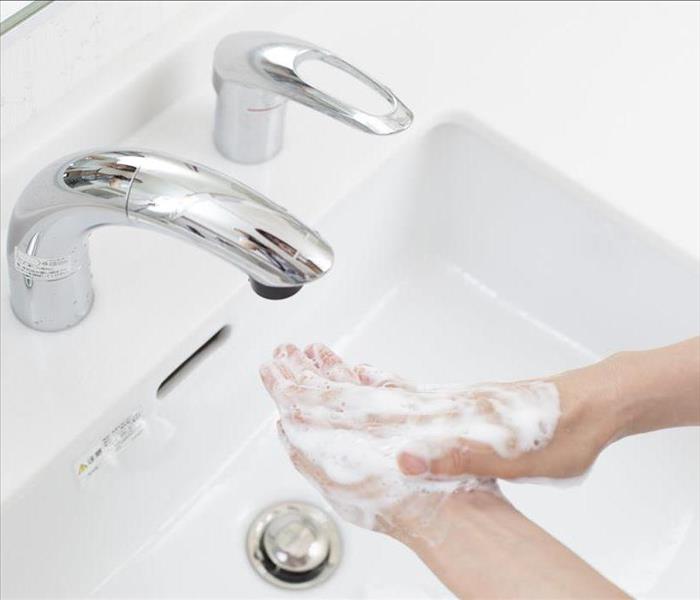 Automatic faucets are expensive, but they can be a worthwhile investment
Automatic faucets are expensive, but they can be a worthwhile investment
Water Conservation Tips for Your Commercial Property
While water services are necessary for any commercial building, they can also be expensive. Every toilet flush or running faucet takes money out of your company's profits. Plus, if a leak or other disaster causes water damage, you may have to pay for emergency restoration services.
Luckily, there are steps you can take to limit the amount of water you use in your Leawood, KS, commercial facility. These tips will also come in handy if droughts or water issues limit your supply of H2O.
1. Adjust Your Faucets
Automatic faucets are expensive, but they can be a worthwhile investment. They turn on by themselves and only stay on for a set amount of time. You thus don’t have to worry about your employees leaving the water running.
These faucets don’t just save money, either. Since workers won't have to touch faucet handles, their germs won’t spread as easily.
If this water upgrade costs too much money, you can also just adjust the faucet aerator. A typical aerator uses 2.2 gallons per minute (gpm), which is almost the same amount of water utilized by a shower. Simply switching to a 0.5 gpm aerator can reduce your bathroom water usage by 80 percent.
2. Maintain Your Irrigation System
If your commercial building has an irrigation system, you should check it regularly for leaks or other water issues. Make sure the sprinklers are pointed at your actual grass and not the sidewalks or parking lot. You may also want to consider utilizing drip irrigation, which is more efficient than the spray type.
3. Remove Water-Intensive Plants
Annual plants may be pretty additions to your office, but they also use a lot of water. Consider swapping them out for colorful plants that require less water and last for a longer period of time. This will reduce your landscaping costs, as well.
These strategies should allow you to keep your building functioning properly even if there are water issues in your area. They will also save you money on your water bill.
How to Properly Snake a Clogged Pipe
2/14/2020 (Permalink)
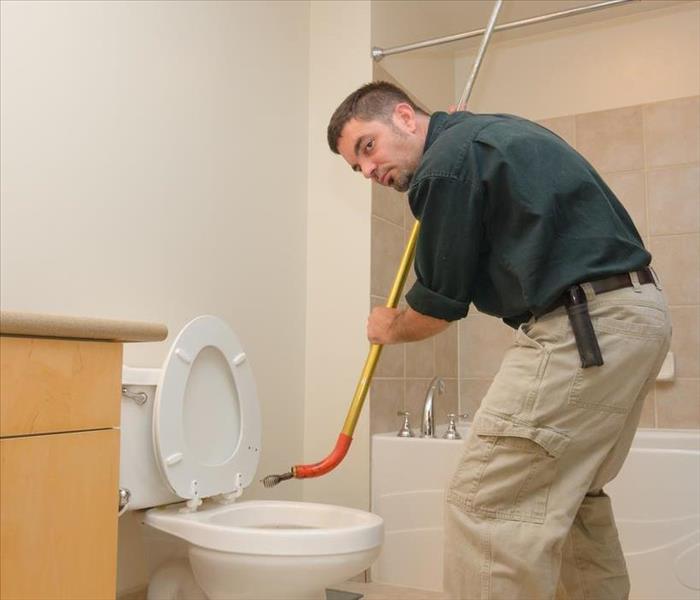 Using a drain snake will make the job easy
Using a drain snake will make the job easy
If you have tried fixing your clogged drain in Prairie Village, KS with conventional cleaning products or a plunger and the drain is still stopped, it is time to give a drain auger a try. Sometimes called a drain snake, this device has a heavy-duty steel coil cable that is pushed into the drain to break up the blockage and pull it out. Because the cable is made of flexible steel, it can bend around the curve of the pipe to go much deeper than an inflexible gadget can. There are many options available to purchase online, including manual and electrical models, but you can also rent one quite cheaply from a rental center. There are a few easy steps to follow to unclog your drain.
Steps in Using a Drain Snake
Place the snake into the opening of the drain and turn the drum handle. This allows the snake to start moving into the drain.
Keep cranking on the handle until there is some resistance. At this point, you may need to push a bit harder to allow the snake to go around the pipe curve. Just be careful not to apply too much pressure or it could cause a pipe break.
After going around the curve, the snake will hit up against the obstruction. If the clog is in one solid piece, the snake head will either break it into pieces or it will catch on the tip of the snake. Pulling the snake out will pull the clog out along with it. Any smaller pieces that had broken off the larger clog can be flushed down the drain.
Let the water run at full power for a couple of minutes. This will ensure that the drain is no longer clogged.
Most clogged drains can be fixed without having to call a plumber. Using a drain snake will make the job easy.
Is Secondary Damage Is a Major Concern?
1/23/2020 (Permalink)
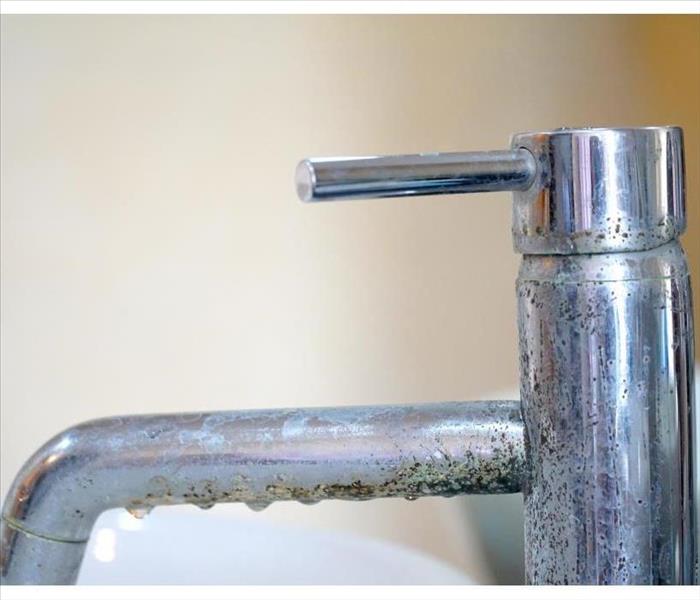 Mold grows around leaky pipes
Mold grows around leaky pipes
Three Important Points to Remember
When a faucet leaks or toilet overflows, your property experiences a primary event: an incident that creates damage to the establishment. Often, this seems minor and could be overlooked; however, if not cared for immediately, that moisture festers, activating fungus spores. Now, your business has an even more serious secondary problem: Black mold is growing. To prevent this headache, understand the likely sources and how to avoid contamination. Here are three important points to remember.
1. Stay Aware
As you prioritize your day or even week, don't neglect small situations. A little drip may seem harmless, yet it can be the sign of a very serious situation. That liquid accumulates, saturating material and potentially establishing high humidity in the vicinity. It's important, then, to keep eyes alert, regularly looking and inspecting the following fixtures:
In addition, notice chances in drywall, electrical equipment, and pipes. Signs of rust, corrosion or rot mean a hidden complication is arising. Call out a repair crew to locate the initial trouble.
2. Spores Spread
Black mold isn't slow. Once moisture and organize matter interact with the spores, the reproduction quickly begins. In fact, the microbes can grow rapidly within only a few days, migrating throughout your premises through air ducts and foot traffic. If you suspect a foul odor or observe growth, contact a water and mold remediation company in Overland Park, KS, to evaluate the rooms and begin restoration.
3. Trash It
Your primary occurrence has now led to costly and time-consuming secondary damage. This needs more than a wrench and a new part. Now, it's an overhaul. Polluted items must be removed from the location. Ask the experts about sanitizing procedures, and have them replace ruined materials.
Black mold is a hazard to your establishment, forcing businesses to shut down during repairs; therefore, be prudent and fix issues as soon as they occur. Minimize water exposure, and seek help as soon as you notice anything.
Understanding Mold and Remediation
1/9/2020 (Permalink)
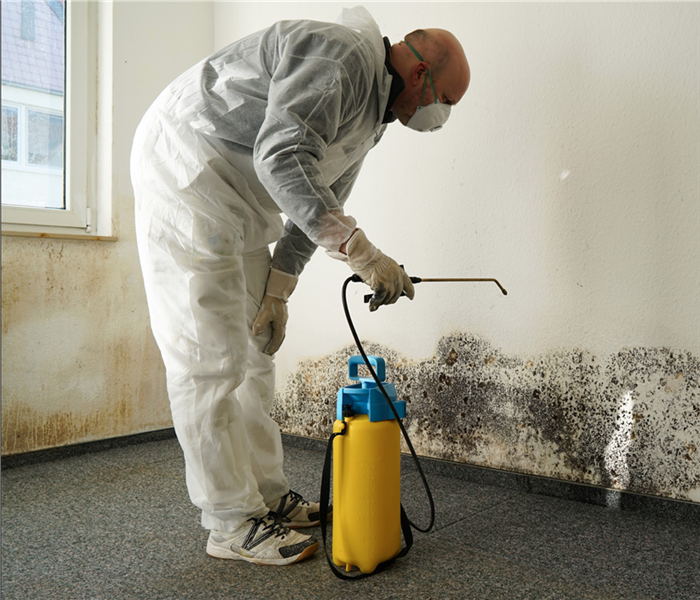 Specialist wearing protective gear while removing mold
Specialist wearing protective gear while removing mold
Mold growth is a concern for many commercial property owners, but how many owners actually understand what mold is? Also, when an owner comes across mold, how many understand the protocol for protecting their tenants and removal of the problem? Thankfully, these questions can be easily answered.
What is Mold?
Mold spores are the microscopic organisms that contribute to the fungal growth that appears on your building's walls, ceiling or floors. There are several types of mold, some are toxic, but others are more common and less harmful. However, every variety can cause significant damage.
What Leads to Mold Growth?
The severity of a mold problem depends on the environmental conditions of the facility when the spores root into a surface. If the building suffers from high humidity or water leaks, then mold will probably proliferate, becoming a severe infestation in as little as 48 hours.
What Equipment and Protective Gear is Required for Mold Removal?
When a mold infestation becomes severe, the remediation company in Prairie Village, KS, that you hire will probably have their team wearing protective clothing. For example, the removal crew will likely be wearing full bodysuits, gloves, goggles and respirators. Also, they will need supplies, such as plastic sheeting and garbage bags, for concealment and disposal.
Is a Remediation Specialist Necessary?
While some minor infestations may be completed on your own, those individuals who are trained and certified should perform most mold removals. You may want to hire a company, especially when the mold type is considered toxic.
Does Mold Removal Take a Long Time?
Mold removal generally takes three to seven days. However, depending on the severity of the infestation and the water damage that caused the initial problem, full restorations may take longer.
Mold growth is a concern for most property owners. However, understanding the fungus goes a long way in easing the anxiety and stress surrounding possible infestations.
3 Reasons to Get Security Fencing After a Fire
12/26/2019 (Permalink)
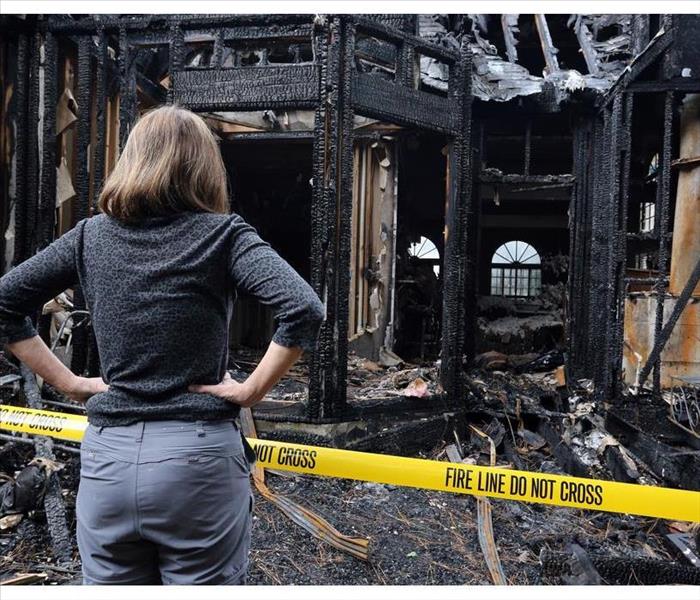 A security fence may seem like just one more thing, but it can truly save the day
A security fence may seem like just one more thing, but it can truly save the day
One can be forgiven for thinking of security last after a devastating fire. But the fact is, you still have property to protect. Installing a security fence is one way to do it. Adding fencing to your Leawood, KS, property during the post-fire recovery period can protect both your property and your wallet. Check out three reasons to invest in security fencing after a fire.
What is Security Fencing?
Security fencing is much like any other fencing but it’s meant to be temporary. There’s typically no driving stakes into the ground and all of the other things common with more permanent fencing. As a result, this fencing can be put up and removed faster. A few other facts about this type of fencing include the following:
- It protects your property from vandals
- It limits property liability
- It prevents further expense from accidents
Keep reading to learn more about these benefits.
Keeping Out Vandals
One might think that thieves would have little interest in an obviously fire-damaged property, but they’d be wrong. In fact, many purposely target these often unoccupied properties. A security fence can block them from taking advantage of the situation.
Limits Liability
Your property insurance is likely to cover any damage from the fire, but up to a point. Any damage after the blaze is extinguished is unlikely to be covered. That includes damages caused by unprofessional cleanup efforts.
Prevents Injuries
People often are curious following a fire and may wander onto a burnt out property. If they manage to injure themselves, you may be deemed liable. That makes being able to limit access to the property paramount.
There are lots of things to think about and boxes to check after a fire. A security fence may seem like just one more thing, but it can truly save the day. Contact your local fire cleanup company to learn how you can get one.
Importance of Having a Commercial Flood Insurance Policy
12/24/2019 (Permalink)
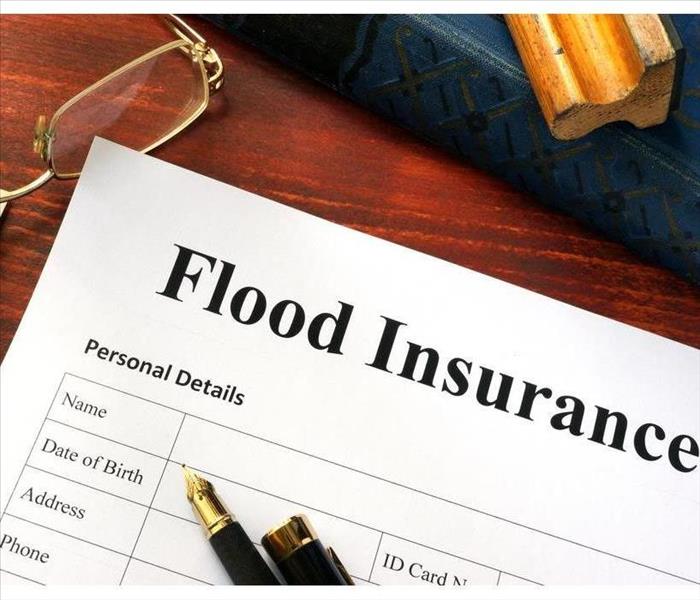 Make sure you add flood coverage to your commercial insurance
Make sure you add flood coverage to your commercial insurance
As a responsible business owner, you know how important it is to protect your business's interests. This is why you purchase insurance. This coverage can give you the financial support you need when misfortune hits and you're stuck with expensive repairs. However, if there is water damage in your building, your commercial insurance may not take effect. In some cases, you need flood coverage.
What Commercial Coverage Takes Care Of
Your commercial plan covers damage to your Overland Park, KS, building and the physical assets of your company. This could occur due to vandalism, weather and malfunctioning parts, systems or equipment. This commercial insurance will protect the building's structure as well as computers, furniture and inventory. The policy will cover damage or loss from the following:
- Storms
- Theft
- Pipe bursts
- Faulty business equipment
What the Insurance Won't Cover
If there is damage to your business property or assets due to an earthquake, the commercial plan will deny your claim. Also, Most flooding won't be part of this coverage, unless the water issues are due to plumbing problems or broken appliances. Floods from weather or sewer backups require a supplemental flood policy. You also won't get help from the insurance company if the damage occurred because you failed to properly maintain or repair components or systems. Purposefully damaging your building or items inside will void your policy
Why You Need Flood Insurance
If your office is located in an area where flooding is common, you should get flood insurance. FEMA has a plan called NFIP that covers floods from sewage problems or overflowing waterways. If you don't purchase a specific flood plan, you will get stuck paying for repairs and for professionals flood remediation teams to make it safe to return to work in your building.
Make sure you add flood coverage to your commercial insurance. This plan will give you the peace of mind you need to run your company.
Residential Water_68_Keeping Your Crawl Space Dry
12/13/2019 (Permalink)
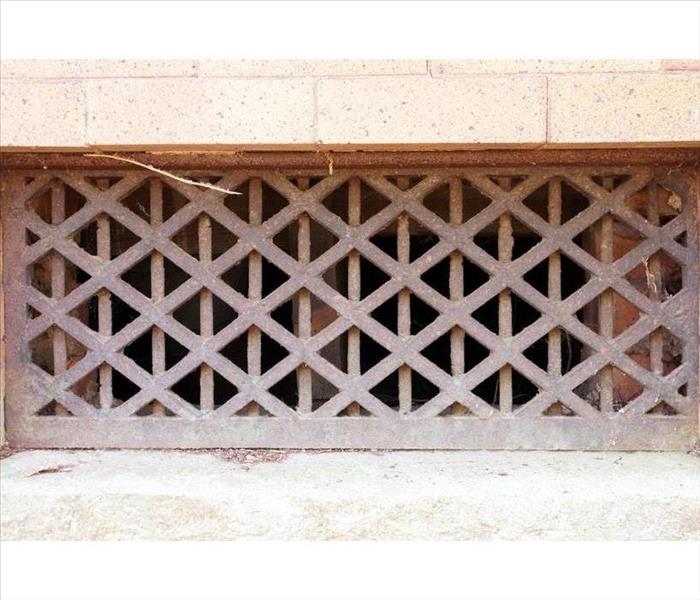 If you find yourself with a wet crawl space, be sure to dry it quickly and take precautions to prevent another flood
If you find yourself with a wet crawl space, be sure to dry it quickly and take precautions to prevent another flood
A wet crawl space in your Prairie Village, KS, home can cause serious problems. In many cases, though, it is possible to prevent a flood in the first place.
How To Keep Your Crawl Space Dry
There are a few simple precautionary measures you can take to protect your crawl space. These include the following:
- Grade lawn away from home
- Clean gutters regularly
- Install a sump pump
- Encapsulate crawl space
Make sure your lawn slopes away from your house so that water can flow away, rather than into, your crawlspace. Maintain your gutters so that they work properly. Additionally, you may wish to put a sump pump in your crawl space. This is a device that will pump any water out of your crawl space before it becomes a problem. Make sure to keep the pump maintained so that it is working well when you need it. Crawl space encapsulation is another way to prevent flooding. Essentially, encapsulation is sealing off the area with a waterproof barrier. Depending on your home's unique requirements, you may need to take one or more of the above precautions to keep your crawlspace clean and dry.
How To Dry a Crawl Space
Even though a wet crawl space might not seem like a threat to the rest of your home, the moisture can result in mold growth and structural damage. It is important to address the problem quickly to prevent further complications. The first step is removing all soaked materials that are in the crawl space so that you can address them separately. Then use pumps to remove the standing water. Afterwards, clean any mold on the surfaces. You can use a bleach mixture or a commercial mold cleaner. Finally, dry out the remaining moisture using a dehumidifier or fans.
If you find yourself with a wet crawl space, be sure to dry it quickly and take precautions to prevent another flood. A professional restoration team can help you get your home back to normal quickly and safely.
Mold Remediation Steps and Process
11/27/2019 (Permalink)
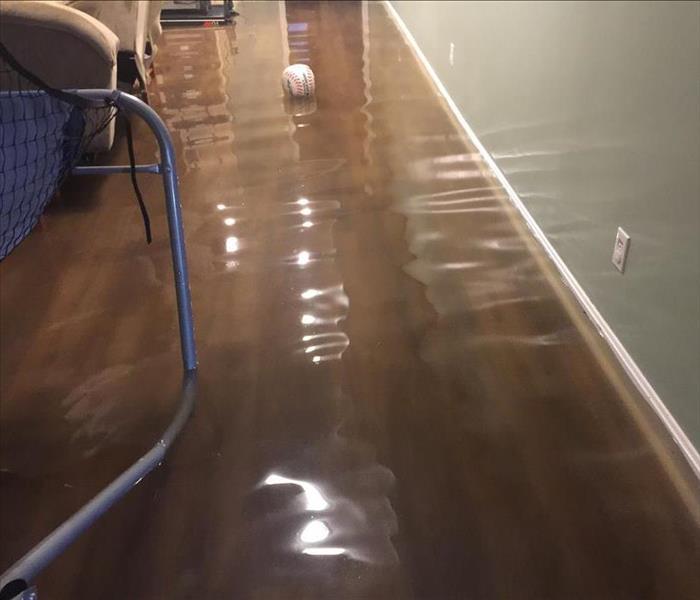 Mold typically has two resources for growth: (1) water damage and (2) high humidity
Mold typically has two resources for growth: (1) water damage and (2) high humidity
Mold Remediation Steps and Process
While your home might have a mild case of mold growth, a more significant infestation might require the assistance of a mold remediation company in Leawood, KS. However, you might find that there are a plethora of companies offering such a service. Although not all of them will be equally qualified, all certified companies should adhere to a similar removal process and steps.
- Resolve Underlying Issues
- Contain the Area
- Remove Contamination
- Sanitize and Clean
- Restore the Home
Resolve Underlying Issues
The first step of any mold removal is to ensure that the underlying cause for the problem is resolved. Mold typically has two resources for growth: (1) water damage and (2) high humidity. Therefore, a remediation company will search the contaminated area for signs of leaks or poor ventilation and attempt to resolve what they can before removing the infestation.
Contain the Area
Next, the company will contain the affected space. They will probably use plastic tarps, taping them over doorways, windows and vents. The goal is to minimize or control airflow so that the rest of the house does not become contaminated.
Remove Contamination
After sealing the area, the team will remove the mold growth from the area. They will need to bag, seal and discard porous items. However, sentimental items might be salvageable if the infestation has not spread too far.
Sanitize and Clean
Once the contamination is removed, the company will spend a considerable amount of time cleaning and sanitizing the space. They will focus on scrubbing down all non-porous surfaces as well as checking appliances for signs of mold.
Restore the Home
Once the team has finished removing the infestation and cleaning the space, they will perform air quality checks. If everything is in order, then they will begin restoring the area to pre-disaster condition.
Significant mold growth likely needs to be addressed by licensed and trained professionals. All companies will probably perform the steps above to ensure that your property is habitable.
Does Insurance Cover the Cost of Fire Damage Restoration Services?
11/22/2019 (Permalink)
 It is always a good idea to speak to your insurance agent ahead of time and find out the specifics of what your policy covers
It is always a good idea to speak to your insurance agent ahead of time and find out the specifics of what your policy covers
Does Insurance Cover the Cost of Fire Damage Restoration Services?
Whether your home in Overland Park, KS, has recently experienced a large blaze that claimed most of your belongings or a small ignition that quickly got put out, the cost of addressing damage caused by a home fire can be overwhelming. Here is some useful information on how much fire damage cleanup services typically cost and what your insurance plan should cover.
How Much Does Fire and Smoke Cleanup Cost?
On average, the overall cost for cleanup services after a home fire is between $3,177 and $7,863. To come up with an estimate, you need to consider the extent of the damage. There are several factors that have a high impact on the final amount:
- Damage to the structure of your home
- Presence of soot on belongings
- Apparent smoke damage
- Water damage from a fire hose or broken pipe
- The need for odor removal services
Will Insurance Cover the Cost?
Most standard homeowners insurance plans provide some level of coverage for remediation after a fire, except for two situations. If it is determined that the cause of the fire was insurance fraud arson, you will not receive coverage and will likely face criminal prosecution. Additionally, you will not be covered if the house has not been lived in for over 30 consecutive days, which is considered a vacant home fire.
What Does Insurance Cover?
While every policy is different, homeowners insurance often covers the cost of repairing your home in addition to other structures located on your property. Additionally, your personal belongings should be covered, but you need to ask if your policy pays the fair market value of items lost or the replacement value.
While remediation services after a home fire can be extremely pricey, you can have peace of mind knowing insurance covers most types of fire damage. It is always a good idea to speak to your insurance agent ahead of time and find out the specifics of what your policy covers.
5 Tips for Preventing Mold
11/18/2019 (Permalink)
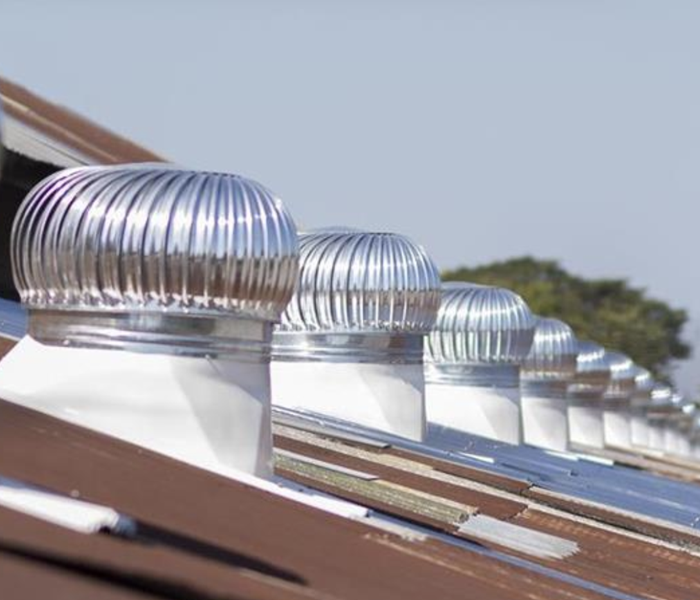 A good ventilation system can prevent mold growth in your building.
A good ventilation system can prevent mold growth in your building.
5 Tips for Preventing Mold
When it comes to mold growth in Prairie Village, KS, even your business may be at risk. Fortunately, there are a few things you can do to help mitigate the problem.
1. Fix Water Damage ASAP
Mold spore growth most often occurs in areas of darkness and humidity. This means that areas affected by water damage are the most susceptible. It's best to repair any such places as quickly as possible.
2. Dry Damp Areas Thoroughly
If you have areas of dampness or flooding in your business, whether due to a storm or a broken pipe, then it's best to dry the area as thoroughly as possible. This can help prevent the creation of a spore growth habitat, as spores tend to dislike dry areas. You may also want to use a dehumidifier.
3. Use Proper Ventilation
One step you can take to help prevent mold growth, is having a ventilation system installed in your building. This can help prevent high humidity in the space, which in turn can help discourage the growth of mold spores.
4. Keep Things Clean
Another way you could help mitigate potential mold problems, is to keep your business clean. Doing so may allow you to spot potential problem areas, and take appropriate measures before a mold problem occurs.
5. Call an Expert
If you believe you may have mold on your business property, it's best to contact a professional remediation service. These professionals have the equipment necessary remove the mold before it spreads further.
If you're hoping to prevent mold growth on your business property there are a few steps you may be able to take. Keep your business dry, fix any water problems you may have as quickly as you can, use a proper ventilation system in the building, and do your best to keep the area clean. If you do believe you may have found mold it's always best contact professional.
Residential Storm_67_Mold Growth After a Flood
11/16/2019 (Permalink)
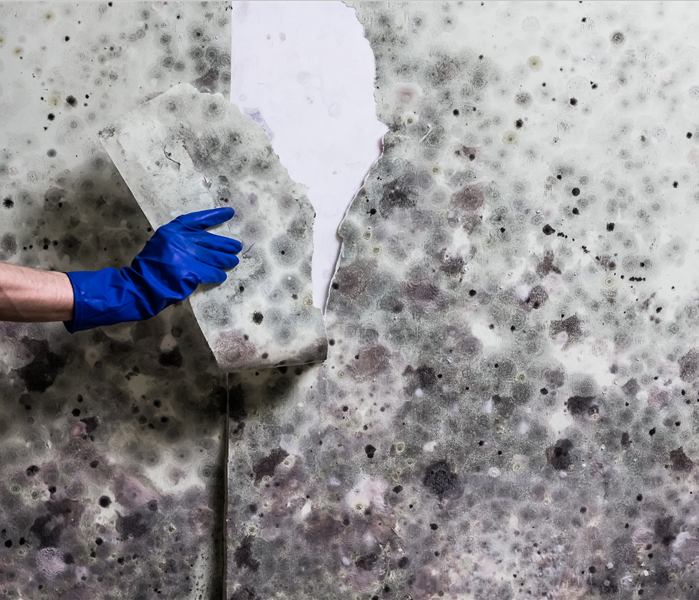 Mold removal in an Overland Park, KS home
Mold removal in an Overland Park, KS home
If your Overland Park, KS, home experiences flooding, mold can begin to grow very quickly. Fortunately, it is possible to prevent mold growth after a flood.
Flood Cleanup Process
Mold growth can begin in as few as 24 hours after flooding, so it is important to clean up the affected areas as quickly as possible. The following steps outline the flood cleanup process:
- Assess and document the damage.
- Remove standing water.
- Dry out soaked items.
- Sanitize affected objects.
- Restore and replace damaged items.
The most important step in preventing mold growth is drying out the property. For standing water, you may need special pumps or vacuums to extract the water. To dry out the remaining water, you can open windows and doors if the humidity outside is fairly low. Otherwise, you can use fans and dehumidifiers. After everything is dry, you will need to disinfect all affected objects. Then you can begin restoring and replacing damaged items.
Mold Removal Process
If you are not able to dry out your belongings quickly, you may end up dealing with a mold infestation. Every situation is different, but the following steps outline the general mold remediation process:
- Contain the mold.
- Filter the air.
- Remove objects that cannot be salvaged.
- Kill the mold on remaining items.
- Repair or replace mold-damaged items.
Because mold spreads so quickly, it is important to keep the mold contained while you work. In many cases, this means simply turning off the heat or air conditioning. Then you will filter the mold spores out of the air using a HEPA filter and remove objects that are too mold-infested to be fully cleaned. The remaining objects should be sanitized with an appropriate cleaner. After everything is free of mold, you can repair and replace mold-damaged items.
Flood damage and mold growth may seem overwhelming. Fortunately, there are restoration specialists that can help you get your home back to normal quickly and safely.
The Benefits of an Emergency Board Up After a Fire
10/30/2019 (Permalink)
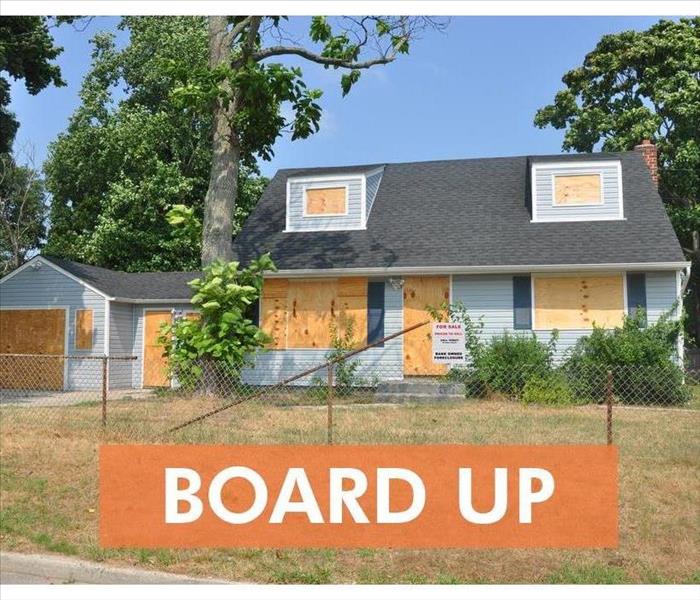 Boarded up home after a fire in Prairie Village, KS
Boarded up home after a fire in Prairie Village, KS
After your house in Prairie Village, KS, has gone through a dangerous fire, it is common to cover some parts in a practice known as an emergency board up. In a board up, professionals place boards over damaged and vulnerable windows, doors and other weaker parts of the house. While you might be tempted to overlook this option, it can provide multiple benefits to the survival of the building.
Protection Against Further Damage
The fragile position of the damaged home can make it vulnerable to multiple hazards and risk factors.
- Strong winds
- Rain and storms
- Intrusion by wildlife
- Trespass by humans
- Other environmental conditions
Boarding up the house prevents the fire damage from escalating, also reducing the work performed by fire cleanup specialists. Some companies even offer these services as part of the restoration process.
Prevention of Insurance Loss
After a devastating home fire, one of the first actions you might take is calling the insurance company. While you might receive coverage for the fire, companies look for any reason to drop coverage if the homeowner does not make effort to stop the damage. In fact, some insurers even require tarp over and board up for the affected residence. Avoid the additional trouble and request this practice to decrease the destruction and keep your insurance coverage.
Avoidance of Human Intrusion
Even though the burned house is exposed to a variety of risks, human trespass is perhaps the most dangerous one. Intruders can exploit the weakened areas as entry points and either rob the area or vandalize and increase the damage. Additionally, if someone gets injured during a stay in the house, you could be held liable, even if they broke into the place. Emergency board up resolves this potential problem.
Even if a home is greatly destroyed, a board up can play a significant role in its restoration. This practice can protect your home from increased damage, ensure your insurance coverage and stops criminals from breaking in.
The Who, What, When, Where and Why of Basement Flooding
10/30/2019 (Permalink)
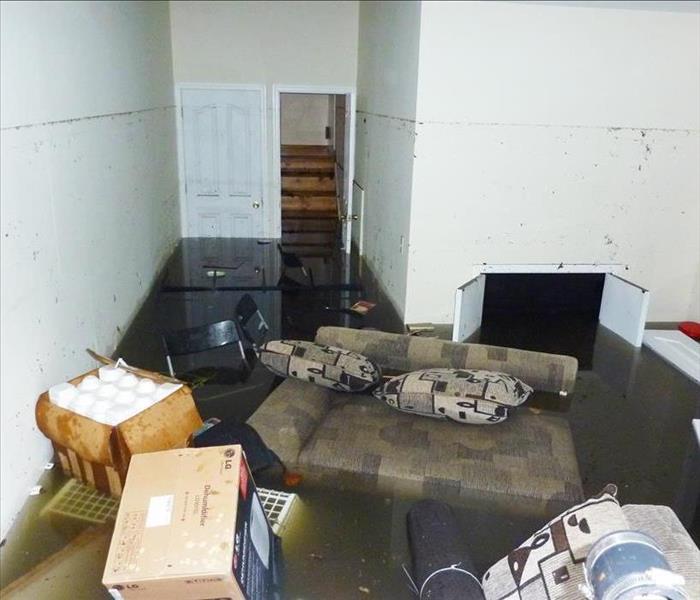 Flooded basement in Overland Park, KS
Flooded basement in Overland Park, KS
The Who, What, When, Where and Why of Basement Flooding
Flooding is a phenomenon that can humble a homeowner in Overland Park, KS. The power of water is always intimidating to face. Take it slow and assess your situation before moving forward.
Why Is It Flooded?
A basement flood can come from a lot of different places. Oftentimes those sources are out of your control. If the flood is weather related, you will need to wait until the storm has passed and your yard is no longer flooded before you can do anything about your basement. Some common examples of sources of flooding are:
- Heavy rain or storm
- Pipe rupture
- Appliance malfunction
- Improper basement sealing
What Can You Do?
The first thing you should take care of is stopping the flow of water, if possible, by turning off the main water line. Then you can minimize the hazard to your safety by turning off the electricity and wearing protective gear like boots and gloves. You can rent submersible pumps from hardware or construction stores to get all the water out of there. Be sure to point the loose end of the pump away from the house, preferably into a storm drain. Then you will need thoroughly dry everything so that you don't end up growing mold, as well.
Who Should You Call?
If you don't have any experience with pumps, it's probably a good idea to call a professional water damage remediation company. They have specialized knowledge and tools to thoroughly remove all signs that there was a flood. They can handle every aspect of the situation, including pipe repair. They will also know exactly what will need to be thrown away, and what can be restored. You should also call your insurance to find out if they will cover the costs.
Each and every flooding scenario is different, depending on the circumstances of its origin and the capabilities of your household. Exercise precaution and don't make any hasty decisions. Your basement is counting on you!
5 Steps for Developing a Business Continuity Plan
10/30/2019 (Permalink)
 Hopefully putting a continuity plan into action never has to happen
Hopefully putting a continuity plan into action never has to happen
The Development of a Plan Should Include Five Elements
While you hope your business in Leawood, KS, won’t be hindered by flooding, storm damage or other natural or accidental disasters, planning for the worst can reduce the potential of disastrous downtime. Successfully navigating the unexpected and recovering from it as quickly as possible is the key role of a continuity plan. The development of a plan should include five vital elements.
1. Risk Assessment
The first step in a continuity plan is evaluating what potential risks your business or property may face. A walk-through of the property and understanding of a building’s location can help you assess what you prioritize what you may face.
2. Impact Analysis
After prioritizing, it’s necessary to look at everything it takes to keep your business running. From security to IT to vendors, reviewing how every step works will help you prioritize and develop strategies to keep them up and running or get them back to running quickly. This includes determining how long your business can run while not operational.
3. Development
Preventing disruptions is the ultimate goal. After the first two steps, you may find potential structural issues that can be repaired before an incident happens. For nature related events, it provides a means to strategize ways to protect resources, employees and tenants while minimizing damage. Part of this plan may involve setting up a response team as well as having a professional service already researched to assist with cleanup.
4. Implementation
This vital step involves sharing the plan with everyone involved. Every employee, tenant and even vendors should know what to do in an emergency.
5. Review
The best plans only work if the people involved have a clear understanding of what to do. A quick memo can easily be forgotten six months down the road when an event happens. Doing a run-through throughout the year will ensure key players know their roles and provide insight on ways to optimize the plan.
Hopefully putting a continuity plan into action never has to happen. Whether small or large, having one is still the best bet in keeping your business afloat during trying times.
3 Things to Remember About Mold Testing and Cleanup
9/25/2019 (Permalink)
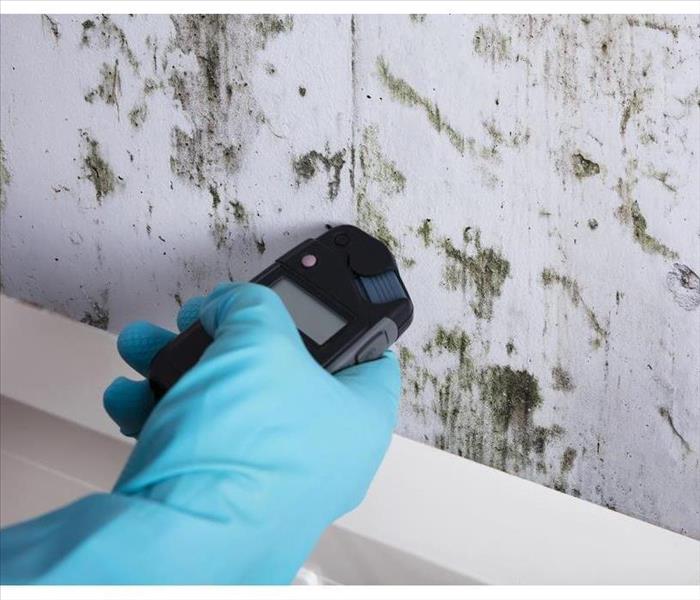 Mold testing in Leawood, KS
Mold testing in Leawood, KS
3 Things to Remember About Mold Testing and Cleanup
Mold is a common problem for many homeowners in Leawood, KS. It can sometimes be difficult to remove once it has begun to spread, so it is important to catch it quickly. One way to do this is through mold testing. If you do not know much about this process, then you may find the following information helpful.
1. When Should You Have Your Home Tested for Mold?
While mold testing can be an important step in locating mold, you may not know when to have it done. If the first sign of mold that you notice is a visible growth, then testing is probably not necessary. However, sometimes mold is more difficult to find. If you notice a musty odor but cannot locate its source, this is a good time to have testing done. You may also need to have it performed if you have experienced water damage since this can often lead to fungus growth.
2. Can You Use a Home Testing Kit?
There are a wide variety of tests you can purchase to do on your own, but a mold kit will not usually yield any valuable results. The problem here is that mold spores are present in most environments, so a home kit can give a positive result even without any significant mold growth. If you suspect that you have a problem, it is a better idea to hire an experienced professional to test for you.
3. What Should You Do If You Find Mold?
If you do discover that there is a mold growth in your house, then you might decide to try to clean it on your own. This is a bad idea, however, since DIY mold removal can sometimes result in accidental spreading of spores. This is another task best left to the professionals.
You might think it is easier to look for and remove mold by yourself, but you will likely not be successful. Instead, hire a mold remediation company to perform mold testing and any necessary cleanup and repairs.
The Common Small Business Claim That Can Devastate Your Property
9/25/2019 (Permalink)
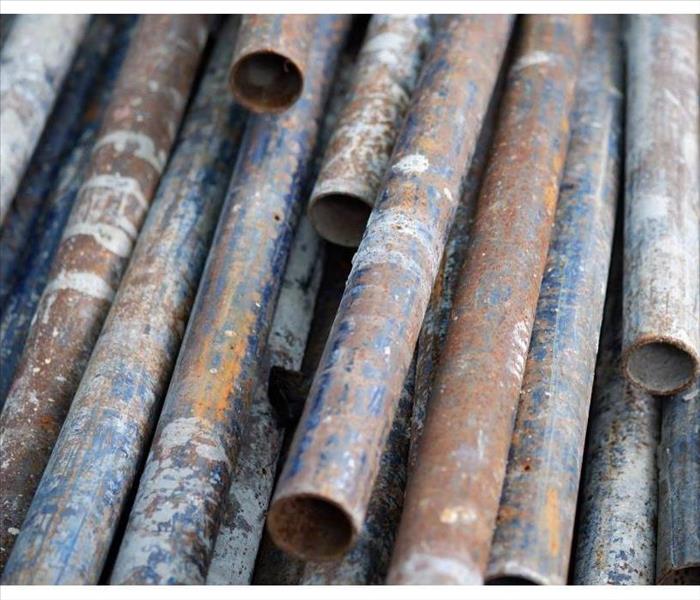 Outdated or worn out pipes can cause pipes to break
Outdated or worn out pipes can cause pipes to break
As a business owner, it's often a priority to keep your business structurally sound in order to prevent the need for a small business claim. However, many business owners in Prairie Village, KS, are unaware of one of the most common causes of insurance claims: broken pipes.
What Causes Broken Pipes?
There are a variety of reasons that a pipe can break or burst. However, some of the most common reasons for a pipe break include:
- Water freezing in the pipes
- Tree roots growing through pipes
- Outdated or worn out pipes
How Are Broken Pipes Fixed?
After the cause of your broken pipe has been identified, one of the first steps in having your pipes fixed is making a small business claim. If a pipe is made of polybutylene, a material that is no longer used in the construction of pipes, then replacement is generally the best option. However, if frozen water or tree roots cause a pipe to burst, then it may be possible to only replace a small portion of the pipes. During this process, it's also often useful to contact water damage restoration specialists who can mitigate any flood damage that occurs as a result of the broken pipe.
Can You Prevent Your Pipes From Breaking?
Preventing an issue with your property's pipes be valuable and can save you a great deal of time and money. Having regular maintenance on your building's pipes is one of the most effective ways to prevent a broken pipe. Regular maintenance will allow a plumber to notice minor signs of a problem before a major issue occurs. Throughout the year, taking the time to check for any signs of water trouble can also be helpful.
Knowing a common cause of a small business claim can be useful to you as a business owner. To avoid making an insurance claim for a broken pipe, it can be wise to understand the causes of broken pipes, how pipes are fixed and what steps you can take to prevent a pipe break.
3 Easy Ways to Save Money on Home Maintenance Costs
9/9/2019 (Permalink)
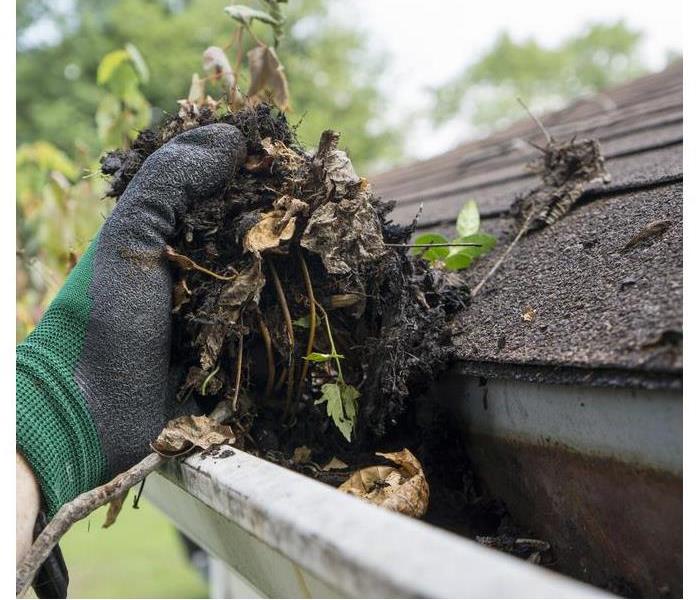 Regular cleaning of your home’s gutters can help prevent devastating damage to your home.
Regular cleaning of your home’s gutters can help prevent devastating damage to your home.
Areas to Focus on To Save You Money Fast
Maintaining your home is often regarded as one of those tedious tasks that is easy to push to the side. However, as many homeowners have learned the hard way, every dollar spent on home maintenance has the potential to save you hundreds of dollars in total maintenance cost down the line. Here’s a couple of areas to focus on to save you money fast:
Look for Leaks
Water leaks are usually simple to fix but can easily lead to disastrous results if left unattended for too long. Mold and mildew can take root and grow in wet spots in your home and can be very expensive to remove. Get ahead of mold by conducting a sweep of your home and checking all plumbing for leaks. Walk through your residence and inspect for active dripping or water stains on ceilings and walls.
It is also important to check your roof after any major weather event to make sure no leaks have sprung. In the emergency event of major roof damage, have the contact information of a roof tarping specialist ready to mitigate further damage. This is a maintenance cost worth investing in.
Assess Your HVAC System
Having a well-maintained HVAC system can save you a lot of money in the long run. Heating and cooling systems that are in tip top shape run at peak efficiency, ensuring that you get the best value out of your energy costs. Routine monthly inspection of air filters should become part of your facility management plan for your home. Performing frequent maintenance on heating and cooling systems will help prolong the lifespan of your HVAC system.
Check the Gutters
Regular cleaning of your home’s gutters can help prevent devastating damage to your home. Gutters can become clogged with leaves, branches and other debris which could lead to wood rot, pest infestations and leaks. These costs can pile up quickly and can be avoided by annual maintenance of your gutters and downspouts.
Regular maintenance may not be the most enjoyable part of being a homeowner in Overland Park, KS, but knowing that putting couple of extra dollars towards maintenance cost can save you thousands in remediation.
First Aid for Commercial Fire Burn Victims
8/27/2019 (Permalink)
 First aid for minor burns
First aid for minor burns
Experiencing a fire in the workplace or other commercial building in Overland Park, KS, can be traumatic, both physically and emotionally. While trying to protect property from fire damage, or simply while trying to leave the building, occupants can easily suffer burns or other injuries. Burns are painful and can be extremely dangerous, so proper and immediate treatment is imperative.
Determining Burn Severity
Once help arrives, medics will look to apply first aid to those with the most severe injuries first. There are four categories ranked by severity that determine the necessary burn first aid course of treatment:
First-degree: superficial burns similar to a sunburn that only affects the topmost layers of skin
Second-degree: deeper burns that cause blisters, have a shiny red appearance, are swollen, and are painful to the touch
Third-degree: less painful because it damages nerve endings, this burn will appear black, brown, white, or yellow
Fourth-degree: potentially life threatening because the burn has penetrated through all layers of skin and damaged bones, muscles, and tendons
Treating Dangerous Burns
Those suffering from the most severe burns could stop breathing. If this happens, find someone who knows CPR to help the victim. Others may go into shock, need protection from extreme cold, or may be wearing restrictive items such as jewelry or belts. Always keep burn victims safe from further harm, remove anything restrictive, and keep their injuries elevated, clean, and cool. Ensure treatments are not too cold, as the burn area will be susceptible to hypothermia.
Additional Treatment Options
Fire damage to the skin should always be treated quickly and properly even in less severe cases due to the risk of infection. For first- and second-degree burns, apply a cool wet compress to the area. If aloe and bandages are available, apply those as well, and always take care to not break any blisters. Quick, thoughtful action immediately following a fire will help give all burn victims the best possible chance to recover from the incident.
Minimizing the Risks of Flooding at Work
8/27/2019 (Permalink)
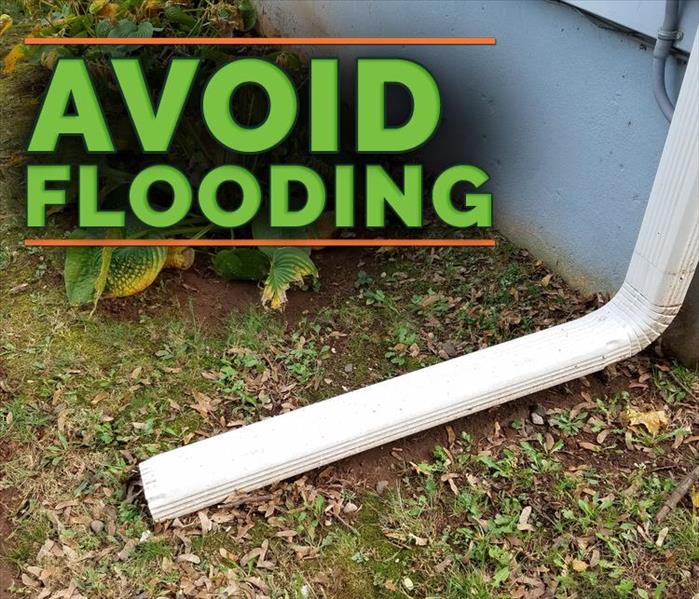 Make sure the property has functional downspouts that divert the water far from the foundation of your building
Make sure the property has functional downspouts that divert the water far from the foundation of your building
Running a business brings many challenging. Managing employees, keeping customers happy and building an economically sustainable building is always on your mind. Environmental damage to your Leawood, KS, building could be devastating. The repair and cleanup costs alone could be detrimental. Loss of work time could put you behind the competition. With a proactive attitude, you can reduce the flood damage in your workplace.
Check Out Waterproof Materials
Thanks to advances in building materials, there are several options you can explore to repel or resist water. These efforts may not completely keep an area dry, but they can be effective in helping you salvage important equipment, tools and structural components. Some items to consider include:
- Putting a layer of waterproof veneer on the walls.
- Add waterproofing to the floors.
- Waterproof furniture
Wise Selection
Lowering your risk for flood damage may start before you even open the doors of your company. Carefully choose a location for your building. By consulting engineers and other experts, you can review areas prone to floods and choose to build elsewhere. Constructing on higher ground should put you in much safer territory.
Raise Them Up
If you have experienced water issues or flooding at work before, avoid additional damage by raising bookshelves, cabinets and equipment off the ground. Often, water comes in through the floor, especially on ground or sub-ground levels.
Proper Drainage
Storm damage can be severe after heavy rainfall, especially if your building is ill-prepared to send water away. Make sure the property has functional rain gutters and downspouts that divert the water far from the foundation of your building. Check these areas regularly, especially immediately following a storm.
Though you can have peace of mind to know that qualified flood remediation specialists can help you recover from even the worst flooding, you want to avoid as much damage as possible. Be responsible and use these strategies in your emergency planning.
Minimizing Water Heater Leaking
8/27/2019 (Permalink)
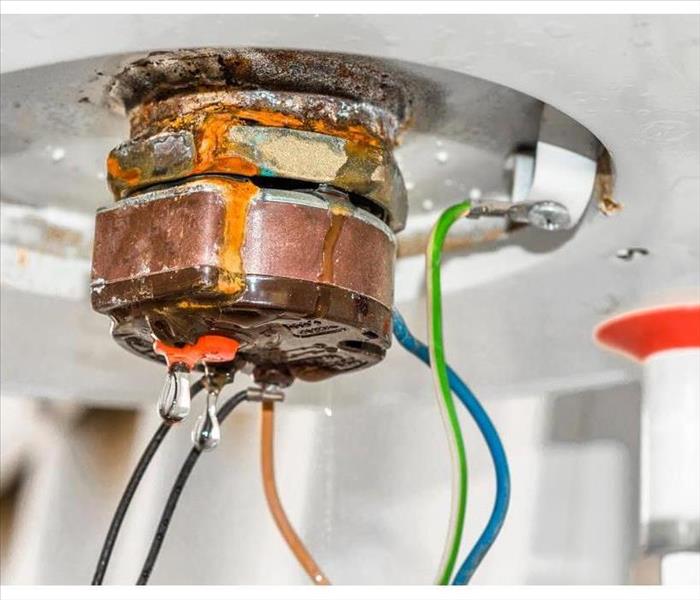 Leaking water heater in Prairie Village, KS
Leaking water heater in Prairie Village, KS
Water damage can come from a myriad of sources, but few are as costly as a leaking water heater. In addition to the cleaning and possible restoration of your home and belongings, the broken water heater in and of itself is quite expensive to fix, replace, and install. Not all water heaters are fixable, but those that are have the potential to be repaired during the professional water mitigation process in Prairie Village, KS.
Causes of Water Heater Leaking
There are a number of factors that can contribute to water damage and mold growth as a result of a leaking water heater. The most common reasons include:
- Loose drain valve: these are often slow leaks and will only create more serious problems when left unchecked for an extended period of time
- Too much pressure in the tank: when the water heater is set at too high a temperature, if water flow into the tank is set at too high a pressure, or if the pressure relief valve is defective, the tank will begin to leak in order to relieve pressure
- Tank is too old: corrosion and rust naturally occur in tanks, so water will inevitably leak over time
Mitigating Water Damage
The only way to truly prevent water damage due to a leaking water heater is to keep close watch over the area on a regular basis. Ensure valves are secure, but not too tight as this will also cause a breakage and leakage. Know the age of your tank, as well as its life expectancy, and plan your finances accordingly in order to replace the tank before a problem occurs. Finally, always follow the tank’s recommended guidelines on water temperature and pressure, as undue force will greatly reduce the life of the tank. A broken water heater can be detrimental to your home and the space in which it occupies, so working with water mitigation professionals is an ideal way to keep your home safe from water and mold damage.
What Happens When Lightning Strikes Your Home
7/19/2019 (Permalink)
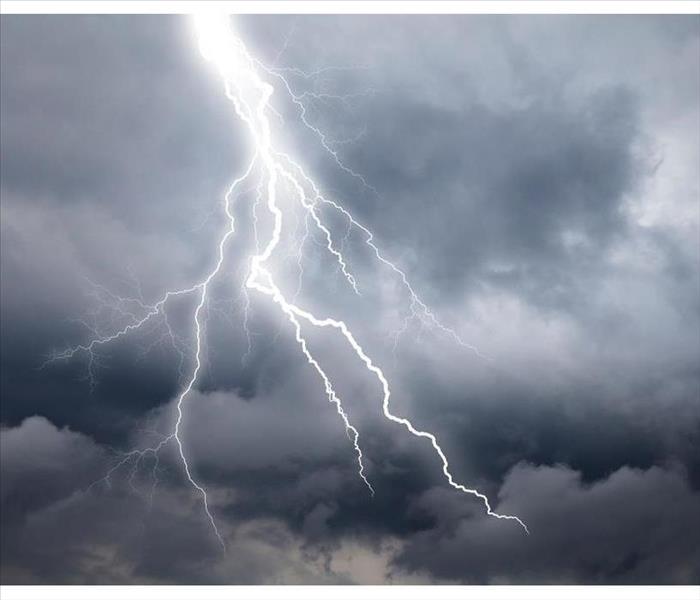 Lightning is a part of nature and beyond your control
Lightning is a part of nature and beyond your control
What Happens When Lightning Strikes Your Home
Between 2007 and 2011, the National Fire Protection Association estimates that U.S. local fire departments responded to an average of 22,600 house fires caused by lightning. During these years, lightning fire caused an estimated $451 million in direct property damage. Only about 18% of these fires occurred in homes but this accounted for 70% of the total property damage. There is always a chance that when a storm comes through your area, damage to your home can result. Effects of a strike could cause both a power surge and fire.
Power Surge
A power surge from a lightning strike occurs when the energy courses through the home’s wiring system. The upwelling of force can also affect the plumbing. The current runs throughout the house causing damage to electronics such as TVs, computers and possibly your alarm and Wi-Fi systems.
Fire
A lightning fire is a definite possibility. The strike will usually pass through the roof and into the attic causing the insulation and the structure to burst into flames. There is also a chance that a power surge going through the wiring in your walls can cause a spark which will turn to fire. If you see fire or smell smoke, leave the house immediately. Call 911 and let the fire department in Overland Park, KS, do a check of the property.
Lightning is a part of nature and beyond your control. However, protecting your home and your family from a lightning fire is doable. As a preventive measure, when a storm rolls through, protect your valuable electronics by unplugging everything which could be affected. Also, you can use lightning rods as a means of shielding the home. The rod is attached to the highest point of the house and conducting wire leads from the rod to the ground directing the hit away from the structure. Although you cannot totally prevent a lightning fire from occurring, be proactive in speaking with a fire restoration specialist.
Steps To Take Following a Commercial Building Fire
7/16/2019 (Permalink)
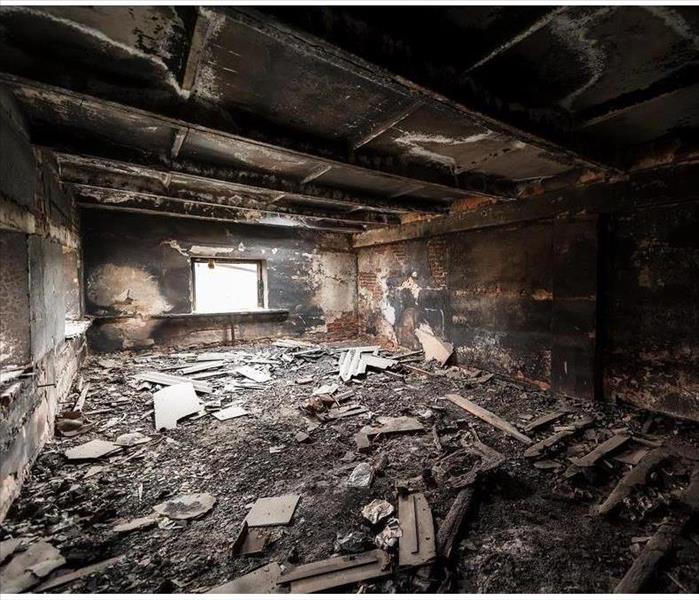 Commercial fire damage can be devastating. Follow these steps for cleanup and restoration.
Commercial fire damage can be devastating. Follow these steps for cleanup and restoration.
A house fire can be an upsetting experience in Overland Park, KS. Beyond losing precious items, the aftermath of a blazing fire can leave you unsettled and frightened. Once the fire is out, you may immediately think about calling commercial fire restoration and cleanup services, but before you do, consider these steps.
8 Steps to Follow After a Commercial Building Fire
- Contact your insurance company and request a meeting. If possible, you may want an adjustor on site during the first walkthrough. If the adjustor cannot visit the site immediately, take pictures.
- Ask fire officials when it is safe to re-enter the building. The fire may be extinguished, but without knowing the amount of destruction to the structure, you may not be aware of where the safety zone is.
- Request a copy of the fire report from the fire department. Not only can it have pertinent information for your insurance claim, but it may also have information to help you identify what data is still missing and possibly necessary for fire restoration specialists.
- To prevent possible looting, or additional vandal destruction, secure the building. Most fire insurance specialists can offer information on how best to protect the structure.
- Contact a commercial fire cleanup and restoration crew to assess the damage. Professional cleaners can help with water, soot, and smoke cleaning, as well as sanitizing the damaged areas.
- If emergency personnel turned the electricity off, empty refrigerators and freezers. After emptying them, leave the doors open for air circulation.
- If water was used to put out the flames, wiring might be damaged. Heat and water may also have damaged appliances. Before turning on lights, appliances, or HVAC systems, check with repair services.
- If the damage is extensive, contact utility companies regarding service. Suspending utilities during restoration is often necessary.
Fire restoration can be a big operation whether it involves minor damage or extensive rebuilding. By following the above steps, you may find the process less stressful or overwhelming. You can also protect your building from additional damage.
How To Make a Flood Damage Claim
7/11/2019 (Permalink)
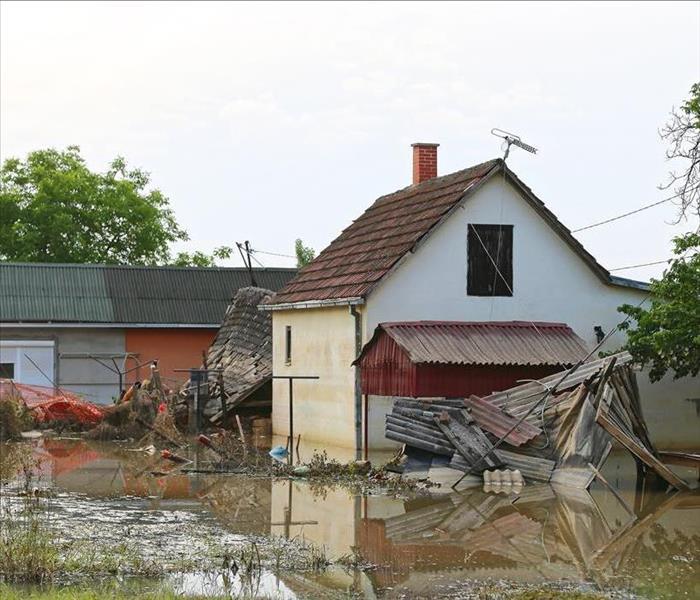 Severe storm damage to a home in Prairie Village, KS
Severe storm damage to a home in Prairie Village, KS
How to File a Flood Claim With Your Insurance Company
A severe storm can cause a lot of damage. Trees can fall, debris can wreak havoc and the ground can become saturated quickly. If your home in Prairie Village, KS, floods as the result of a storm, having flood insurance can help cover the cost of storm restoration services. The following tips can help you file a flood claim with your insurance company so that you don't have to pay remediation expenses out of pocket.
Make Important Calls
The first thing you need to do is to call everyone who may need to be involved in resolving the flooding problem:
- Government office in charge of city sewer system
- Insurance company
- Certified flood cleanup professionals
When a large portion of your area floods, it can affect the city's sewer lines, and officials need to know if you are experiencing any problems. Notifying your insurance carrier prompts an adjuster to visit your home and analyze the damage listed on your insurance claim. Arranging for technicians to arrive as soon as possible helps you prevent further water damage to your home.
Document Damage
To file a successful flood claim, you need proof of all the damage the flooding causes. Don't wait until your adjuster to arrives to document it. Take pictures and video so that you have evidence of the initial state of your home after the flood. After cleanup technicians arrive and pump the excess water out of your home, take more pictures of the water damage and make an itemized list of all the items that must be restored or replaced. Having information ready when the adjuster arrives can help you make a more detailed claim.
If the area where your home is located floods, you may not be able to avoid water damage. Knowing whom to call and the immediate steps to take can help you file a successful flood claim.
Preparation Is Important When Filing an Insurance Claim for Fire Damage
6/28/2019 (Permalink)
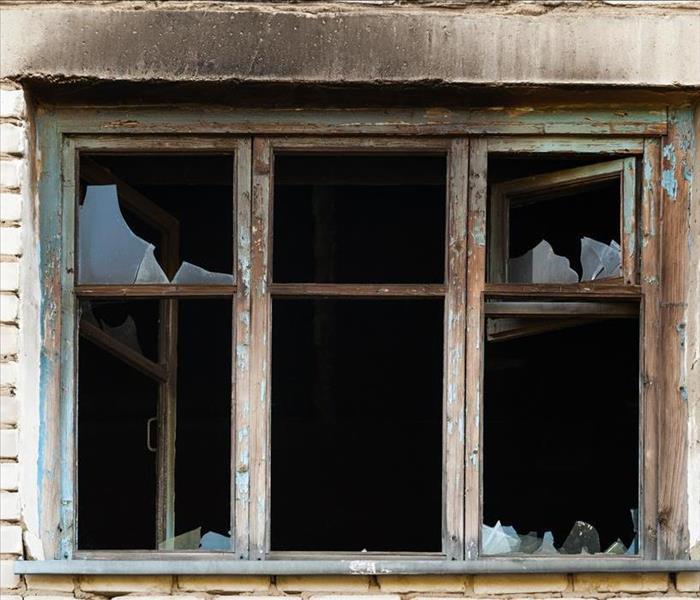 Broken windows after fire damage
Broken windows after fire damage
If the worst happens and your commercial property experiences a fire, you should act to file a fire claim as quickly as possible. To keep the process smooth and ensure that you are receiving full coverage, there are several steps you can take to keep your insurance company happy in Prairie Village, KS.
Secure the Property
Once the fire trucks are gone and the fire has died, you will want to keep the fire damage from getting worse. However, only do what you feel comfortable with, and if a situation feels unsafe you should leave it to the professionals.
If certain areas have been exposed or the windows have blown out, try to board them up as best you can.
If part of the roof is gone, it is a good idea to tarp it up to prevent rain and other elements from entering.
If pipes are burst you should shut off the water.
Gather Your Records
So you aren't left scrambling later, you should gather all documents relevant when assigning value to items that have been damaged or lost. You should keep a record of all expenses incurred from the moment the fire started. It is best practice to photograph all the damage, even before you start securing your property. Making a fire claim is even easier if you also take the initiative to get estimates for all your repairs.
Get Ready for a Visitor
Typically insurance companies will send one or more claims adjusters with specialized knowledge to investigate the claim and assess various forms of damage in order to determine your coverage. They may keep in touch in order to receive updates on the fire restoration process and make payments to your account. Payments are usually sent via direct deposit or check.
When making a fire claim to your insurance, the more information you have at the ready, the easier it will be for everyone involved. This will also make it more likely that you get adequate coverage. Going through a disaster is tough, there's no reason to make it tougher.
How To Identify Water Damage Categories
6/21/2019 (Permalink)
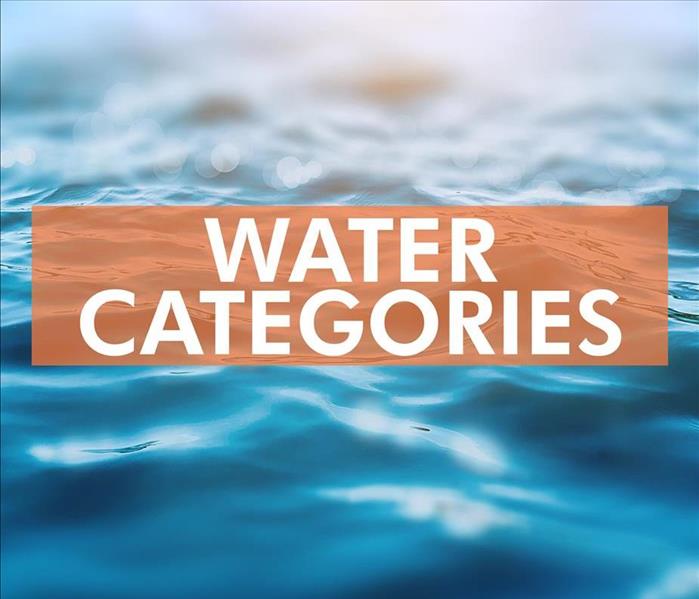 The more you know about the categories of water damage, the better prepared you'll be to handle it
The more you know about the categories of water damage, the better prepared you'll be to handle it
How to Understand the Different Categories of Water Damage
When flood water enters your commercial property, your first thoughts probably don't have much to do with the quality of the water. You're probably thinking about property losses and the work involved in getting everything cleaned up. However, the water could contain a number of bacteria, chemicals, and other harmful substances. Before you enter your damaged property, you must understand the different categories of water damage.
Category 1: Clean Water
Category 2: Gray Water
Category 3: Black Water
Understanding these categories will help you take the appropriate actions while keeping yourself, your staff, and your customers safe.
Category 1: Clean Water
This type of water damage comes from a sanitary water source, such as kitchen sinks. This water looks and smells like it came from the tap. However, once the water floods your property, it becomes contaminated by materials in the environment. It's probably okay to begin cleanup efforts with this type of flooding, but it's best not to start until water damage professionals have a chance to correctly identify the water.
Category 2: Gray Water
The precaution of waiting for accurate identification is important because of the potential risks involved with gray or black water. Gray flood water could result from a toilet overflow and may contain urine, soapy water, and other chemicals. It could have bits of human skin or oil from cooking. Category 2 water is generally unpleasant to clean up and could lead to illnesses.
Category 3: Black Water
Black water or category 3 damage is highly contaminated by bacteria, chemicals, and toxic pathogens. This type of damage might introduce sewage to hard-to-reach corners of the property and may result in the absorption of contaminants by flooring and furnishings. A minor toilet overflow could lead to category 3 damage that quickly spreads throughout the property.
The more you know about the categories of water damage, the better prepared you'll be to handle flood water damage on your Leawood, KS, property. Remember that professionals are best qualified to accurately determine the type of water in your building.
How To React When a Pipe Bursts in Your Home
6/14/2019 (Permalink)
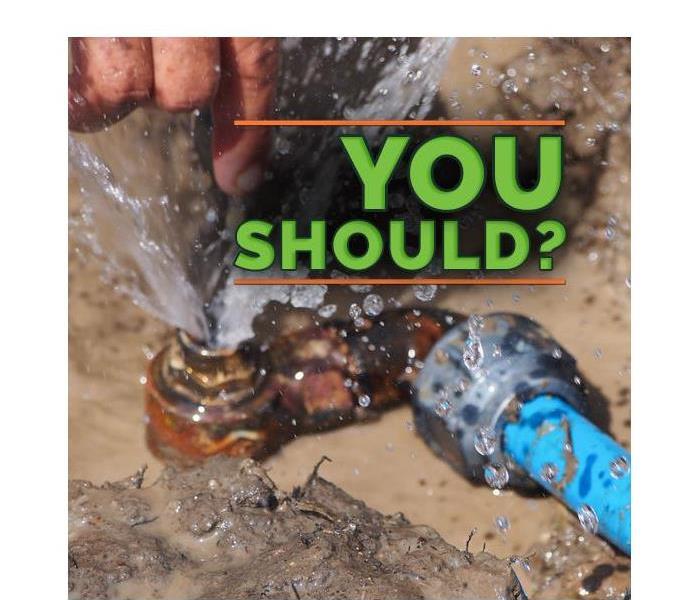 A burst pipe can allow huge amounts of water to come into your house
A burst pipe can allow huge amounts of water to come into your house
What to Do if a Pipe Burts in Your Home
Bursting pipes can occur without warning and can devastate homes in Overland Park, KS. It can be easy to feel overwhelmed when an issue suddenly occurs in your home, but knowing what to do if a pipe bursts can help you react in a timely manner.
1. Stop the Flowing Water
A burst pipe can allow huge amounts of water to come into your house in a very short period of time, and more water in your home will likely mean more damage. Using the shutoff valve, which is often located in basements or garages, will turn off the water to your entire house. Other issues may also require you to turn off the water in your home, so it’s generally helpful to know how to cut off the supply of water before any problems arise.
2. Turn Off the Power
The amount of water bursting pipes can bring into the home can create electrical hazards. In order to keep yourself safe and to minimize the risk of an electrical fire, it’s generally wise to turn off the power to your residence. Additionally, it’s often best not to touch any items that use electricity or any electrical outlets even after you have turned off your home’s power.
3. Ask for Help
After the water is no longer flowing into your home and your home no longer has power, it’s often best to contact a plumber and water damage restoration expert. A plumber can fix the broken pipe and can assess your other tubes to make sure they aren’t also at risk of bursting. Restoration specialists can assist you in removing water from your home and can restore personal belongings that were damaged by the water.
It’s often helpful for homeowners to know what to do if a problem such as bursting pipes occurs. Stopping the flow of water, turning off your home’s power and contacting professionals in restoration can help to decrease the cost, time and stress spent dealing with a burst pipe.
An Overview of Mold in Homes
5/30/2019 (Permalink)
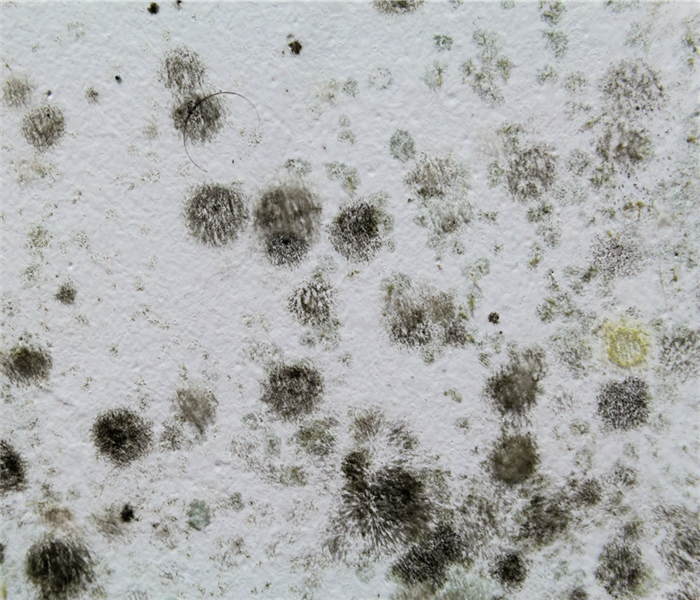 Black mold in a Prairie Village, KS home
Black mold in a Prairie Village, KS home
How to Handle Mold Growth in Your Home
Unfortunately, black mold is a common issue in many homes in Prairie Village, KS. However, learning about residential mold growth can help you feel equipped to handle mold growth in your own home.
1. Why Does Mold Grow in Homes?
There are a variety of reasons mold can appear in a home. Commonly, mold begins to grow in areas that have been affected by water damage. Though many people consider floods or pipe breaks to be water damage that can result in the appearance of mold, small leaks can also cause mold growth. Additionally, if you have a moisture problem in your home, such as a humid attic or bathroom, this can increase the likelihood of mold growth.
2. How Do You Know Mold Is a Major Issue in Your Home?
There are often telltale signs of black mold, such as the dark discoloration and an unpleasant odor. However, some types of mold can be less noticeable until they have spread throughout your home. Mold that is visible in one place may indicate that it is present in less noticeable places in your house, which is why it can be wise to request an inspection by mold remediation specialists if you see mold anywhere in your home.
3. What Happens if Mold Is Ignored?
In the right environment, mold spores can quickly spread, and damage can begin within hours after water damage has occurred. Over time, mold can cause building materials to wear down, which can ultimately weaken the structure of your home. Though mold cleanup and restoration can be quick if mold is caught early, if the damage is not quickly treated, it is often necessary to replace building materials.
As a homeowner, you often want to feel prepared to handle any problem that arises. Understanding why mold grows in homes, signs of growth and knowing why it’s important not to ignore mold can make it easier to know how to react if black mold does appear in your home.
Tips for Flood Prevention in Your Community
5/22/2019 (Permalink)
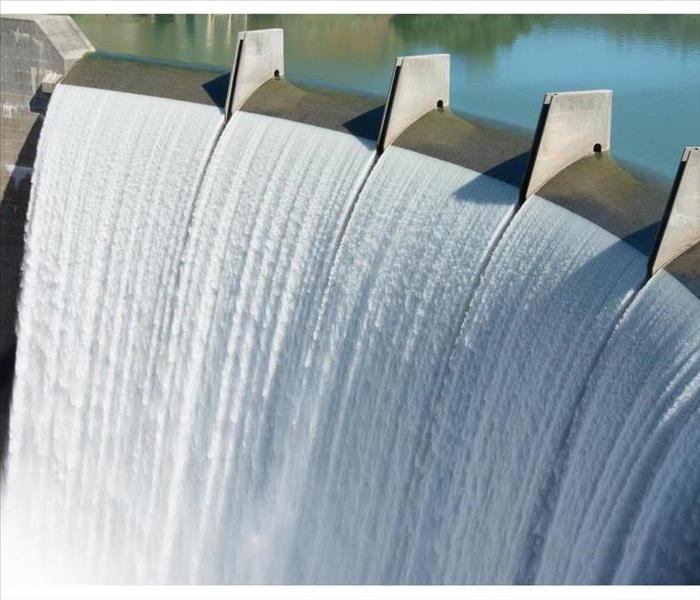 Dams are used to hold excess water
Dams are used to hold excess water
So far, it's impossible to prevent rain from falling and high waves to overflow their banks. The control of natural events is still out of the hands of humans. However, there are some flood prevention tactics that can keep properties safe from damage. You may recognize some of these methods in action in Overland Park, KS. Town planners are often responsible for actions, such as
• Keeping waterways clear
• Installing and maintaining drainage systems
• Clearing litter and debris out of water ways and drainage systems
Coastal Defense Walls
Communities situated near large bodies of water may have sea walls, tide gates, and sand bag barriers in place. These structures are intended to prevent tide and its waves from bringing too much was on shore.
Water Retention
In many communities, retaining walls such as levees, lakes, dams, retention ponds, and reservoirs are used to hold excess water. These are especially helpful under flooding conditions. Today, many of these solutions are structured to function as attractive landscaping, as well as providing flood prevention.
Detention Basins
This solution involves a small reservoir that is connected to a waterway. The reservoir serves as temporary water storage until the water is able to flow back into the waterway. It also holds water and gives the community a longer amount of time to evacuate when necessary.
Vegetation to Prevent Erosion
Bare soil is much more likely to wash away than land help in place by trees, shrubs, and grasses. You may see vegetation throughout your neighborhood that will break up the flow of moving water, reducing erosion, and limiting the flow of flood waters.
Education
If you're not sure what you can do to reduce the necessary flood cleanup and damages around your commercial property, contact water and flood remediation professionals in your area for more advice. These professionals can offer advice about the impact of litter and the ways that high water is most likely to affect your property.
What steps can you take to improve flood prevention? Make your voice heard as a business owner. Engage in civic planning and take time to learn more about flooding.
Reduce the Risk of Cigarette Fire in Your Home
5/22/2019 (Permalink)
 Never leave a lit cigarette unattended
Never leave a lit cigarette unattended
There are many reasons a house in Leawood, KS can catch fire and it can be a devastating experience. Lightening strikes, electrical malfunctions or sparks from a nearby chimney are unexpected and traumatic. However there are also many types of fires can be prevented. A cigarette fire is one of those. If you or someone in your home enjoy smoking, it is vital to take the necessary precautions to prevent the outbreak of a blaze.
Tips for Safer Smoking
- Make sure to keep sturdy ashtrays in several places in the home, always on a solid surface, never the arm of a chair or the bed. Better yet, smoke outdoors.
- Never leave a lit cigarette, cigar or pipe unattended. It only takes seconds for a fire to break out. This is especially important if there are pets or children in the home.
- Make sure any used matches or butts are completely extinguished before throwing away. Take them out to a sand-filled pot outdoors, not in the trashcan.
- Do not smoke when sleepy or in bed; a cigarette fire can easily happen when you fall asleep
- Never light a cigarette or smoke in the presence of oxygen, as it is highly combustible
Cigarette and ashtray fire is the leading cause of home fire deaths each year. The majority of these fires begin in a chair, a bed or a trashcan, which can ignite quickly, and often when the smoker has fallen asleep or become distracted. Again, smoking outdoors is preferable, both for fire prevention and for more breathable air inside the home.
As the home of a smoker can be at a higher risk of fire, prepare your family in advance to be safer. Discuss evacuation plans and practice escape routes. Decide on a local fire restoration service in Leawood, KS to help with fire cleanup and have their number at hand. Taking the necessary precautions against cigarette fire can help you feel more at ease.
Kansas City Area Residents: We Specialize in Flooded Basement Cleanup and Restoration!
4/30/2019 (Permalink)
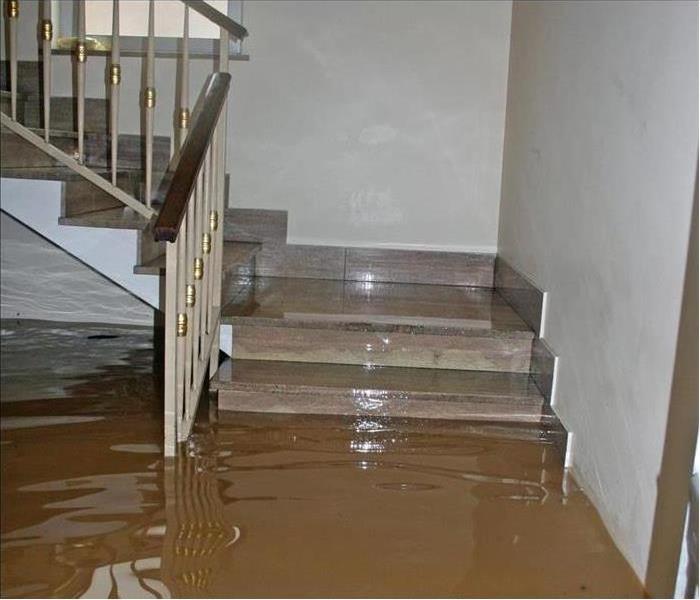 Basement Flooded in Kansas City after a Storm.
Basement Flooded in Kansas City after a Storm.
A basement can flood at any time, although flooding most often occurs during heavy rainfall. Basements are inherently prone to flooding because they are the lowest level of a building and are normally built partly or entirely below ground level.
There are a number of reasons why your basement could flood, including:
- A blocked or failed sewer lateral pipe
- Heavy rain causes surface water to pool around your home
- Storm sewer backup
- Sanitary sewer backup
- Foundation drainage failure
- Water supply-line break or hot-water tank failure
- And many more
Last year there were many flooded basement due to heavy rains and overflowing creeks and rivers.
We use advanced inspection and monitoring equipment such as infrared cameras and moisture meters to determine if your home’s structure is actually dry. Touch is not a reliable method, as moisture can trap inside.
If Water Damage is not handled quickly and properly, it can cause severe damage to your home’s structure, not to mention the potential harmful health effects of mold. Remember, the longer you wait, the worse the problem will get.
We are Flooded Basement Specialists:
- We are available 24 hours/7 days per week for emergencies.
- We’re a Preferred Vendor to many national insurance companies
- We bill your insurance directly – one less thing for you to worry about
- Our Technicians are highly-trained in Water Restoration Techniques
- We use s500 IICRC Restoration Standards
- Advanced inspection and extraction equipment
Basement Flooded? Call Us Today – We’re Here To Help - (913) 381-6550
3 Steps To Minimize Mold Damage After a Flood
4/30/2019 (Permalink)
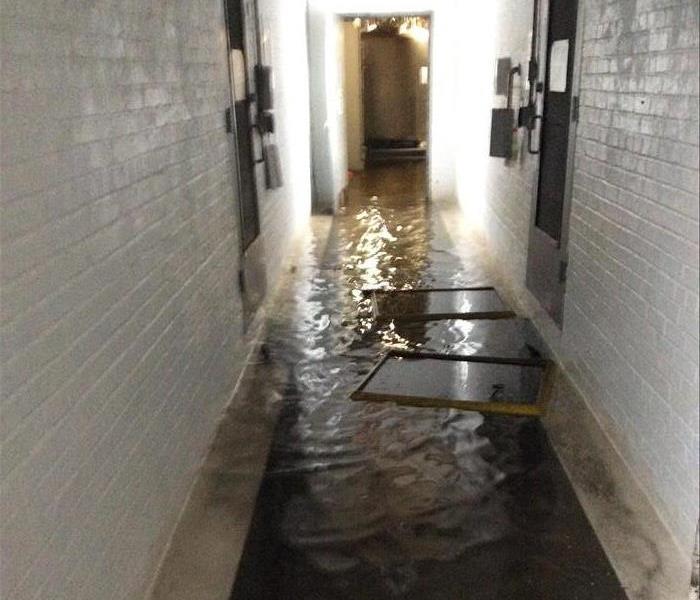 Flood Damage in a local Overland Park, KS, facility.
Flood Damage in a local Overland Park, KS, facility.
Severe weather happens, and as a result, homes often flood. The inevitable moisture and water from flooding can lead to mold growth. Mold usually will flourish if moisture is allowed to linger in the floors, walls, wood, carpet or basement of your home. It can be imperative to know what to do in the critical hours and days directly following a flood.
3 Steps To Minimize Mold Damage After a Flood
1. Move Quickly
Generally, mold begins to grow within one to two days after a flood in Overland Park, KS. The cleanup and damage mitigation process should start immediately to prevent further damage to your property. Although mold can occur naturally just about everywhere, spore may thrive on moisture and grow large colonies rapidly after a flood. At this time, it may be a good idea to place a call to your insurance company to begin the claims process.
2. Remove the Water Source
After any flood, the first step in inhibiting mold growth is often to address the source of the water. This means taking emergency measures to protect your home from any more water intrusion if possible. With some natural disasters, you should wait for waters to recede, but if the source of water is immediately fixable, such as a roof leak, repairs should be made to stop the intrusion.
3. Begin Drying
All standing water should be removed. This water can be particularly dangerous as it feeds mold and can contain high counts of dangerous bacteria that continue to multiply as the water stagnates. A flood damage expert can begin by extracting the water from your home. If there are large amounts, the water may have to be pumped out slowly in order to maintain structural integrity.
Remove flood-damaged personal property such as furniture and clothing. Some items, such as soaked mattresses, are usually not salvageable and should be disposed of. All items to be saved should be thoroughly dried and sanitized prior to returning to the home.
Remember that mold removal is a myth because it’s everywhere in different forms. The goal is to return mold growth to normal acceptable levels. This can be accomplished through the cleanup, remediation and restoration process.
Preparing Your Business for an Impending Flood
4/30/2019 (Permalink)
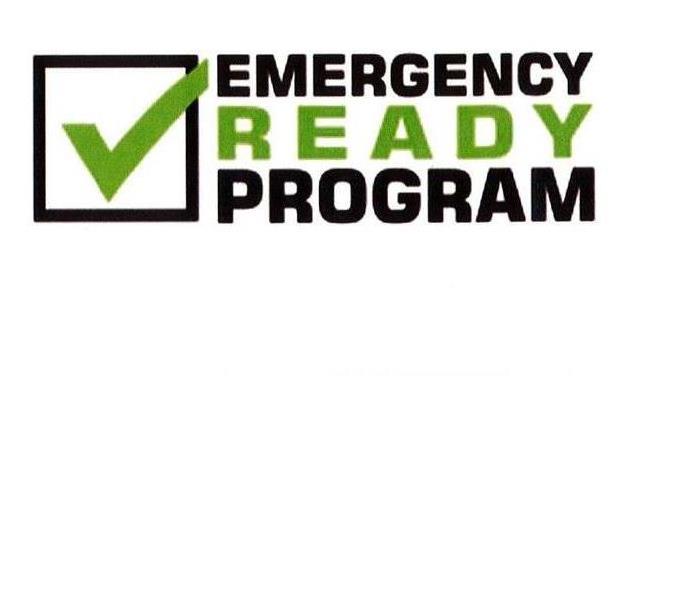 Preparation is so important for a business because it can avoid extended business interruption after the storm passes.
Preparation is so important for a business because it can avoid extended business interruption after the storm passes.
When the flooding starts, it is usually too late to protect from flood damage. The best time to prepare for a flood is before it occurs, giving you time to purchase supplies and secure your facility from disaster. The reason preparation is so important for businesses is that poor planning can lead to extended business interruption after the storm passes. Therefore, to give your business the best chance at a speedy recovery, there are a few things you should do in preparation of floodwaters.
How to prepare your Business for Flood Damage
1. Protecting Doors and Windows
Storm damage can do significant harm to your building due to high winds alone, but a flood increases the risk of damage exponentially, especially for doors and windows. The best way to protect these vulnerable points of entry is to barricade them with sandbags. The bags should be stacked a little higher than storm predictions to ensure protection.
2. Securing Furniture
Flooding can turn furniture, interior and exterior, into projectiles. You may want to weigh or chain down any outdoor furniture, and interior office furniture may be best moved to a higher level than ground level.
3. Moving Fragile Equipment
Computers and other fragile electronics and equipment should also be moved to a higher floor to ensure functionality after the flood. While water levels may not reach desk height, it is possible for them to reach outlets, sending a surge through your equipment and potentially ruining it.
While you can try every preventative measure out there, it is still possible that a flood will damage some part of your business, which is why you should consider your options for mitigating loss after a flood. A disaster restoration specialist in the Overland Park, KS, area can help you prepare an emergency action plan that goes into effect when a disaster occurs, speeding up the restoration process.
Flooding can cause significant damage to a business, and it may even result in extensive business interruption. To help counteract the potential damage and risk, a business can take the above steps, ensuring some level of protection during a disaster.
Temporarily Fix Your Wind-Damaged Roof
4/30/2019 (Permalink)
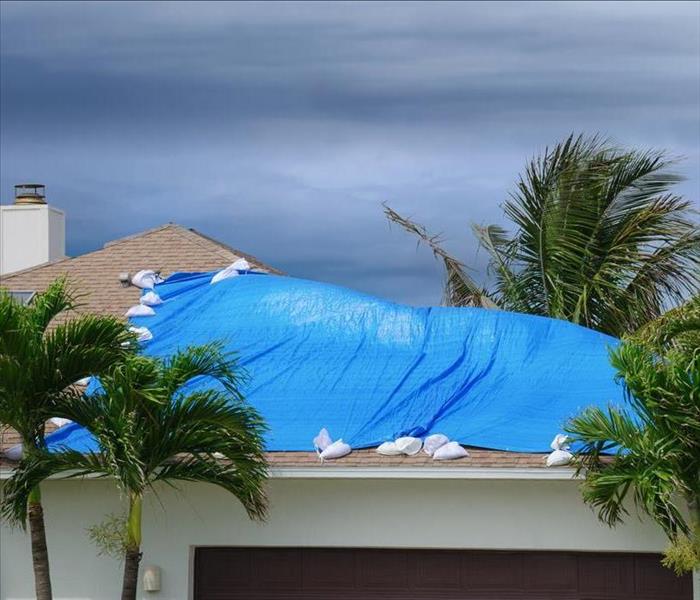 Covering Wind-Damaged Roof in a local home.
Covering Wind-Damaged Roof in a local home.
High winds can cause considerable harm to your business’s building. What should you do after discovering a roof leak as a result of wind damaged roof? It can take days to weeks to get a roofer out to complete repairs. A compromised structure may lead to additional water damage repairs needed.
3 Steps to take to temporarily keep ongoing inclement weather from causing any more unnecessary destruction.
1. Inspect the Damage
The first action is to inspect the damage. You will need to get onto the roof safely by using a sturdy ladder. Locate the source of the roof leak. The cause may be obvious, like a visible hole, or you may have to examine things more closely. Look for areas where water may be flowing over sections of missing or damaged shingles.
2. Patch Holes
Plywood can be easily cut to cover any holes. Cut pieces large enough that your patch will extend several inches beyond the hole on every side. Then you can use roofing nails or deck screws to attach the plywood to the existing structure.
3. Cover the Surface
Large, durable tarps can be used over the patched holes and areas where missing shingles are discovered. Use the thickest tarps available. For this type of temporary fix to be effective, be certain that the tarping material goes over the roof’s peak.
Tarps should be pulled tightly and secured around the entire perimeter to ensure they don’t blow away or allow rainwater to be seep underneath. Rope or cord can be used to hold the material down, or you may choose to nail the tarps to the building’s fascia board.
Temporary roof repairs can last from days to weeks, buying you the necessary time before a permanent, professional repair can be completed on your roof leak. Safely following the steps outlined can help mitigate any additional storm damage to your business in Overland Park, KS.
Extra Steps: How To Clean Up After a Storm
4/26/2019 (Permalink)
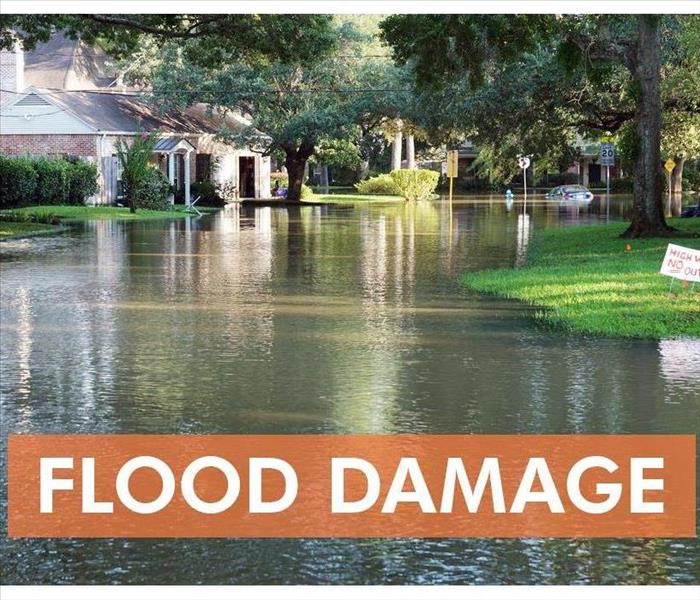 Flood damage in the Prairie Village, KS area
Flood damage in the Prairie Village, KS area
How To Clean Up After a Storm
If a pipe bursts in your home in Prairie Village, KS, you will likely have some flooding to handle. A flood from a storm, however, takes remediation to another level. Not only do you need to dry out your home, but you also will need to disinfect your home, both in areas that are directly affected and those that may be vulnerable to secondary damage.
Extracting Water
The first step to remediating any water damage is to remove the excess water from the area. With a flood with Category 1 water, the process is pretty straightforward:
- Remove standing water
- Dry remaining surfaces
- Repair or replace damaged materials
Floodwater from a storm, however, is considered Category 3 water. It is contaminated and may contain all sorts of bacteria, viruses and other microbes. If you have flooding from a storm, flood mitigation experts must clean your home thoroughly after getting rid of the water.
Disinfecting Area
Anything that comes into contact with the floodwater must be disinfected before your home is considered habitable again. Technicians use specific detergents and industrial strength cleaners to make sure all surfaces are sterilized. Then they test to ensure that the cleaners did the job well.
Cleaning Home
Even if part of your home doesn’t have flood damage, it may still be impacted and need attention. For example, it is a good idea to have technicians clean your HVAC unit. That much floodwater can significantly increase the humidity in your home, making all of it susceptible to mold growth. Cleaning and drying the ducts can discourage fungus from growing in hidden areas.
While there’s no such thing as a good kind of flooding, damage from clean water can be easier to clean up than issues resulting from storm water. Getting rid of the water is not enough; you must also make sure that your home is properly disinfected before technicians are finished with the job.
3 Benefits of Hiring Certified Water Damage Experts
4/17/2019 (Permalink)
 Call SERVPRO, certified professionals who have knowledge and experience in water damage.
Call SERVPRO, certified professionals who have knowledge and experience in water damage.
Three Main Reasons Of Hiring Certified Water Damage Experts
The Institute of Inspection Cleaning and Restoration Certification sets the standard for the cleaning and restoration industry. When your commercial property in Leawood, KS, needs professional water cleanup, you want to make sure that you are hiring experienced, knowledgeable technicians, and certification by the IICRC helps to ensure that certain expectations will be met. There are many benefits to hiring certified water damage experts, but here are three of the main reasons it is in your business’s best interest to do so.
1. Quality Training
When a remediation company is certified by the IICRC, you know its technicians are well-trained to perform extensive damage repair and restoration. These experts know the difference between what to do with a flood caused by a broken pipe and how to handle a collapsed ceiling from a massive toilet overflow on the second floor. Each separate certification is for a different area of expertise so that technicians can hone their skills.
2. Field Experience
Certified water cleanup professionals are not novice workers. Because a certain amount of hands-on experience is required for certification, you can rest assured that you are hiring someone who has worked on similar problems before and has learned from that experience. You never know if new companies with uncertified technicians know what they are doing, but you can be confident in the work of those with the backing of the IICRC.
3. Continuous Learning
Certification offers the opportunity for continuing education. New technologies offer better techniques for commercial drying specialists so that they can keep mold growth from forming in your building. By staying engaged in the learning process, certified technicians can stay up-to-date on the latest innovations in their industry so that they can better serve their customers and keep secondary damage at bay or at least at a minimum.
When it comes to water cleanup in your commercial building, you don’t want to settle for the first name you find in the local directory. Look for certified professionals who have knowledge, experience and willingness to learn.
Preventing Mold in Your Rental Home: 3 Effective Strategies
4/11/2019 (Permalink)
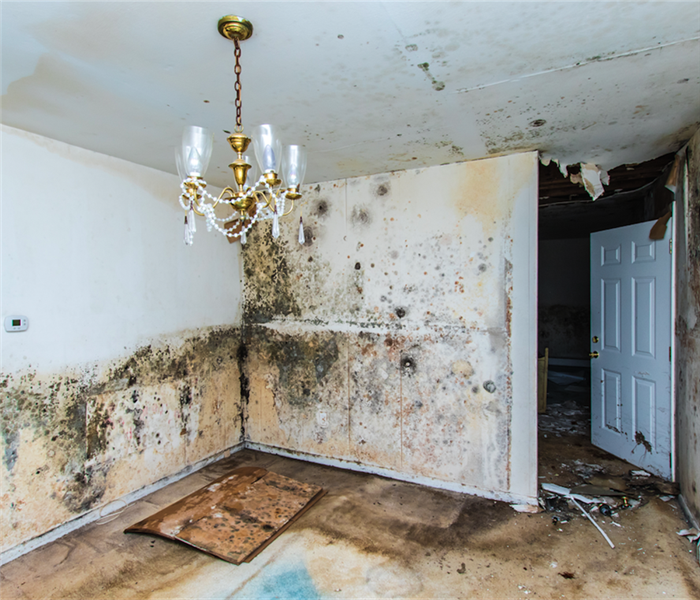 Mold can grow quickly, SERVPRO can help you with highly trained mold remediation technicians.
Mold can grow quickly, SERVPRO can help you with highly trained mold remediation technicians.
Strategies To Prevent Costly Mold Damages In Your Rental Home
When it comes to earning some extra cash to supplement your monthly budget, owning a rental home in Overland Park, KS, can be a profitable venture. However, taking on the responsibilities of a landlord can be challenging, especially when it comes to the upkeep of the property and prevention of mold. Knowing a few strategies for stopping fungi from invading your rental can be well worth the time and effort, as its cleanup and removal may delay your ability to open the property to tenants once it is allowed to form and grow.
1. Turn Off Water Lines When Home Is Vacant
Mold growth is mostly likely to occur when there is moisture present, but turning off water lines and pipes when your rental home is vacant can prevent it. You may want to have the plumbing inspected before you shut the lines off to ensure they are in good working order for the next tenant. If you discover any leaks, have them repaired before you rent the home again so the problem does not grow worse while the home sits empty.
2. Monitor the Space During Humid Weather
Humidity and moisture often make prime conditions for fungi growth, so monitoring the indoor environment of your rental can be an important step in mold prevention. Installing ceiling fans in each room can keep air circulating and reduce humid conditions. If you are keeping the unrented home heated during cooler weather, lower the thermostat to avoid raising the humidity, especially in the bathroom where mold is most likely to grow.
3. Have Water Issues Repaired Professionally
If your rental home experiences flooding, it is wise to call in a flood repair and mold remediation service to clean up the water damage. Even a minor flood can cause moisture issues behind walls, where mold might grow unchecked. Having repairs made by experienced technicians can prevent this issue.
Ownership of a rental home in Overland Park, KS, comes with many responsibilities. Knowing how to practice mold prevention can prevent costly damage and allow you to rent your property with confidence.
The Value of Pretesting During Property Restoration
3/24/2019 (Permalink)
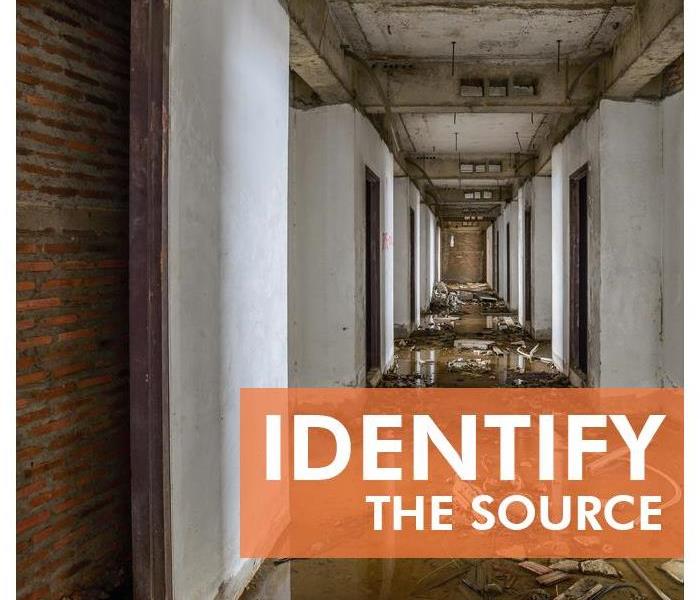 When property restoration technicians first arrive on the scene, they look for an ongoing source of damage
When property restoration technicians first arrive on the scene, they look for an ongoing source of damage
Some property damage restoration professionals begin their services with pretesting. That is, they complete a detailed inspection of affected properties, assessing the types and scope of damages. With this information, the technician can plan an appropriate course of action. One of the key reasons for completing this inspection before beginning any other work is to keep the cost of an insurance claim down. The process generally includes the following steps:
- Address immediate and ongoing destruction or safety concerns
- Identify and categorize damages, including further safety concerns
- Survey the extent and measure the scope of the damage
- Take steps to prevent further harm
Immediate Concerns
When property restoration technicians first arrive on the scene, they look for an ongoing source of damage. For example, if the property was affected by water, technicians identify the source and prevent more water from getting into the area. If they arrive at a fire-affected property, the technicians may cover holes in the roof.
Identification of Damage
Once immediate threats of harm are resolved, property damage restoration professionals move on to determine the types of damage. After a fire, for instance, technicians may find smoke in the air, soot stains on furniture, water-logged furnishings from sprinkler systems and hoses, and so on. Technicians list and categorize these issues to guide their restoration efforts.
Measure the Extent of Destruction
In addition to determining the types of damages during the pretesting phase, technicians must determine the scope of destruction. This step helps professionals prioritize areas of restoration. For example, a wet spot on the floor is much less serious than water-logged construction that could lead to a hole in the floor.
Prevent Further Issues
Finally, before leaving, technicians will address any issues that may cause further harm to the property. This includes putting up plywood on entrances, shutting off electricity, or moving furniture to prevent stains.
An insurance agent in Prairie Village, KS, may seek pretesting to keep costs under control. Property owners appreciate the information that gives them an idea of how much time and money to prepare.
How To Take Care of Wet Items After Water Damage
3/14/2019 (Permalink)
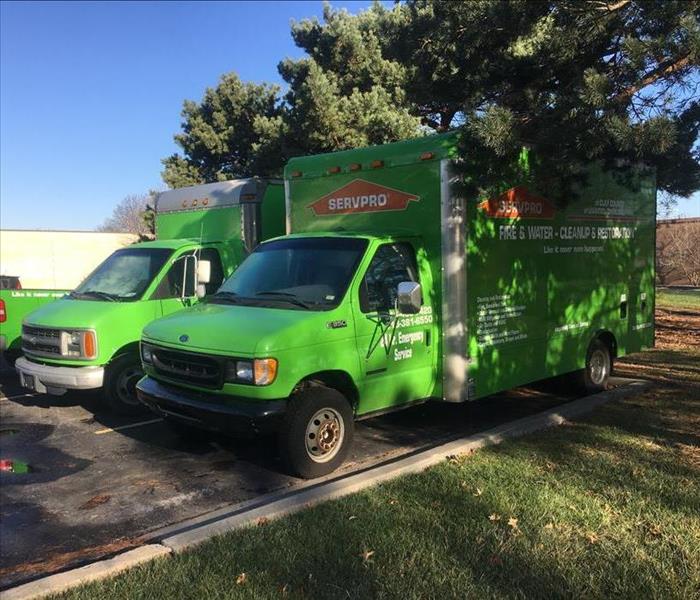 Contact restoration professionals in Leawood, KS area
Contact restoration professionals in Leawood, KS area
How to Take Care For Your Belongings After Water Damage
Water in your home can affect both the structure of your house and your personal belongings. After your home in Leawood, KS, has been affected by water damage, it can be helpful to know how to care for your belongings that are also damaged.
1. Keep Items Dry
Whether the water damage was caused by a broken pipe or a natural disaster, it’s important to keep the belongings in your home as dry as possible. Removing water and making sure more water cannot get into your home is often useful, and making sure your home is well-ventilated can help your belongings dry quickly. Keeping your items dry can also keep mold from growing, which can further damage belongings and can make cleaning and restoring the items more difficult.
2. Contact Restoration Professionals When Necessary
Although there are some belongings that you can likely clean yourself after you’ve experienced water in your home, delicate items such as photographs, documents or paintings can be difficult to clean and restore. If you have fragile items that have been damaged, it can be wise to employ water damage restoration professionals. Professionals will ensure your items are handled with care and can use specialized treatments that you may not have access to at home.
3. Clean With Caution
It’s often important to look at the type of materials you’re using as you clean items within your home. Using the wrong type of treatments can actually cause more damage to your belongings. While dry cleaning may be helpful for items made of cloth, more abrasive treatments may be necessary for items with more extensive damage. If items are cleaned quickly and appropriately, they are likely to sustain less damage overall.
Although water in your home can be devastating, there are steps you can take to take care of your belongings. Keeping your belongings dry, contacting a restoration company to assist with caring for more delicate items and making sure to clean items with the right materials can help mitigate the damage to your belongings.
Shower Mold: What To Do
3/6/2019 (Permalink)
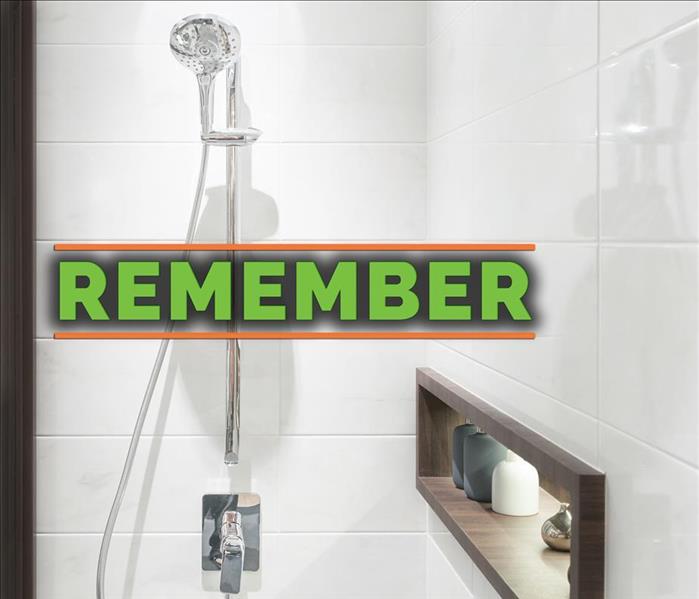 Remember to turn on ventilation fans in bathrooms to lessen mold growth
Remember to turn on ventilation fans in bathrooms to lessen mold growth
Facing Mildew in Your Shower Grout?
Bathroom mildew is a common but frustrating problem, and many Overland Park, KS, homeowners do not know how to get rid of it and save their showers. However, there are several different ways to clean up this pesky mildew. Here are a few options for cleanup:
1. Natural cleaners. There are a few natural options for cleaning mildew from your shower grout. Some substances you can try include vinegar, baking soda, lemon juice or a mix of some of these ingredients. You can find ideas for making mixes online - there are even some options for ongoing maintenance. Most techniques will require scrubbing of some nature.
2. Chemical options. There are many commercial cleaners that you can choose from to clean your bathroom mildew. Keep in mind that most contain strong smells and may require ventilation in the room where you are working. Common ingredients in these cleaners - which are usually antibacterial in nature - include alcohol, bleach and ammonia. As with natural cleaners, prepare to scrub your shower and follow any other special safety guidelines or instructions on the package.
3. Professional help. If you have a more severe, damaging mold disaster on your hands, or need help with an ongoing humidity problem, your local Overland Park, KS, residential mold restoration company should be able to help. They can survey the situation and either help you find a solution or create their own cleanup plan to rectify your mold problem.
Bathroom mildew is a challenge, but it is actually one that can be overcome successfully with the right tools and knowledge at hand. Try one of the options above; if the first one does not work out in your bathroom, move on to another, and always make sure to seek professional help for serious mold growth - your bathroom will be very likely to benefit.
SERVPRO: An Insurance Adjuster’s Best Friend
2/18/2019 (Permalink)
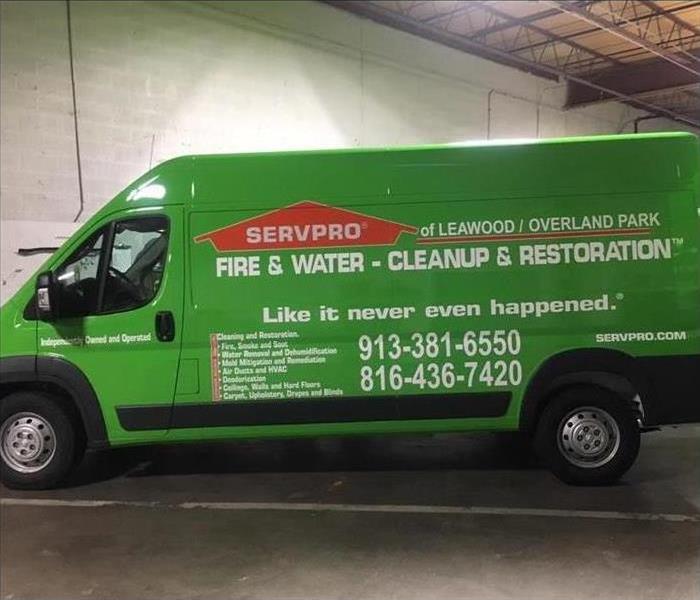 SERVPRO of Leawood/Overland Park is an industry leader in disaster mitigation and restoration
SERVPRO of Leawood/Overland Park is an industry leader in disaster mitigation and restoration
An Insurance Adjuster’s Best Friend
As an insurance adjuster in the Prairie Village, KS, area, you depend on the efficiency of others so that you can help move a client past a possibly traumatic event. SERVPRO is an industry leader in disaster mitigation and restoration and has the reputation to prove it. However, beyond reputation, this company has the coveted IICRC certification proving their knowledge and ability, but beyond that, there are several ways that this firm can serve you and your clients.
1. Immediate Response
SERVPRO is built on the premise of 24/7 availability. As an adjuster, you understand that quick response times for mitigation can mean the difference between a smooth insurance claim process and a difficult one. Properties must be boarded up, tarped and possibly even fenced off to ensure that sustained damage is not made worse.
2. Pretest
Additionally, pretesting ensures accurate estimates and assessments. An insurance adjuster understands that accuracy is everything, especially if it means the difference between condemning a property or repairing it.
3. Electronic and Inventory Services
Also, you will be provided with an itemized loss inventory by SERVPRO’s technicians upon completion of mitigation and clean out. This will be a digital excel formatted report with pictures to assist in the creation of a proof or loss statement.
4. Vendor Compliance
Any outside vendors working on your client’s home have also had to prove compliance with the company’s qualification standards. This compliance means that your clients will experience continuity of care and professionalism throughout their restoration experience.
As an insurance adjuster, you have enough on your plate with trying to assist clients through one of the most challenging times in their lives, the loss or damage of their home. You don’t need to be inundated with concerns of inaccuracies or unprofessionalism. Your clients don’t need to worry about the consistency of care or contractors that are not dependable. Seek out a restoration company that is IICRC certified and that holds their vendors to a hirer standard so that you and your client can rest assured that their home is in good hands.
How To Prepare for a Home Fire When You Have Pets
2/5/2019 (Permalink)
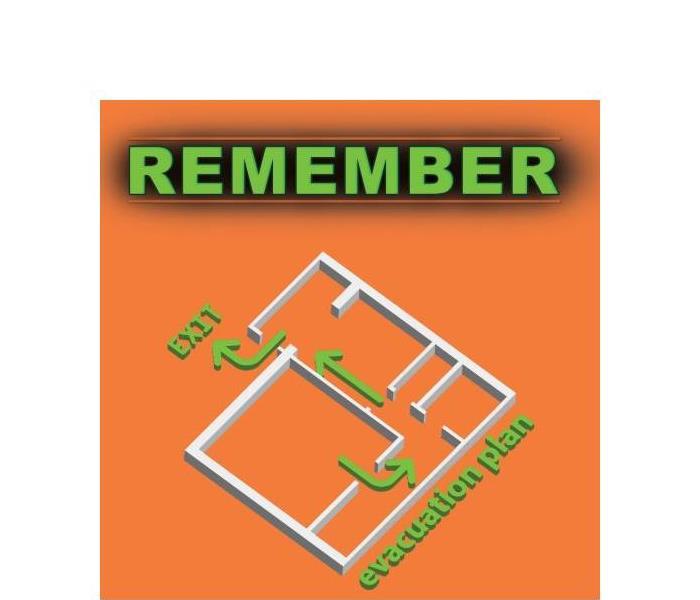 Remember to include your pet in your fire escape plan
Remember to include your pet in your fire escape plan
How to Prepare For a Fire Emergency
The thought of a fire in your home in Overland Park, KS can be scary, especially if you have pets. However, being prepared for the worst can help you react appropriately if a fire emergency does occur.
1. Take Precautions
Although not all fires are preventable, it’s often wise to do what you can to prevent a fire from occurring in your home by focusing on pet safety. If your pets roam around the house while you are away, making sure to keep away potential fire hazards out of reach from your pets can be helpful. Since not all fire hazards can be easily moved, it’s often best to keep pets in an area where they do not have access to potentially dangerous items while you are out of your house.
2. Make a Plan
Knowing how to react in the event of a fire emergency is important for everyone, but it’s especially important when you have pets. Make a plan of escape and know how to escape your home if your first route of escape is blocked off. After you have a plan, it’s useful to frequently practice this plan. If a fire does occur, having a plan in place can save you time and energy and can ultimately keep you and your pets safe.
3. Prepare Documentation
Part of pet preparation involves updating documents about your pets and keeping them in a fire-resistant container. If your pet does need veterinary care after a fire, having all of your pet’s documents in one place can save you a great deal of stress. Additionally, placing a sticker on a window at the entrance of your home that includes the number of pets in your home can be beneficial for firefighters when entering your home.
Taking steps to prevent a fire from occurring, making a fire escape plan and preparing documents that pertain to your pets can help you prepare for a fire. If a fire emergency has affected you and your home, it may be useful to contact fire damage restoration experts.
One Misstep in Your Vacation Planning May Result in Costly Damage
1/23/2019 (Permalink)
 A water leak caused to this property an amount of water damage
A water leak caused to this property an amount of water damage
When you plan a vacation, you stress over every little detail. You plan your flights so that you have enough time between connections to account for delays and terminal transfers. You pack one or two cold weather outfits even though you're going to the tropics, just in case. You fill your toiletries bag with vials of medicine, even though neither you nor any of your family members get sick very often. You're more than ready for a week out of the cold, or are you? If you haven't thought about the possibility of a broken pipe and preventing the need for a water pipe repair, you are not prepared.
7 Steps To Preventing Costly Damage
Frozen pipes often lead to extensive and costly water damage throughout the whole home. If an exterior pipe freezes, it can cause a backup in all your pipes. As the pressure builds up, it will look for a way to escape. Typically, escape involves finding weak spots in your pipes and bursting them. You can prevent this who process from happening by doing the following:
- Inspect all your pipes and water appliances for leaks, cracks or fissures. If you discover a weak spot, perform a water pipe repair with caulk or plumbers' tape.
- Check all the hoses on your washing machine, dishwasher, refrigerator, and other appliances. Unkink any kinks.
- Clear your gutters of debris.
- Examine your sump pump to ensure that it is in good working order. If you have the means, invest in a backup just in case your basement does become flooded while you're gone.
- Insulate exposed pipes and shut off the water supply to pipes that lead outdoors and that you're not currently using. Be sure to drain them as well.
- Have a friend, family member or neighbor come over to check on your home while you're gone.
- If no one can check on your home, turn off the water at the main. Drain the pipes and leave cupboards under the sink open to allow heat in.
When Your Pipes Do Burst
If your pipes burst regardless of your efforts, contact a Leawood, KS, water restoration team. You may also need to call in a plumber to perform an extensive water pipe repair.
Mold Prevention: 3 Common Sources of Excessive Dampness
1/23/2019 (Permalink)
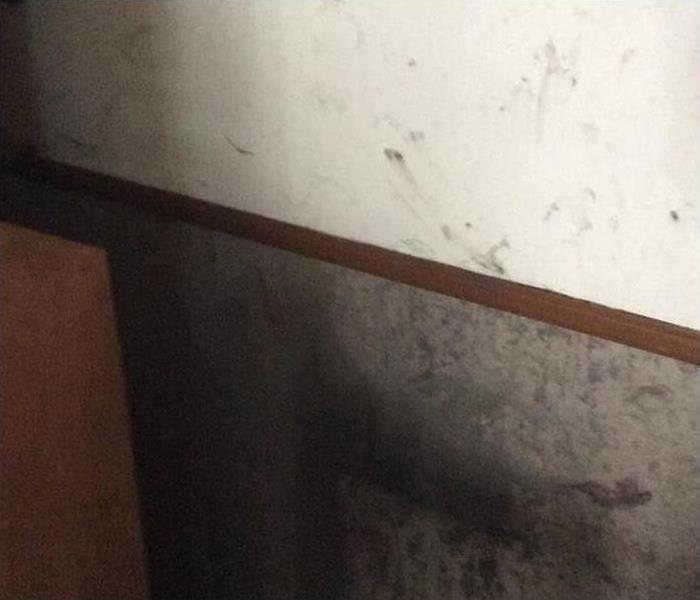 Mold can grow quickly, it is important to contact a professional for quick remediation
Mold can grow quickly, it is important to contact a professional for quick remediation
Dealing with mold in Prairie Village, KS, after it has already started to grow in your home is an extremely frustrating process. Your best line of action is to prioritize mold prevention and avoid the mess altogether! Since mold depends on water or moisture to survive, the key to preventing mold growth is moisture management. Here a few common sources of excess moisture to look out for.
Common Household Items
While people often think mold is caused by some severe issue within their home, sometimes the root of the problem is common household items they use regularly. Here are a few common culprits:
- Humidifiers
- Wet clothes
- Trash cans
- Household plants
Mold prevention starts with proper moisture control within your home. By keeping your humidifier at low levels, only using clothes lines outdoors, quickly taking out the trash, and not overwatering plants, you can help maintain optimal humidity levels in your home.
Leaking Pipes and Roofs
When left undetected, leaking pipes and roofs can cause serious water damage to your home that will quickly allow mold to grow. Regular maintenance and inspections of pipes in your home and your roof is essential for detecting leaks before they become a major problem. As soon as you notice any issues, it is a good idea to immediately get in contact with a water damage specialist.
Poor Ventilation
A poorly ventilated home traps moisture indoors and increases the humidity levels in your home. This is especially problematic in bathrooms and kitchens where large amounts of steam are released into the air on a daily basis. Using a bathroom fan or opening windows in is an effective way to let evaporated water escape from your home before mold can grow.
As you can see, mold prevention is a much simpler process than trying to combat mold that has already started to grow. While there are several causes of mold growth to look out for, checking out these common sources of mold are a great place to start!
3 Ways To Clean Contents After a Fire
1/11/2019 (Permalink)
 Soot damage in Overland Park, KS
Soot damage in Overland Park, KS
3 Ways To Clean Contents After a Fire
Even without catastrophic structural damage, a fire can wreak havoc on your property. From smoke damage, to water damage from firefighting efforts, there’s a surprisingly long list of ways that fires create a mess. The good news is there are lots of options for cleaning up your content, from elaborate fire restoration to simple dry-cleaning. Here are a few of the ways you can get your Overland Park, KS, property back to normal.
Fire damage typically evokes thoughts of broken windows and burnt through roofs. But fire damage also often includes:
- Smoke damaged clothing and personal property
- Water logged carpets and furniture
- Soot stained upholstery and carpeting
And that’s just for starters. Fortunately, there are professionals there to help.
Dry-Cleaning
This simple process is one of the easiest ways to handle smoke damage. Drapes and other fabrics can be dry cleaned in place to remove the pervasive smell of smoke, soot and burned goods as well as getting rid of stains. Be sure to choose a fire restoration or textile restoration company that specializes in fire damage for the best results.
Fire Remediation
This typically involves removing water - an important part of ensuring your business is safe for use. Water that gets beneath carpet pads and festers in walls can become a breeding ground for mold. Fire remediation firms use suction devices and industrial dryers to get rid of every drop.
Cleanup Services
Typically offered as an add on to remediation, cleanup services focus more on cleaning, deodorizing and restoring personal property. This can include spray and wipe cleaning, foam cleaning, abrasive cleaning, immersion and much more.
Cleaning up plays a big part of getting back to normal after a business fire. Fortunately, it’s not something you have to tackle yourself. Contract with experts in dry-cleaning, content storage and other fire content cleaning and your property will be as good as new.
Smoke Alarms: Maintaining Performance
12/26/2018 (Permalink)
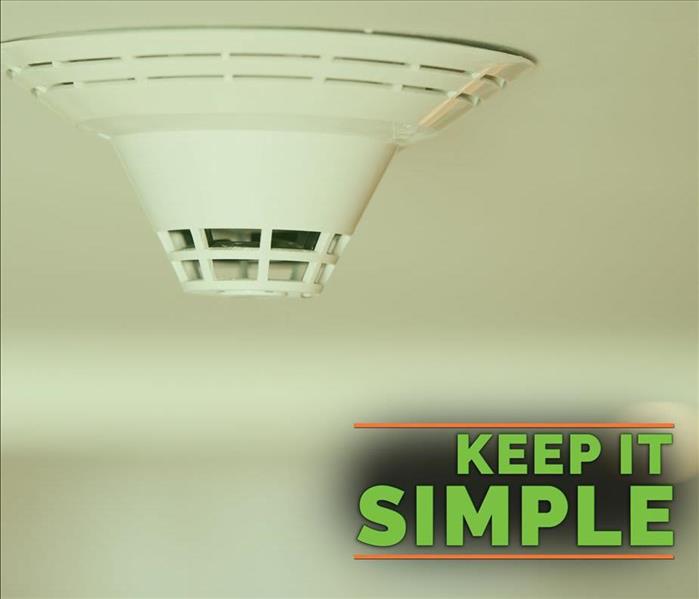 Contact a fire remediation specialist in the Leawood, KS area to get your alarm installed
Contact a fire remediation specialist in the Leawood, KS area to get your alarm installed
Smoke Alarms: Maintaining Performance
A smoke alarm may be the last defense you have to ensure that you and your family are safe in a disaster. Therefore, it is vital that all your alarms are correctly installed and regularly tested. If you are not confident in your ability to install these items, you can call a fire remediation specialist in the Leawood, KS, area who may be able to assist you. Beyond installation, you will want to ensure that you are maintaining you alarms appropriately. Depending on your chosen detectors, the maintenance schedule can vary.
1. Nine-Volt Battery Powered Detectors
As an affordable smoke detector option, nine-volt powered detectors will require monthly inspections and tests, you should make sure that the alarm is clean and free of debris, and you should test the signal by pressing the test button. Also, you should replace the batteries annually to ensure proper functionality. Additionally, it is recommended that you replace these alarms every 10 years.
2. Long-Life Alarms
A long-life smoke alarm typically refers to detectors that use a 10-year lithium battery. As these batteries should not be replaced, it is recommended that the entire unit is replaced in accordance with the manufacturer’s guidelines. However, you should test the alarm and ensure it is free of cobwebs and dust at least once per month.
3. Hardwired Fire Signals
Hardwired fire signals are connected directly into your homes electrical system, which provides an added sense of security because the units can communicate with each other, sounding alarms throughout the residence. This type of alarm should be tested monthly and replaced every 10 years. Additionally, the battery backup should be replaced annually.
Fire damage is one of the worst fears of many homeowners because of the risk to their property and the potential loss of life. A smoke alarm provides reassurance because it can alert and thereby protect a home’s inhabitants. However, depending on the type of alarm, each signal requires a certain amount of upkeep to maintain performance.
Explaining Certification Standards
12/26/2018 (Permalink)
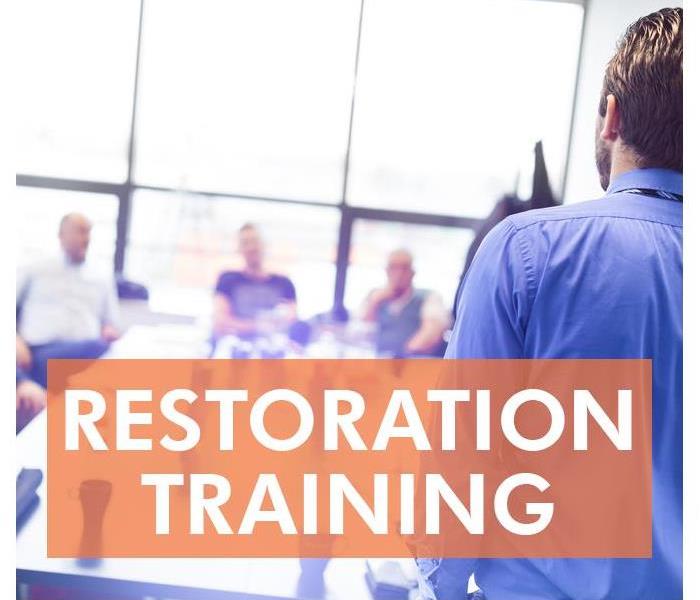 Our technicians undergo extensive water restoration training and certification through an IICRC approved school.
Our technicians undergo extensive water restoration training and certification through an IICRC approved school.
Explaining Certification Standards
If you find yourself in the midst of a water clean up scenario in Prairie Village, KS, the options can be overwhelming. Many professional restoration services exist to serve a variety of needs, but not all are accredited for the same tasks by the same agencies. The following information may help you choose the right company for your business restoration needs.
1. ANSI
The American National Standards Institute (ANSI) is an agency that manages and documents a large number of standards across a variety of professional disciplines. It is a non-profit entity and has no legally-binding authority. However, many of the standards originated from and maintained by ANSI have been adopted by local, state and federal agencies. Though conformity with ANSI standards is voluntary, compliance is frequently beneficial because it facilitates communication with consumers and other businesses.
2. IICRC
The Institute of Inspection Cleaning and Restoration Certification (IICRC) is one such ANSI member organization. This is the relevant agency for most water clean up situations. The IIRC standards cover a number of dependent domains, such as the relevant codes for flooring restoration, fire and smoke damage, mold contamination and many others.
3. BSR-IICRC S550
The BSR-IICRC S550 describes the standards for professional water damage restoration of commercial structures. This would be the bureau most relevant for the water damage that might result from a broken pipe in your place of business. If you are seeking a professional cleanup service to stop water retention and dry sensitive materials, compliance with this specific IICRC standard is likely the best way to gauge the capabilities of the company.
Navigating the maze of acronyms involved in selecting a water clean up specialist can be daunting, but the relevant information is fairly simple to obtain. Keep your business in order by understanding the standards that restoration services use to repair and replace the vital components of your property.
4 Potential Issues With a Partial Loss
11/28/2018 (Permalink)
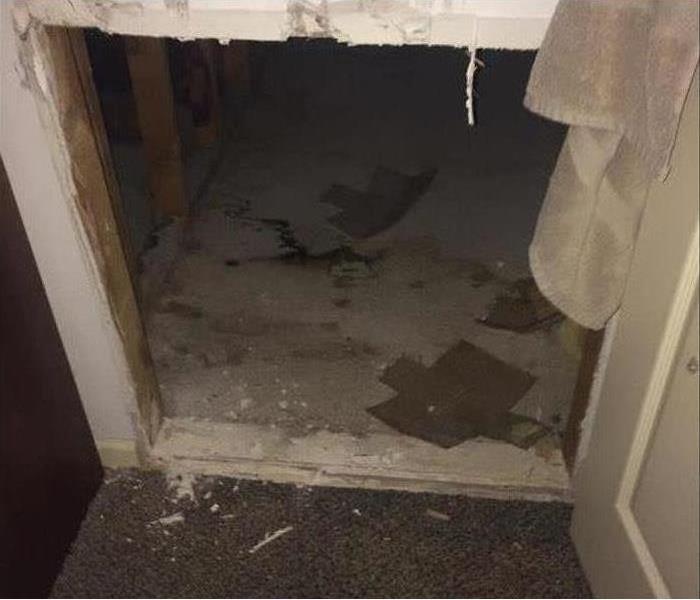 Aftermath of a fire in Prairie Village,KS
Aftermath of a fire in Prairie Village,KS
Restoration Process After Fire Loss in Your Building
Your building in Prairie Village, KS, doesn't have to burn completely to suffer a fire loss. That doesn't mean that restoration isn't needed, though. Even if areas of your commercial property are not burned, they can still show signs of smoke or soot damage or secondary damage such as mold. Any time you have a fire in your building, you need to stay aware of four potential problems with the restoration process.
1. Insufficient Cleanup
The first call you should make after a fire is to fire restoration experts. Don't just choose the first company listed, though. Do your homework and choose certified professionals with good reviews and a good service record. Shoddy repair is not much better than no repair at all.
2. Delayed Assessment
Even if you call experts for an assessment right after the damage occurs, it may take a while for your insurance adjuster to visit the site, especially if the company has other clients with more pressing issues. If this happens, you should still hire technicians to halt any ongoing damage to your building. Make sure to document the original damage with photos or video footage and an itemized list of everything that needed repair or replacement.
3. Additional Damage
A partial fire loss often leaves sneaky problems in the building. Make sure that you have air ducts and cabinets inspected for hidden smoke damage. It is also a good idea to have the area tested for mold growth, particularly if it sustained a lot of water saturation.
4. Unmatched Finish
Another benefit of hiring quality professionals is that they restore you property to a uniform look. This often involves replacing flooring, ceiling tiles, walls or wallpaper that wasn't damaged by the fire so that the whole room looks the same. A room with matching issues should not be considered a proper restoration.
Even if a small portion of your building is affected by the fire, you still must take repairs seriously. By treating a partial loss as a complete problem, you can bypass some of the common issues that occur when only part of your building is damaged.
3 Tips for Recognizing Mold
11/28/2018 (Permalink)
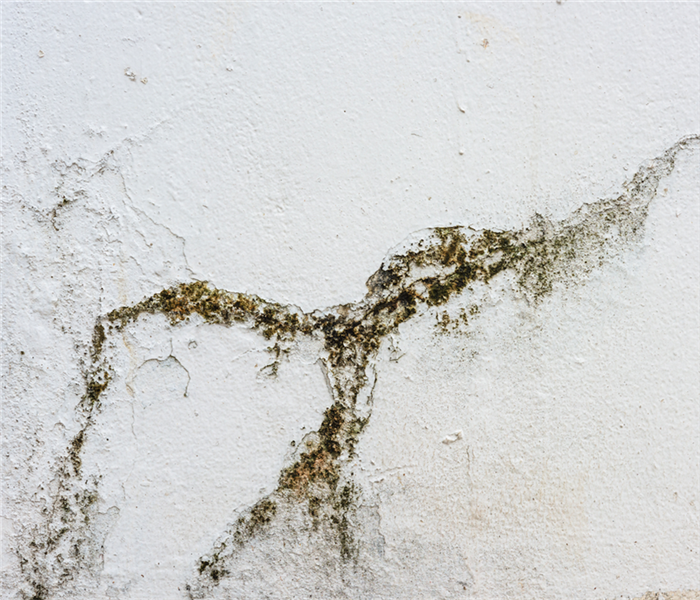 Mold on wall in an Overland Park, KS building
Mold on wall in an Overland Park, KS building
When it comes to your Overland Park,KS, business you want to make sure everything stays in top shape. This includes taking care of your company building as well, and may even mean calling an indoor environmental specialist to help make sure the property is free of mold. Here are some things they may look for when going over the building.
1. The Scent
Mold’s scent is probably one of its most distinctive features. Many would call it unpleasant or musty. An odor like this in a damp location may mean mold growth is a possibility. A mold remediation professional may be able to locate the source of the odor in order to find possible mold, even when none is visible.
2. Visual Signs
An indoor environmental specialist may also look for visual signs of mold. While most people think of green spotty patches, mold may also appear as white, grey, brown and even orange. Its texture also varies and early mold may look like mildew. The location and the length of growth time may affect the mold's appearance. A visual sign also includes the location as mold grows best where moisture is readily available.
3. A Mold Test
When in doubt a mold test can be performed to determine what type of mold, if any, is growing in an area. The type of test used can vary depending on what is being tested. There is a test for substances that are possibly surface mold, and a separate one to test for spores in the air. If looking at a ventilation system, a third method may be utilized.
With the help of an indoor environmental specialist you can rid the company property of mold, and also take the necessary steps to prevent future growth. Mold can usually be identified by scent and appearance, but when in doubt a test can be performed.
How To Handle a Flood Insurance Claim
11/13/2018 (Permalink)
 Call your agent to find out the type of damage covered
Call your agent to find out the type of damage covered
Flood Insurance Claim
When a storm causes flooding to your Leawood, KS, home, you may want to turn to flood insurance to help pay for some of the repairs. Not all insurance policies will cover flood damage. Before you start a flood claim, you should try to call your provider to find out if this type of damage is covered. Once you know that you can make a claim, follow these steps to make the most of the claims process.
1. Start the Cleanup
Flood damage can be severe. Starting the cleanup as soon as possible can help reduce the damage done to your home. The first thing you should do after a storm passes through is call a storm damage cleanup service. Because your insurance provider will want to know the extent of the damage, you should take pictures and keep records before any repairs are made.
2. Schedule the Adjuster
To start your insurance claim, you need to call your provider. Most companies will send out an adjuster to figure out how much damage the storm caused. Depending on the severity of the storm, you may have to wait a while before the adjuster can make it to your house.
3. Keep Damaged Materials
Did the flooding destroy carpeting or furniture in your home? Keep as much of the damaged items as possible, so your adjuster can see the damage firsthand. If you cannot keep something, at least take a picture.
4. Fill Out Paperwork
A flood claim usually requires a proof of loss statement. Your adjuster will assess all of the damages and create a list. You will then need to sign the proof of loss statement to indicate that you agree with the findings.
If you have a flood insurance policy, making a flood claim after a storm damages your home can help you afford the repairs. Knowing how to make a claim can make the entire cleanup process easier. Your cleanup professional may be able to help you with the claims process too.
How to Remove 2 Feet of Water From a Garage
10/19/2018 (Permalink)
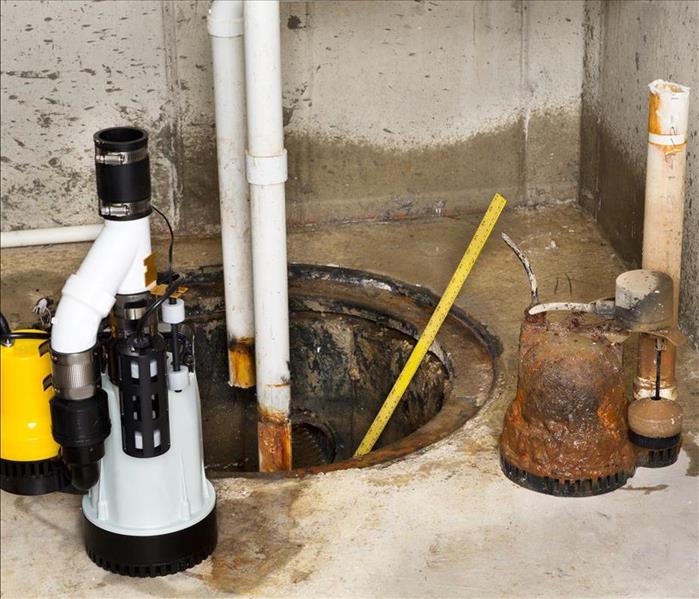 A sump pump can help you extract two feet of water in your commercial garage in Leawood,KS
A sump pump can help you extract two feet of water in your commercial garage in Leawood,KS
There are several equipment options for extracting two feet of water from a commercial garage in Leawood,KS. Learn about the differences between sump, trash, and truck-mounted pumps, and determine which of these three pump designs could be the best choice.
1. Sump Pump
A submersible industrial pump is a portable solution for removing flood water. These pumps draw water into a tank or container. Sump pumps can be ideal for commercial garages that are not convenient to access with a truck-mounted pump. These pumps may have bilge and ballast, centrifugal, or cantilever designs.
2. Trash Pump
Trash pumps are better suited for pumping up thicker liquids containing mud, silt, and debris than a sump pump or pump truck hoses. These pumps are typically heavy-duty centrifugal designs with deep impeller vanes and large discharge openings. A strainer on the end of the pump ensures that this equipment does not suck up debris that is much larger than leaves or twigs.
3. Truck-Mounted Pump
A pump truck is another portable solution for extracting standing water. This truck relies on industrial hoses to suck up water from a commercial garage or any other flooded location and transports this water to an appropriate disposal facility for black water from a flood. These pumps are particularly used for extreme flooding situations, and may be ideal for dealing with two or more feet of standing flood water.
These three pump solutions can remove standing water from a garage. The right pump depends on the accessibility and location of a garage as well as the quality of the flood water. While all flood water is considered Category Three black water, a large amount of debris or silt may call for a trash pump. Find out which pumping equipment is right for the job by scheduling a consultation with a storm damage restoration service in Leawood,KS.
3 Steps To Take When Making a Water Damage Claim
10/10/2018 (Permalink)
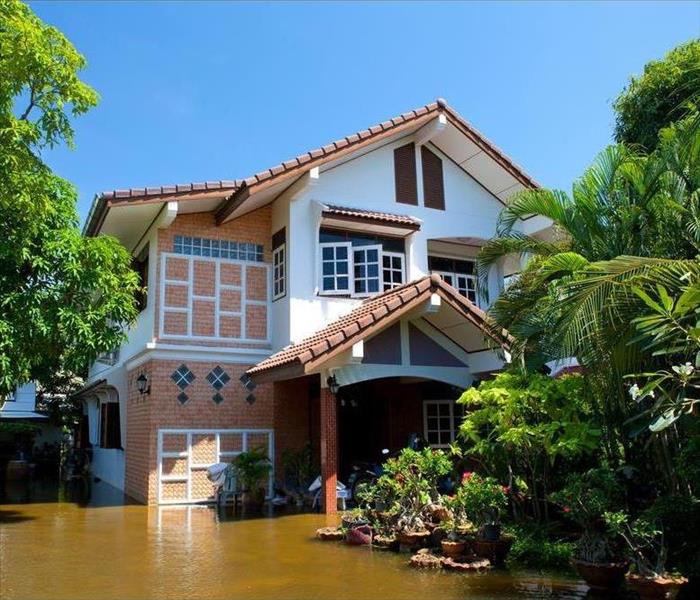 Flooding damage in an Overland Park,KS home
Flooding damage in an Overland Park,KS home
It can be hard to plan for flooding and how it might affect your Overland Park, KS, home. However, there are a few ways you can prepare in case an incident should occur. Knowing how to make a flood insurance claim is one way you can be ready to handle the damage, and there are a few steps you can take when the time comes to file.
1. Contact Your Agent
Once you and your family are safely out of your damaged home, it is a good idea to call your insurance agent right away. Let them know the details of the flooding, such as where it came from, how deep the standing water is and what you need to do in order to get your claim started. Your agent can advise you about whether you can file from your insurance app or if they need to send a claims adjuster out to evaluate the damage.
2. Take Photos
Documenting flood damage for your insurance claim can help you retain proof of what you file. However, it is important that you only take photos if you can do so safely. Remember to leave items as they are for the photos so your insurance company can help you estimate the cost of the damage before cleanup efforts begin.
3. Call in a Professional Restoration Company
Getting an opinion about what it will take to restore your home can help you create a viable recovery budget. Calling in a water damage and restoration company may be helpful, as they can advise you about any possible problems with structural issues or mold growth after a pipe burst or water line break causes deep standing water in your home.
Making an insurance claim after flooding affects your Overland Park, KS, home can be stressful. However, when you know which steps to take, the process may go more smoothly.
Protective Gear for Mold Remediation
9/14/2018 (Permalink)
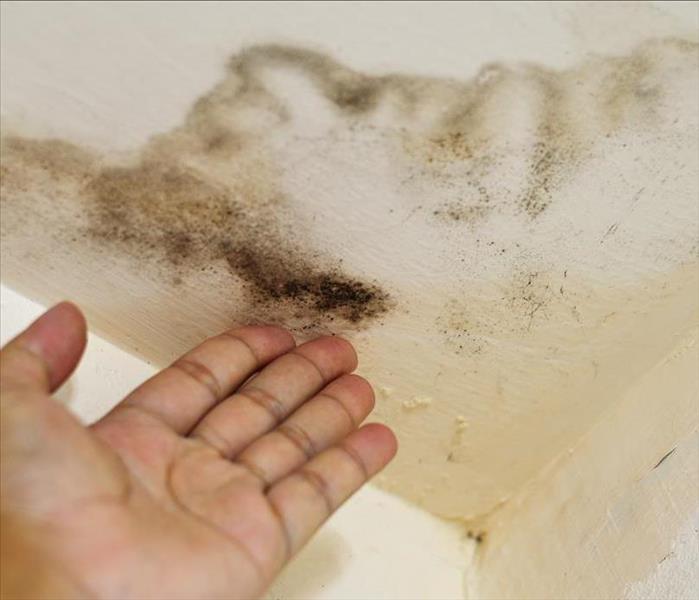 It is important to protect yourself when dealing with mold. It is best to call the professionals when remediation is needed
It is important to protect yourself when dealing with mold. It is best to call the professionals when remediation is needed
Mold is in the air all the time, but it is especially concentrated when you are in the process of remediating mold damage. While it is advisable to call in professional mold technicians when the area affected is larger than 30 square feet, you may decide to tackle smaller problems on your own. If you are cleaning mold in your home in Overland Park, Kansas, you can protect yourself from the extra spores in the air with face masks and other protective gear.
There are four main areas that need coverage the most.
Body
Before you begin to clean up the mold in your home, don clothing that covers most of your skin. It needs to be clothing that is washable. As soon as you are through cleaning, undress and wash what you were wearing immediately so that the spores that attach to your clothing don't multiply.
Nose and Mouth
Face masks cover your breathing passages, improving the quality of the air you actually take into your body. A mask with a respirator is an important piece of protective equipment that filters out the spores, trapping them before they get to you.
Eyes
Goggles are necessary to protect your eyes. Eyes can be sensitive to any irritant, including dirt, hair and mold. Keep spores away from your eyes by putting goggles on before you start cleaning.
Hands
Although your hands are going to be doing most of the work, you may not think of needing to protect them. After all, you can just wash your hands thoroughly after the cleaning is done, right? On the contrary, it is important to avoid contact with mold if you can. Gloves help protect your hands and forearms from mold while you scrub.
Face masks, goggles, gloves and other protective gear are necessary when you are cleaning up after mold in your home. Follow the example of remediation professionals and dress appropriately.
6 Things to Never Do After a Flood
9/14/2018 (Permalink)
 Floods are dangerous. Once waters recede and it is safe to return home, call the professionals for help cleaning up
Floods are dangerous. Once waters recede and it is safe to return home, call the professionals for help cleaning up
If you're dealing with a flooded home, it's understandable that you want to act fast to minimize damage. While it is correct to address it fast, you need a professional in water remediation and restoration. Flood water cleanup must be done with great care, otherwise you risk causing more harm to both your home and yourself. Your local flooded remediation team shares a few tips for what NOT to do post flood:
- Do NOT stay in your home if actively flooding
- Do NOT wade into standing water
- Do NOT touch the water
- Do NOT forgo protective gear
- Do NOT forget to call your insurer
- Do NOT forget to call your Overland Park, Kansas, water damage restoration team
It is important that you don't do any of the above, as failure to listen to the professionals could put you, your home, or your loved ones in harm's way.
Get Out of the House and Away From the Water ASAP
Depending on where the flood water came from, it could be contaminated with human feces, chemicals or other harmful materials. For this reason, you should never go anywhere near the water, let alone touch it. Ideally, if you can, get out of your home as fast as possible and call for help.
If You Must Stay in the Home, Wear Protective Gear
While you should not attempt cleanup efforts on your own, if you plan to stay in the home, make sure you're equipped with all the right protective gear. Protective gear you will need includes: flood boots (which may protect you against electrical shocks), full-body suit, gloves, and a face mask.
Contact Insurance Provider & Restoration Company
In order to be reimbursed for the water damage caused by a flood, you need to contact your insurance provider immediately. Insurance will need a projected cost of the water remediation and restoration. We offer estimates and will coordinate with insurance to ensure that the process is handled fast and efficiently so your home can return to normal. The faster you take action in contacting your insurance agent and restoration team, it could minimize damage and therefore the costs of restoration.
How to Handle a Burst Pipe in a Commercial Building
9/14/2018 (Permalink)
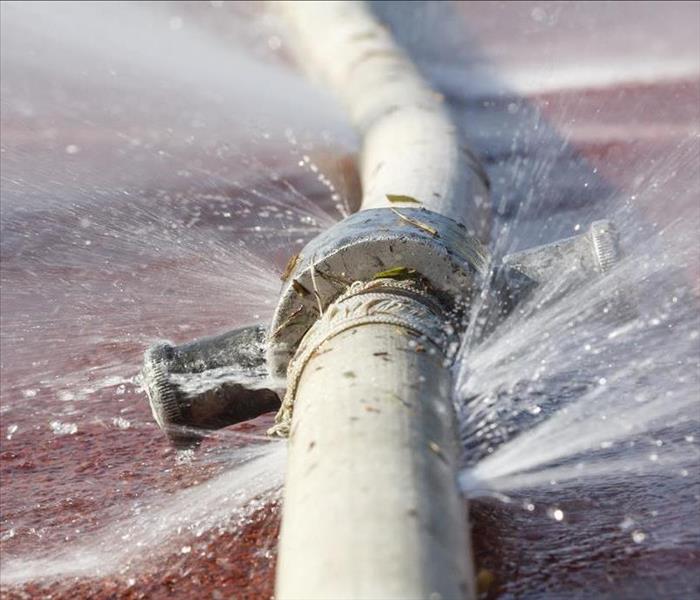 Pipes burst for many different reasons, be sure you know who to call when it happens to your business.
Pipes burst for many different reasons, be sure you know who to call when it happens to your business.
After a pipe burst in your building, whether sewer or water line, there are individual steps you may want to take to prevent any further damage.
Below are six of the most common cleaning and damage tips to use prior to full building restoration.
Ensure Personal Safety
Before any cleaning tips, it is crucial that you and anyone working in the flooded area take certain safety precautions. As the type of water you will be dealing with is likely unknown, you may want to use water repellent gloves, coveralls, and rubber boots. It is also a good idea to wear eye protection.
Shut off Main Power
After a flood from a burst line, it is a good idea to shut off the main power. While your building may not have power, it does not mean that electricity has stopped moving through outlets and other appliances.
Create a Photographic Record
In the plethora of damage tips out there, the tip to make a photographic record of the damage sustained is a good one. Pictures allow you to prove loss to insurance companies, thereby making the claims process a little easier.
Mitigate Further Damage
Another important tip after a burst pipe is to mitigate further damage. In an effort to protect your building from further devastation, you may want to shut off the water supply to your building to stop any further flooding.
Remove Water and Damaged Material
Once you take the above precautions and steps, you can begin removing any excess water using wet vacs and pumps. In addition to the removal of water, you can discard any damaged materials, like carpeting and drywall.
Dry out Facility
After the facility is free of water and damaged goods, you can begin the dry out phase. If you want to streamline this process, you can use dehumidifiers, industrial fans, and other air movers.
While the damage tips above may seem daunting, they are necessary to restoring operation; however, if the process of water damage cleanup seems too much, you can check with the Leawood, Kansas emergency management office for further tips and assistance.
Post-Fire Water Damage: What You Can Do
8/23/2018 (Permalink)
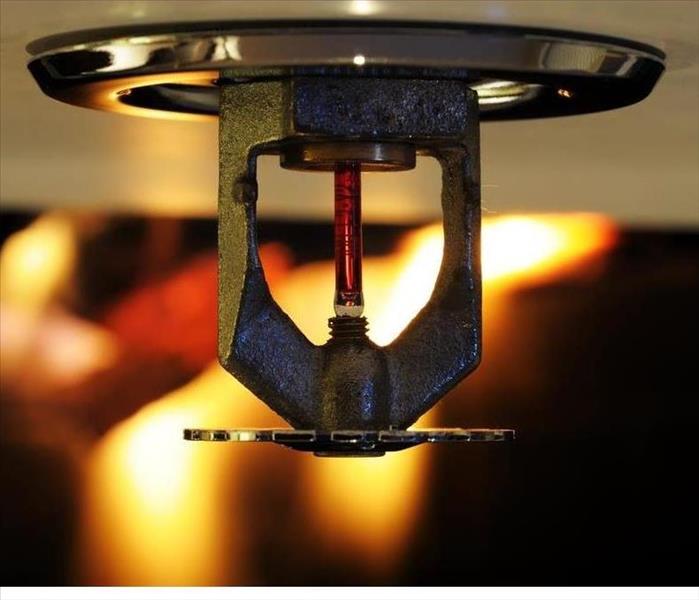 Water damage is bound to make you emotional when your company and belongings are at stake.
Water damage is bound to make you emotional when your company and belongings are at stake.
If you recently experienced a fire at your business, you are probably already dealing with smoke cleanup and fire cleanup. You may be frustrated and surprised to find that you are also dealing with water cleanup. What causes water damage after a fire and what can you do about it? Read on for information and helpful advice so you can better understand what your options are.
Causes of Water Damage
There are a number of sources of pre- and post-fire water that can cause damage to your Leawood, KS, commercial building. They may include:
• Firefighters’ hoses
• Fire sprinklers going off
• Utilities that were damaged by the fire
• Other water used to put out the flames
While many of these sources are necessary to put out fires, they can also cause damage to your property and even lead to mold and other complications of sustained indoor moisture. Fortunately, you can take action to mitigate the situation.
Water Cleanup Solutions
A fire and water restoration service in the Leawood, KS, area will be your best bet when facing water damage and other fire destruction. Technicians with experience handling water damaged structures and items will know how to help you get your business back in top shape and may even be able to help you restore otherwise unsalvageable items, such as photographs. They will also know how to handle mold contamination and similar water-related matters.
Don’t Get Discouraged
Water damage is bound to make you emotional when your company and belongings are at stake, but it is best to try to step back and look at the situation as calmly as possible. Knowing that you have a solid water cleanup plan in place will help you stay positive and realize that you will most likely be able to restore most of your property and even many of your and your employees’ personal items and get back to business as usual. For more information, visit http://www.SERVPROleawoodoverlandpark.com/.
Avoid Mold Growth Due to Winter Flooding
7/23/2018 (Permalink)
When it's warm outside in Overland Park, KS, it's easy to forget about the risk of frozen pipes, but this is the best time of year to prevent winter flooding. Protect your pipes from freezing by learning to recognize the risks, taking preventative steps, and how to respond when pipes do freeze. Some of the most important reasons to prevent winter flooding are the risks of mold growth and property damage.
Freezing Water Expands.
If you've left a cold drink in the freezer a little too long, you've probably experienced the results of water expansion. No matter what type of container water is in, when it freezes water expands and there's a tremendous amount of pressure on the container. Even metal pipes can break, leading to flooded basements and the risk of standing water where bacteria can grow. Watch out for:
• Pipes exposed to extreme cold, such as outdoor hose bibs, water sprinkler lines, and swimming pool lines
• Water supply lines in unheated areas, such as the attic, basement, garage, kitchen, or crawl space
• Pipes running along exterior walls where there's little to no insulation
Keep Things Warm.
There are several things you can do to prevent your pipes from freezing. Once you've located problem areas, you can add insulation to the pipes. Protect them from cold weather as much as possible. For example, keep the garage doors closed to retain some of the home's warmth and open kitchen and bathroom cabinets to let warmer air circulate around the pipes. When the weather is very cold, let a bit of cold water run through the faucets. The running water will prevent the pipes from freezing. During especially severe cold snaps, leave the thermostat set to daytime temperatures at night and even when you're away from home.
Call a Professional.
Finally, if pipes have frozen, contact a professional for help. While waiting for a response, leave faucets open to allow water to flow through the pipes and use a heating pad or space heater to warm the pipes. An immediate response is the best way to avoid flooding and mold growth.
For more information, please visit us at http://www.SERVPROleawoodoverlandpark.com/.
5 Tips To Prevent Kitchen Fires
7/16/2018 (Permalink)
In 2016, 50% of house fires in the United States were caused by cooking. As a homeowner in Overland Park, KS, follow these five helpful tips to reduce the chance of fire damage in your kitchen:
1. Pay Attention.
Be attentive to your cooking and do not leave it unattended, even for a few minutes. If you must leave the house, turn off the oven first. Regularly check on the food, especially if you are frying, broiling or grilling. If you are not in the kitchen, set a timer so you know when the food is done. Double check that appliances are turned off before heading to bed.
2. Reduce Fire Hazards.
Move anything that is flammable away from heat sources in the kitchen, especially those that generate open flames. This includes dish towels, pot holders, grocery bags and long sleeves or hair when cooking.
3. Clean Surfaces.
Over time, grease and oil residue build up. Regular cleaning is one of the best tips to prevent a grease fire. If a grease fire occurs, never put water on it. Rather, cut off the oxygen to the flames by covering it with a pot or pan.
4. Take Precautions.
The kitchen is no place for small children while you are cooking. Teach your kids to stay at least three feet away from the oven for safety.
5. Be Prepared.
Protect your home by installing a working smoke detector in or near your kitchen, and on all levels of your home. Check the batteries and test the device on a regular basis. Keep a fire extinguisher within reach to combat small fires in early stages.
Follow the above tips to decrease the risk of fire in your home. Sometimes even taking precautions cannot prevent a fire in Overland Park, KS. If this happens, immediately get your family to safety and call the fire department. After the blaze is out, contact a fire restoration specialist and your homeowner’s insurance agent to learn about your next steps to restore your fire damaged home.
For more information, please visit us at http://www.SERVPROleawoodoverlandpark.com/.
What Happens During Mold Remediation?
7/11/2018 (Permalink)
Many people worry about black mold, but any mold inside of a building is bad news. Molds feed on organic building material, such as cellulose in wood and paper, and during the digestive process, some molds make odorous byproducts known as mycotoxins. Here are the basic steps for remediation so you know what to expect for your facility in Overland Park, KS.
Basic Steps for Mold Remediation.
1. Stop the source.
When you find black mold, or any other mold, stop the source of the moisture and call immediately to schedule remediation work. A professional restoration company will be available for your emergency any time of day or night.
2. Inspect.
Professionals may use detection equipment to help find mold or water damage that can't be seen with the naked eye. This ensures thorough cleaning to reduce spread of infestation.
3. Prevent the spread of spores.
Personal safety and prevention of additional contamination are key priorities for remediation specialists. Prepare for all ventilation and HVAC systems to be off during cleanup. Negative air pressure and barriers may be used to create a containment area that reduces the spread of spores during mold cleanup. HEPA vacuums and air scrubbers are also used to contain spores during the process.
4. Removal of contaminated materials and mold remediation.
When black mold digests organic food sources, those materials are destroyed. Specialists are able to assess which materials can be cleaned with biocides and fungicides, and which must be replaced.
5. Cleaning of personal items.
There are many different ways to clean items depending on the type of materials involved. Some paper documents are critical to your business, and there are several processes that can be used specifically for document drying. Specialists will determine if your documents can be restored and which method is best.
6. Restoration of Structure.
Repairs, such as replacing some drywall and painting, or full replacements of structural material will be completed.
When it comes to running a business, downtime during a major cleanup process costs you additional money in lost work. Counting on professionals for mold remediation can get you back to work faster.
For more information, please visit us at http://www.SERVPROleawoodoverlandpark.com/.
Can Old Buildings Be Free of Pipe Problems?
6/20/2018 (Permalink)
If you own an older commercial building in Overland Park, KS, chances are you are aware of the increased risk your property has for problems. Old buildings are known for the following issues:
• Bad roofs
• Broken pipes
• Faulty electrical
Many buildings built between 1978 and 1995 were filled with polybutylene pipes. This plastic resin was thought to the be piping of the future, but today many experts believe it may be prone to burst pipes and other issues. If your building has these potentially failing pipes, can it be free of plumbing issues?
Regular Maintenance.
Regular maintenance of your plumbing can help you avoid water damage caused by broken pipes. Polybutylene piping becomes weaker when it is exposed to certain oxidants. The inner parts of the plumbing may become brittle and start to flake. If you do regular cleanings, you may be able to determine if your pipes are starting flake and weaken.
Annual Inspections.
If you have a rental property, you need to worry about your tenant's property as well as your own. You can hire a plumbing company to annually inspect your pipes. This inspection can help you locate hidden leaks and other potential problems before they grow into major floods. Having an annual inspection can also warn you if your system is starting to fail. If problems seem imminent, you may want to contact a commercial water damage restoration team for help.
Proactive Replacements.
You can ensure your building is free of major flooding caused by faulty plumbing by replacing the pipes. This can be a huge undertaking, but it may save you a future headache. If a pipe does burst, you may have to take care of more damage than if you simply replace the pipes now.
Polybutylene piping can last for a long time in your old commercial building or fail tomorrow. With this uncertainty, you need to be ready for anything and do what you can to take care of your plumbing.
For more information, please visit us at http://www.SERVPROleawoodoverlandpark.com/.
Why Choose a Water Mitigation Company?
5/29/2018 (Permalink)
Once you have made arrangements for someone to come and begin the water damage and the flood damage mitigation, a high-speed pumping system will be set up to remove the standing water to the outside or to a tank truck. It won't take very long to remove water with this system, probably just a few years.
When all of the standing water has been removed, a drying process will begin by using large industrial fans to create air movement over the entire area that was flooded. This is also a part of water cleanup process and it might take three or four days for it to be completed. When the drying process has been completed by the air movement then the fans are removed and the next part of the water cleanup can continue.
SERVPRO of Leawood / Overland Park will be there to help you clean up the mess of water damage.
What Do You Need to Do When You Have a Mold Emergency
5/15/2018 (Permalink)
Mold damage can sneak up on you. Sure, your Overland Park, KS, home may show some early signs of mold growth, but as someone unfamiliar with this fungus, you may miss the initial clues. By the time you realize what you’re dealing with, the fungus may have spread to large portions of your house. Whether you find mildew or black mold growing in your residential space, you need to take quick action to ensure this mold emergency is taken care of.
Calling in a local remediation team should be your first step. These experts can help you make sure everything is done correctly. In case they can't get there right away, keep these tips in mind to address your mold emergency immediately.
• Stop airflow. Mold spores can hitch a ride in the air to get to new parts of your house. When you notice a patch of black mold, you may need to turn off your HVAC unit to make sure the spores can’t spread to new areas.
• Turn off water. A moisture problem may be the cause of your sudden catastrophe. If you want to get rid of the fungus, you need to cut off the water supply. If you have a leaky fixture or a burst pipe, you need to turn off your home’s water until the damage can be assessed.
• Schedule an appointment. Plumbers and mold cleanup crews may have busy schedules. Even if no one can make it out to your home today, you still want to get an appointment on the books. Call the professionals you need for your emergency and make an appointment as soon as possible.
Black mold can be a major problem for your Overland Park, KS, home. Depending on when you find this growth, you may already be in the throes of an emergency. Acting quickly can help you clean up your house and make it livable again.
How to fix water damage in home?
5/4/2018 (Permalink)
If you have a water loss in your home, it is important to understand how to get it cleaned up and dry before secondary damages happen.
SERVPRO is a great resource, even if you are not sure of what to do. They can come out and do a walkthrough and give you a detailed scope of what is needed to do.
In most cases, the water needs to be extracted. If the water sits for too long, it can begin to cause mold to grow and other microbial growth.
Once all of the water is removed, drying can begin. SERVPRO has plenty of drying equipment to handle any-size loss, big or small.
After the drying is complete, SERVPRO's team can help put back all the damaged materials that could not be saved.
If you have any questions, feel free to reach out at anytime.
What does it cost to repair water damage in an Overland Park home?
5/4/2018 (Permalink)
If your home has a water loss, and you are unable to handle the cleanup and drying on your own, you will probably have to hire a professional restoration company like SERVPRO of Leawood/ Overland Park.
We often get asked how much will it cost, and that is not something we can answer on the front end. SERVPRO uses industry software that has set pricing that is used by multiple companies and known to the insurance companies.
However, SERVPRO will do it's best to minimize the damage through mitigation and responding as quickly as possible. In any water loss, the sooner the source is eliminated and the water is removed with drying, the lower the cost of the job will be. If the water begins to sit, it can get more expensive by the hour. (Due to water spreading and wicking up walls.)
How can you tell if a home has had water damage?
5/4/2018 (Permalink)
If you are in the market for a new home, it is important to be aware if there has been any previous damage due to water in the home. Sometimes the damages from water can be inside the wall or in other hidden areas of the house. It is extremely important to have a solid home inspector evaluate the home before closing.
However if you are not confident in the home inspection, we recommend having a professional restoration company like SERVPRO, come on site and do a closer look. They have equipment that can detect temperature changes behind porous structures in the home.
If you have any questions, you are welcome to call us anytime. We are happy to help answer and educate you with any concerns you might have.
You’ve Got Mold. How Long Will It Take to Remove?
4/27/2018 (Permalink)
Maybe it started as some black spots on the wall after a particularly heavy rain. Maybe there was an alarming, musty smell. Maybe a building inspector noticed it on an annual walkthrough. Regardless of how the mold was discovered in your Overland Park, KS commercial building, it needs to be remediated, and the sooner the better. How long should you expect mold removal to take?
Mold is everywhere in our world, and no building can be completely mold free — mold spores can blow in through doors or be carried in on shoes. Most spores remain isolated or are removed by filtration systems, but if there is unchecked dampness in a building, mold types, including black mold, may take hold and begin to colonize. The longer it takes to notice, the more extensive the mold growth may be and the longer it will take to remediate. In general, mold removal takes between three and seven days, depending on how extensive the contamination is.
Getting Rid of Mold, Step by Step
If the mold contamination is extensive, the following steps may be necessary:
- Installation of mold containment equipment, including negative air chambers, physical barriers and negative air pressure systems
- Installation of air filtration equipment to ensure that mold is not recirculated into the building
- Application of antifungal and antimicrobial treatments
- Removal of contaminated materials, including carpet and drywall
- Cleaning of furniture and other items affected by mold
- Replacement and repair of building materials removed during the above processes.
Remaining Vigilant About Moisture and Mold
No matter how long it takes, mold removal and remediation isn’t something you want to have to do twice. Give the professionals time to do it right the first time, and when they have gone, remain vigilant. Keep porous surfaces as clean and dry as possible and watch carefully for any signs of unchecked moisture or new mold colonies.
For more information, please visit us athttp://www.SERVPROleawoodoverlandpark.com/.
3 Ways an Emergency Profile Can Save a Business
4/25/2018 (Permalink)
Owning a business is usually the result of countless hours of hard work and plans finally coming together, and though owners are experts on their own businesses, they are often unprepared in the event of an emergency. However, businesses don’t have to face emergencies alone. Having an emergency profile can be the difference between closing a business permanently and reestablishing a business after a disaster.
1. Consolidates Information
When a flood destroys businesses in Overland Park, KS, the last thing business owners want to do is scramble to gather specific information about their locations. A local SERVPRO representative can help owners create their emergency profile, which can be accessed anywhere using the ERP app, which stands for Emergency Ready Plan. Instead of wasting time that could be spent rebuilding their business making phone calls and digging through papers, business owners can easily access everything they need in one place.
2. Saves Money
Every day that a business remains closed, money is lost. Once the environment has been deemed safe, business owners with a plan can know exactly what to do next. With a named dedicated franchise professional to handle each case, businesses with plans can reopen quickly, unlike half of the businesses without plans that are unable to recover.
3. Offers Reassurance
Instead of counting on luck and hoping their business is spared from disasters, business owners with plans in place can trust that qualified professionals are ready to assist them. A profile goes over critical information; contact information, priority areas, shut-off valves and other facility details; facility assessment and line of command. Having these items planned out means business owners can get to restoring damage immediately.
Nobody wants their business to be affected by a disaster. However, an emergency profile with help from SERVPRO can ensure that businesses remain prepared. In an emergency, businesses can rebuild and thrive once again.
For more information, please visit us athttp://www.SERVPROleawoodoverlandpark.com/.
What to Do if your Pipe Bursts
12/19/2016 (Permalink)
If you are unfortunate enough to have a burst pipe, follow these steps:
- Turn off your water supply at the main valve. Your main water valve can be located in a variety of places. If you have a home with a basement or crawlspace, it is probably located on an interior wall near the front of the house. In this case, it is most likely hiding in plain sight. If your home was built on a slab, the valve might be located near the hot water heater or inside your garage. It may also be located in an underground cement box near your front curb. To learn where your main water valve is, consult you property inspection report or call your local utility company or plumbing professional. Learn more tips for locating your main water valve here.
If the burst pipe is a hot water line, make sure to also turn off the water valve at the top of your hot water heater.
- Once you have turned off the main water valve, call a plumber.
- If your water meter is frozen, contact your local Water Department.
- If your broken pipe has caused water damage to your home or business, call SERVPRO of Clay County to dry it out before it ruins materials and they need to be torn out.
Look Who's in the News for Water Damage Cleanup!
8/31/2016 (Permalink)
Our franchise is in the news! We are helping clean up water damage and flooded basements after these heavy storms. Check it out!
http://www.kmbc.com/news/crews-help-homeowners-with-flooded-basements-after-storms/41424038

 24/7 Emergency Service
24/7 Emergency Service

























































































































